
Home » Travel Guides » Afghanistan » 15 Best Places to Visit in Afghanistan

15 Best Places to Visit in Afghanistan
Landlocked and languishing at the crossroads of south and central Asia, Afghanistan has been carved up and altered by countless peoples. In the days of the ancients, Neolithic tribespeople arrived here from the Indus Valley. Then came the phalanxes of Alexander the Great, ranging over the greater phalanx of mountains that is the Hindu Kush to end the Persian dynasties of old. Then there were the Muslim Arabs of the Middle East, who met with the unstoppable forces of Genghis Khan. And then there were the Mughals, the Soviets, the British imperialists – the list goes on, and on.
Today, the fabric of this vast country in the depths of Asia is a palimpsest of its tumultuous past and awesome location: Cities like Mazar-e Sharif and Kandahar are filled with filigreed mosques and breathtaking madrasahs; ancient trading routes cross opium fields; the dusty desert gives way to snow-capped peaks and alpine glaciers. Of course, modern times have not been so kind, and today the war-torn territory of tribes and Taliban is pretty much out-of-bounds.
Lets explore the best places to visit in Afghanistan :
1. Kandahar

The revered home of the Mosque of the Sacred Cloak and a city steeped in history, Kandahar sits at the crossroads where southern Afghanistan meets the mountains of the country’s heartland.
The traditional seat of Pashtun power, it was the capital of the last Afghan empire during the years of Ahmad Shah Durrani.
Today, the place is filled with mosques, shrines, and mausoleums to luminaries from the national past, and folk come to see the curious inscriptions of the great Mughal invader Babur on the Chilzina View, located just on the edges of the city.
2. Mazar-e Sharif

The cobalt domes of the great Blue Mosque shoulder their way above the skyline of Mazar-e Sharif, glowing white-hot under the scorching Balkh sun.
Famed as the burial site of Ali bin Talib, the cousin of the Prophet Mohammad himself, it’s a gorgeous array of arabesque and south Asian architecture, complete with turquoise-blue domes and gold-peppered minarets.
However, the Muslim history is just one aspect of Mazar-e Sharif, because this city is also home to countless Greek relics; ones that found their way here with the coming of Alexander’s armies in the 3rd century BC!
3. Jalalabad

Founded – like so many other cities in these parts – by the emperor Akbar, Jalalabad is a place where the passage of ancient time is virtually palpable.
You can often just about make out the snowy peaks of the Safid Mountain Range on the horizon, and imagine how the Mughal armies would have felt as they contemplated them way back in the 1500s.
Closer to the city and the climate allows for citrus orchards and green parks – something Jalalabad is known for.
You can also see the mausoleum of King Amanullah Khan, join the locals for hotly-contested cricket game, or just enjoy the manicured parks and gardens.

Hailed as the epicenter of the Bactrian Empire of old, the aged town of Balkh has a history going back almost 4,000 years! In fact, it was here, high up in the gaps of the northern ridges of the Hindu Kush, that Zoroastrianism and Buddhism first flourished in these reaches.
By the time the Venetian adventurer Marco Polo arrived in the 1300s, the town would have been razed (even by Genghis Khan himself) and rebuilt many times, but memories of its great fortification walls and learning institutions would still have been ripe.
Today, the town is hardly the noble capital it once was, but there is a certain palpable history to be found amidst the buzzing bazaars and emerald-hued Green Mosque.

It’s easy to see why Herat – the third-largest city in Afghanistan – has such a Persian flavor to it: the town sits just a stone’s throw from the Iranian border, and it was once the home of the Timurid dynasty (a lineage that fused elements of Turkic, Persian and Mongol culture in their time). The great piece de resistance of the city is The Friday Mosque.
This elegant structure of turquoise-tipped minarets and shimmering tiles is sure to wow the senses – it’s thought to be more than eight centuries old! There’s also the Herat Citadel to see, and the tombs of revered Sufi poets.
6. Samangan

While the town of Samangan is an ancient caravan stop on the periphery routes of the old Silk Road, that claim to fame isn’t actually it’s major draw.
That honor goes to the mysterious cave complexes of Takht i Rostam that carve their way through the dusty ridges of the mountains nearby.
These are thought to have been built in the 4th and 5th centuries AD, and are adorned with gorgeous Buddhist inlays of lotus leaves, all focusing on an inner mud-brick stupa.
They offer an immersive glimpse into an almost-forgotten, pre-Muslim past.

For lovers of culture and religious history, the Bamiyan story is a very sad one.
In ancient times, the place was known as a hub for Hindu–Buddhist worship, and it thrived with artisans, monasteries and – especially – sculptors in the ages before the Muslim invasion.
In fact, the two giant statues of the Buddha that stood here were considered some of the most elegant 4th and 5th century carvings in all of Asia.
In March 2001, however, these great effigies were destroyed by the Taliban, causing international outrage, and even prompting UNESCO to tag their remains to prevent further destruction.
8. Faizabad

Backed by the cracked and chiseled passes of the mighty Hindu Kush, Faizabad sits hidden its very own remote enclave of the northern Afghan mountains.
The location is what defines the town: giving it that rustic, backwater feel.
You’ll see galumphing donkeys strutting the streets and beady-eyed, bearded sheep farmers wandering the bazaars.
You’ll meet local highlanders with feet worn by the trails of the great Wakhan Corridor.
You’ll find spice-scented stew houses and be able to explore the gorgeous alpine valleys of the Kokcha River.
9. Band-e Amir National Park

The breathtaking reaches of the Band-e Amir became home to the first ever national park in Afghanistan back in 2009. It’s easy to see why too! Peppered by no fewer than six individual mountain lakes, perched more than 3,000 meters up in the rugged peaks of the Hindu Kush, and forged by millennia of fascinating geological movements, the whole area is a wondrous place to behold.
Hikers come in the spring and summer (when the temperatures are not an unbearable 20 Celsius below!), to wonder at the cobalt-blue waters of Band-e Panir and the Band-e Gholaman.

Kabul has been plunged in chaos since the takeover of the Mujahedeen and al-Qaeda, the Taliban insurgents and other factions after the start of the country’s modern wars.
Despite the presence of peacekeeping forces, insurgents lurk in the shadows of the city, striking with bombs and attacks every now and then.
It’s a sad state of affairs for a capital with so much to offer.
Kabul was once a cultural hotpot of Zoroastrianism and Buddhism.
Later there were Hindus here and even Alexander the Great.
Today, this rich past can be explored at the Kabul Museum – that is, if you deem it safe to enter.

Kunduz is actually little more than a transportation hub for travelers eager to cross the tristate border in the north, where Tajikistan meets Uzbekistan meets Afghanistan.
However, it does come enfolded in great swathes of verdant farmlands, and has a down-to-earth, rustic ambience that’s lost on the larger cities on this list.
Unfortunately, more recent times have seen the tumult of the Afghan wars flair up again near Kunduz, and there have been pitched battles between the Taliban, the army, and various insurgent groups.
In other words, come here expecting to enter a war zone.
12. Khyber Pass

The Khyber Pass certainly falls into that wide category of places not currently on the menu for the traveler in Afghanistan – since at least 2007, the whole region here has been dominated by Taliban guerrillas, with western aid and military convoys targeted specifically.
However, once the tensions lift and the war subsides, this high-perched stretch of land in the heights of the Spin Ghar will certainly be worth the visit.
Why? Well, because for centuries it’s hosted armies and traders.
They came on the Silk Road from China and the east, or they came in the form of awesome military leaders like Alexander the Great and Genghis Kahn.
13. Panjshir

Carving its way into the foothills of the Hindu Kush from the eastern provinces of Afghanistan, the Panjshir Valley is tipped to become one of the newfound industrial powerhouses of the nation.
With American investment taking the lead, talk of everything from emerald mining to hydroelectric generation is being floated for these parts.
However, for the time being, Panjshir remains the glorious medley of snow-topped mountains and winding rivers, verdant fields and rustic hamlets its always been – except, that is, when the Soviets rolled this way during their invasion in the 1980s.

Although the small eastern city of Bagram, located just a stone’s throw from both Kabul – the capital – and the rises of the Hindu Kush, is perhaps best known to modern onlookers as the sight of the largest allied military base in the country, this one’s story actually goes a lot deeper than that.
For starters, the town was conquered in the 300s BC by none other than Alexander the Great, who subsequently made changes to its layout in the Grecian manner.
And later, the place passed to the Mauryan Empire, who brought their Indian artistic traditions to bear on the region.
15. Taloqan

Taloqan sits in the shadow of the colossal Hindu Kush, just over the mountains from the Pashtun regions of southern Afghanistan.
It’s thought that the surrounding valleys have been occupied for more than a millennium; a fact revealed by the narrations of one Marco Polo, who passed this way in 1275. However, the Taloqan of today is a more modern place, with markets bustling with shoppers and mules meeting purring tuk-tuks in the streets.
The memory and brutal reality of the 2001 war remains raw here, so it’s a subject certainly best avoided.
15 Best Places to Visit in Afghanistan:
- Mazar-e Sharif
- Band-e Amir National Park
- Khyber Pass
Solo female travel anywhere and everywhere.

The Ultimate Guide to Travel in Afghanistan
Written in 2016, expanded after a second independent visit in late 2018, and updated in mid-2019 after local input, this is the most complete and up-to-date Afghanistan travel guide available online. Regularly updated based on the situation on the ground, and with input from local contacts. Brace yourself!
Grab yourself a cup of tea (you’ll be drinking a lot of chai in Afghanistan), get comfortable, and prepare to read, ’cause this is a long one. Everything we learned during three weeks of independent travel in Afghanistan in October 2016, and two weeks of independent travel in Afghanistan in November 2018, is right here in our Afghanistan travel guide.
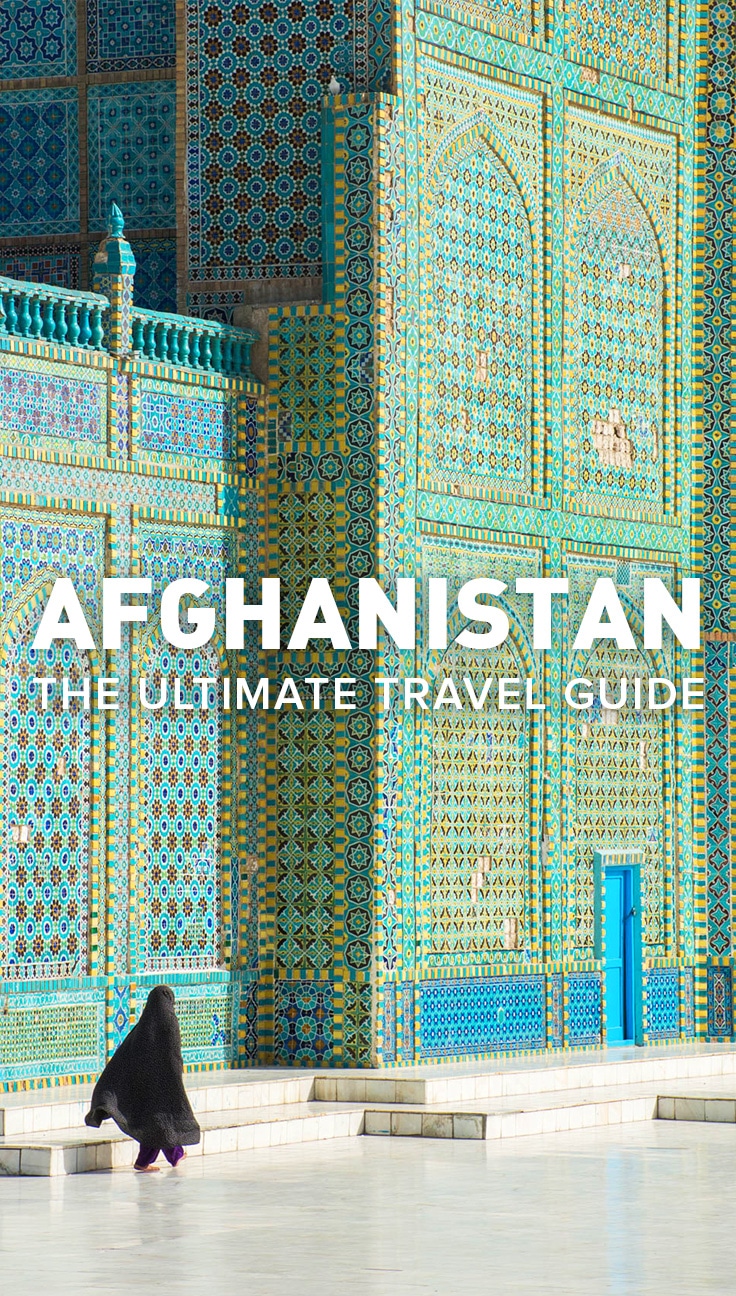
A Complete Afghanistan Travel Guide
- Latest update
- Realize this
Where is “safe” to travel in Afghanistan?
- Where to find more information
- Travel insurance
- Border crossings
Mazar-i-Sharif
Band-e-amir, wakhan corridor.
- Getting around Afghanistan
- Calling and internet
- What to wear
- Photography
- Women travel
- LGBTQ travel
- Average costs
- Money-saving
Read before you go
Afghanistan travel blogs, is afghanistan safe for travel in 2020.
Although the security situation is bad in many areas of the country, the places covered in this guide are relativly safe… for Afghan standards.
Always be careful— a false sense of security doesn’t mean a place is secure. The US and the Taliban are currently in the last phase of negotiating a peace deal between the two parties, after which the US army is supposed to leave Afghanistan. When this happens, there is a chance the Taliban will try to overrun the Afghan government. Keep an eye out on the news to follow the situation.
Realize this before traveling to Afghanistan
Afghanistan is a gorgeous country. It housed many religions and been the heart of many empires. Hospitality flows in Afghans’ blood, and the food is a mouthwatering mix of Persian, Central Asian, and South Asian influences. It’s easy to see why one would want to travel there.
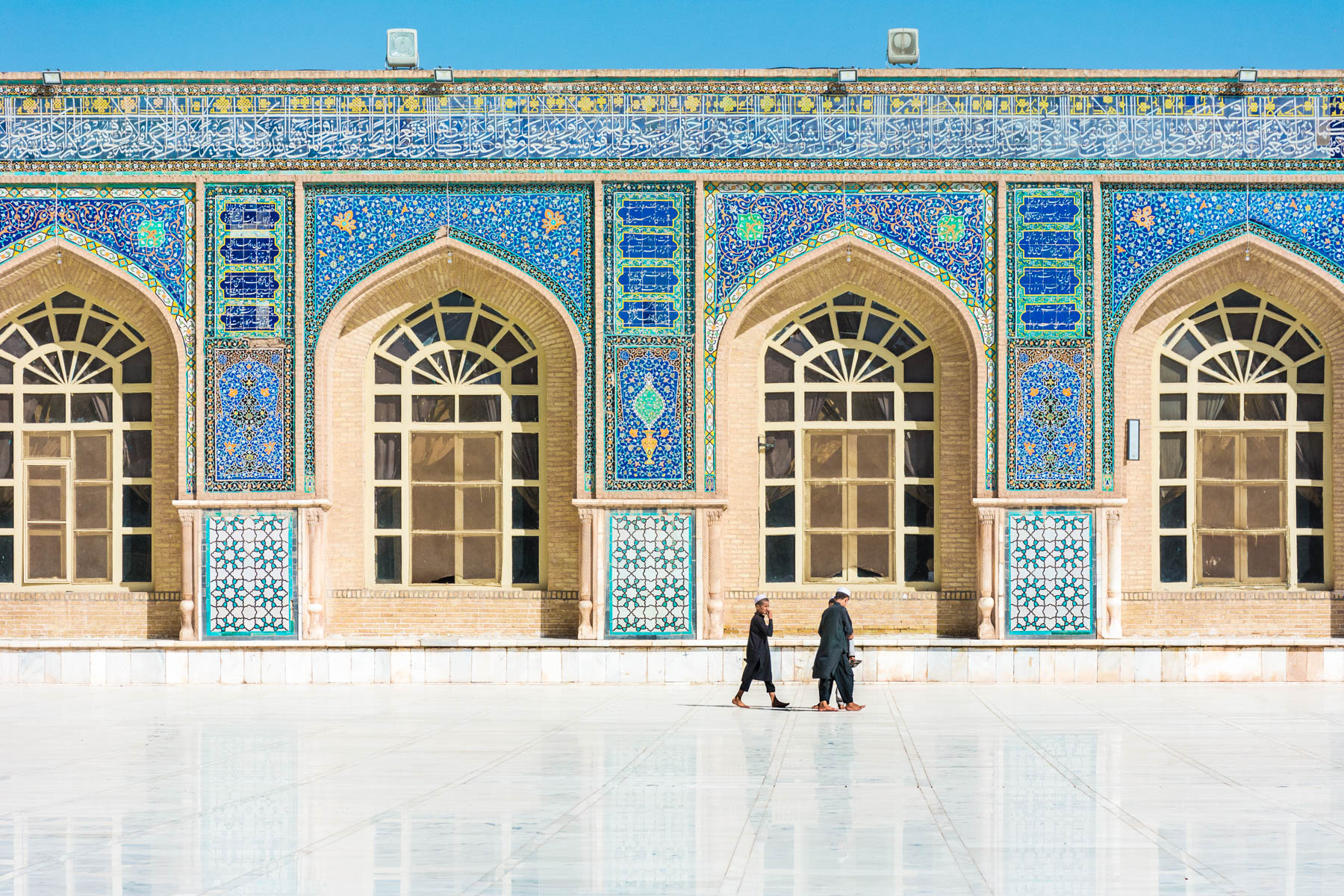
But Afghanistan is a dangerous country for travel. All governments strongly advise against travel to Afghanistan.
It has been for decades, and unfortunately, it probably will be for some time to come. If you choose to travel to Afghanistan, you choose to put yourself at risk .
That’s not to say that you shouldn’t go—just be aware of what you’re getting into. Afghanistan is not just a place to cross off your bucket list. It’s not the next step after your month of backpacking in Bali . It’s not a good place to take your first solo trip, regardless of gender.
We recommend that only experienced travelers head to Afghanistan, and even then, be careful.
As of early 2019, the Taliban, US, and the Afghan government are holding a series of peace talks to establish long-lasting peace in the region. Many of our Afghan friends are hopeful, but the Taliban often uses violence to improve its bargaining position. If you plan to travel to Afghanistan, make sure to inform yourself of the current situation.
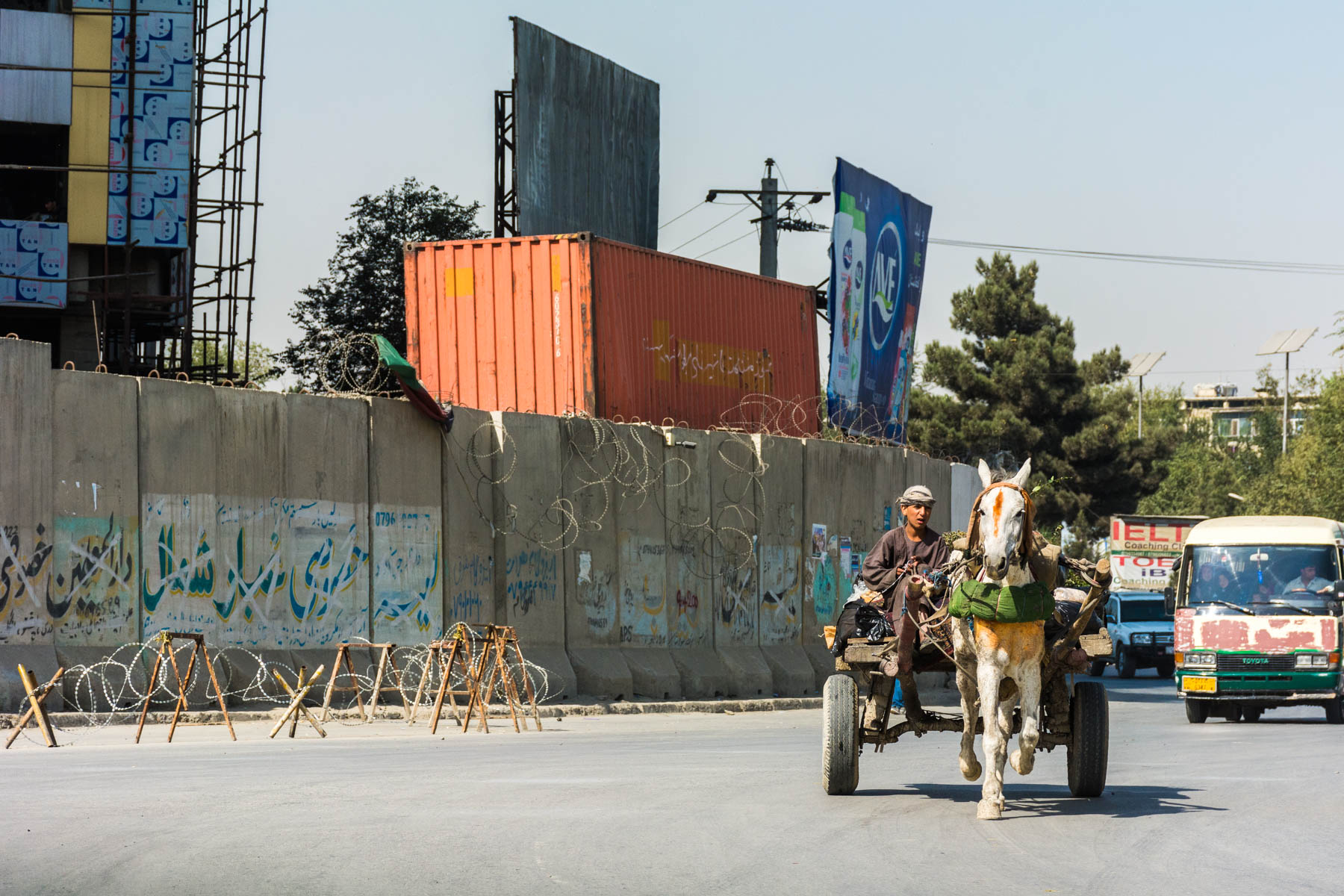
“Safety” is relative in Afghanistan. Everything can change at the drop of a hat.
While we were there in 2016, Kunduz was captured by the Taliban… then recaptured by the government, all in the span of a few days. Be sure to research the current state of things when planning your trip—see the Safety section for more details.
The only officially “safe” place in Afghanistan is the Wakhan Corridor in the Pamirs, and even then, Taliban control is moving in that direction.
But in terms of relatively safe places in Afghanistan, currently (as of July 2019) the following cities and neighboring areas are safe enough to travel to:
- Panjshir Valley
If you stick to the information provided in this Afghanistan travel guide, the above cities should be safe enough to visit.
The city of Kandahar is safe to travel to. However, the areas surrounding it are extremely dangerous. We don’t recommend going here unless you have contacts that speak Pashto who can accompany you while out and about.
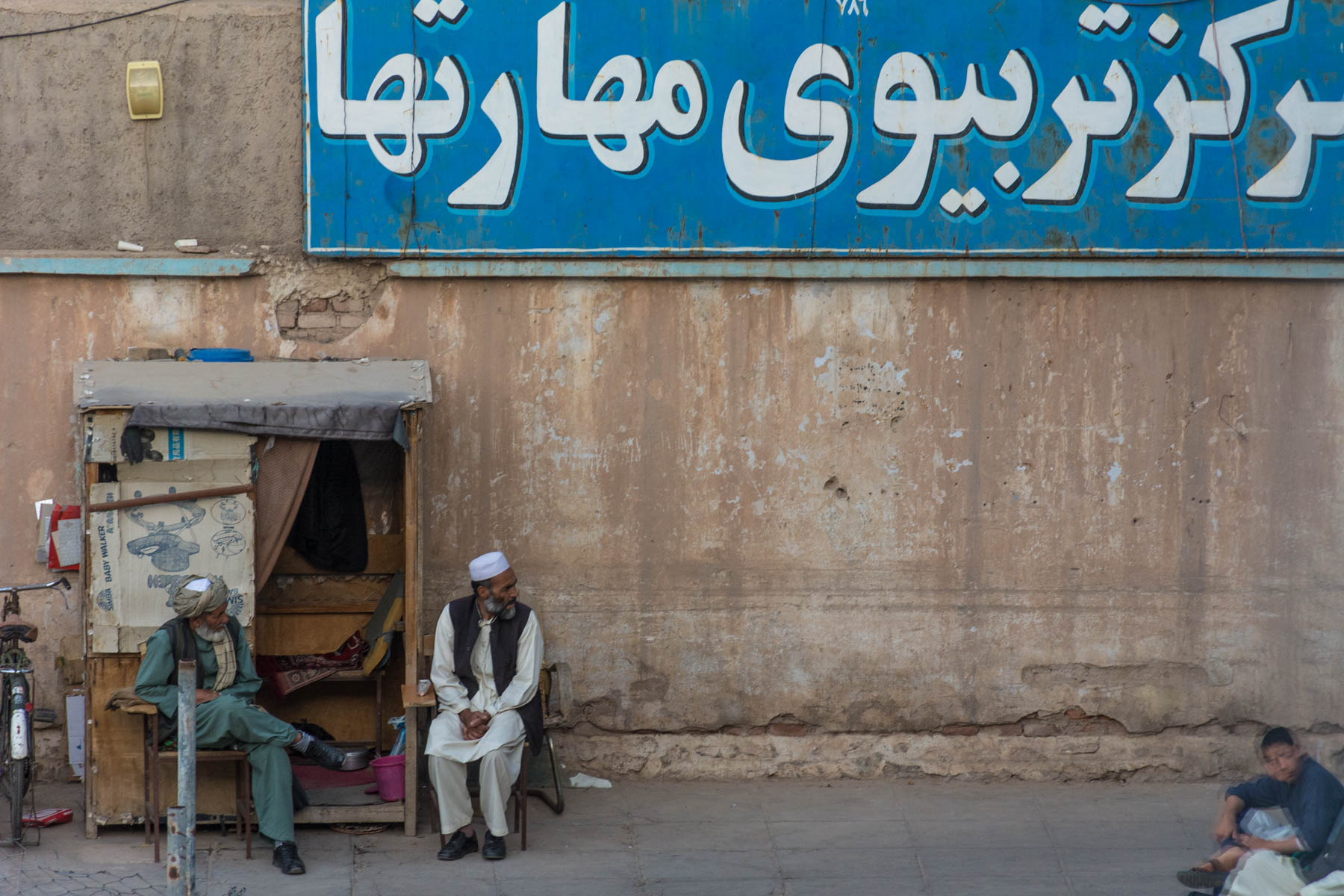
Given Herat’s close proximity to Iran, Dari (Afghan Farsi) is the language of choice.
Language in Afghanistan
Afghanistan has two official languages: Dari (Afghan Farsi) and Pashto.
People will generally call Dari “Farsi”, though it’s slightly different from its Iranian counterpart. Dari is more commonly spoken in the north and west, while Pashto, the language of the Pashtun people, is spoken in the south and in the regions close to the Pakistan border. However, many Pashtuns also speak Dari.
English is not commonly spoken in Afghanistan outside of Kabul, and even there, it’s limited. It would behoove you to learn to read and pronounce Persian numerals , and ask basic questions in Farsi/Dari such as “How much?” and “Where is…?”
Religion in Afghanistan
Afghanistan is an Islamic Republic, and Islam is practiced by 99% of its population . The majority of people follow Sunni Islam. A notable exception is the Hazara population, who are Shia. There are sectarian tensions between the two groups, and Hazara’s are often the target of attacks. It’s advised to steer clear of any religious gatherings, especially when large groups of Shia Muslims congregate (such as the Ashura commemorations). During our second visit, a bomb exploded at a Hazara demonstration near Shahr-e Now in Kabul, and a week later a large Shia gathering was attacked.
Most Afghans are very conservative, so make sure to dress and behave appropriately.
Currency in Afghanistan
Afghanistan operates in Afghanis. At the time of writing, USD$1 ≈ 78 Afs.
There are ATMs in the major cities, some of which dispense US dollars. However, they do occasionally run out of money. Bank Azizi and Afghan International Bank take international debit and credit cards and dispense both Afghani and USD. If you go to the ATM, it is better to take out Afs than to take out USD and convert them to Afs on the street. There is also an ATM at the airport where you can get USD and Afs.
However, it’s a good idea to bring in some large denomination US dollars. You can use them for large expenses such as guesthouses and hotels, and they’re easily changed wherever you go.
Where to find more Afghanistan travel information
You mean you want to find resources other than our Afghanistan travel guide? You traitor!
Nah, we kid. You should read as much as possible before you go, not just our Afghanistan travel guide! (Though ours is the best.)
Couchsurfing
Couchsurfing is a gold mine of Afghanistan travel connects. Search for hosts in the cities you plan on visiting and send the more reputable ones (those with the most reviews from foreigners) a message. Plenty of them are happy to provide you with advice—they encounter travelers with questions more often than you think!
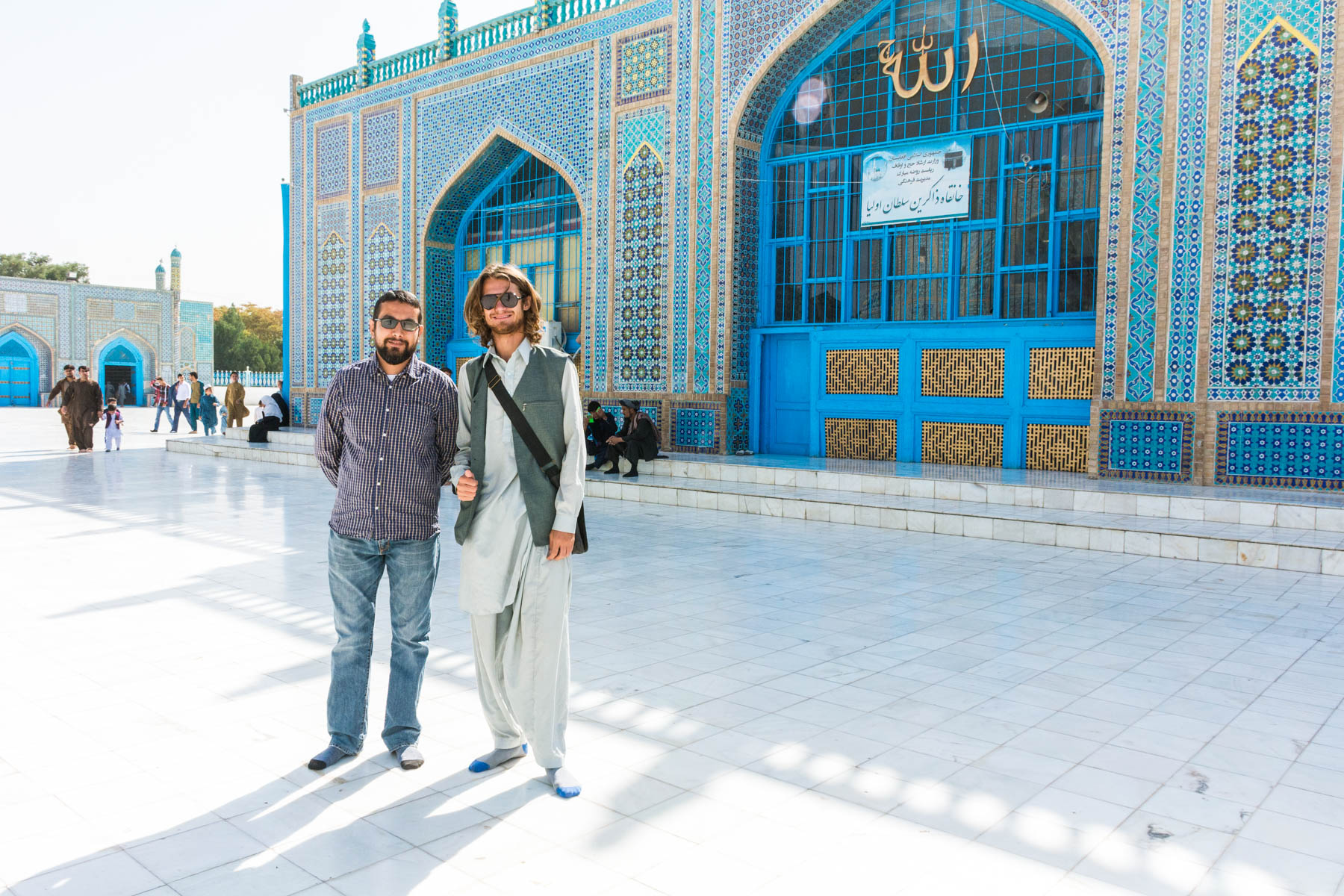
A friend we met via Couchsurfing in Mazar-i-Sharif.
Don’t restrict yourself to messaging hosts, though. Look through hosts’ references to find other travelers that have recently passed through. Why not send them a message asking for advice as well?
Lonely Planet’s Thorn Tree forums
A one-stop-shop when it comes to destination-specific questions, the Thorn Tree forums are a great place to ask questions and find recent information. Though the crowd is small in the Afghanistan section , there are some helpful souls amongst the naysayers, including some tour guides for the country.
Facebook groups
We joined two Facebook groups before leaving: Kabulians and Kabul Security Now . They’re filled with expats and locals that can answer some of the questions you might have. Don’t publicly post actual dates of your travels—instead, ask a vague question, or pick someone seemingly reputable and send them a message asking for advice.
Remember, however, that many expats live a vastly different life from travelers. Most foreign aid workers live with constant security, and their perspective might be biased or limited as a result.
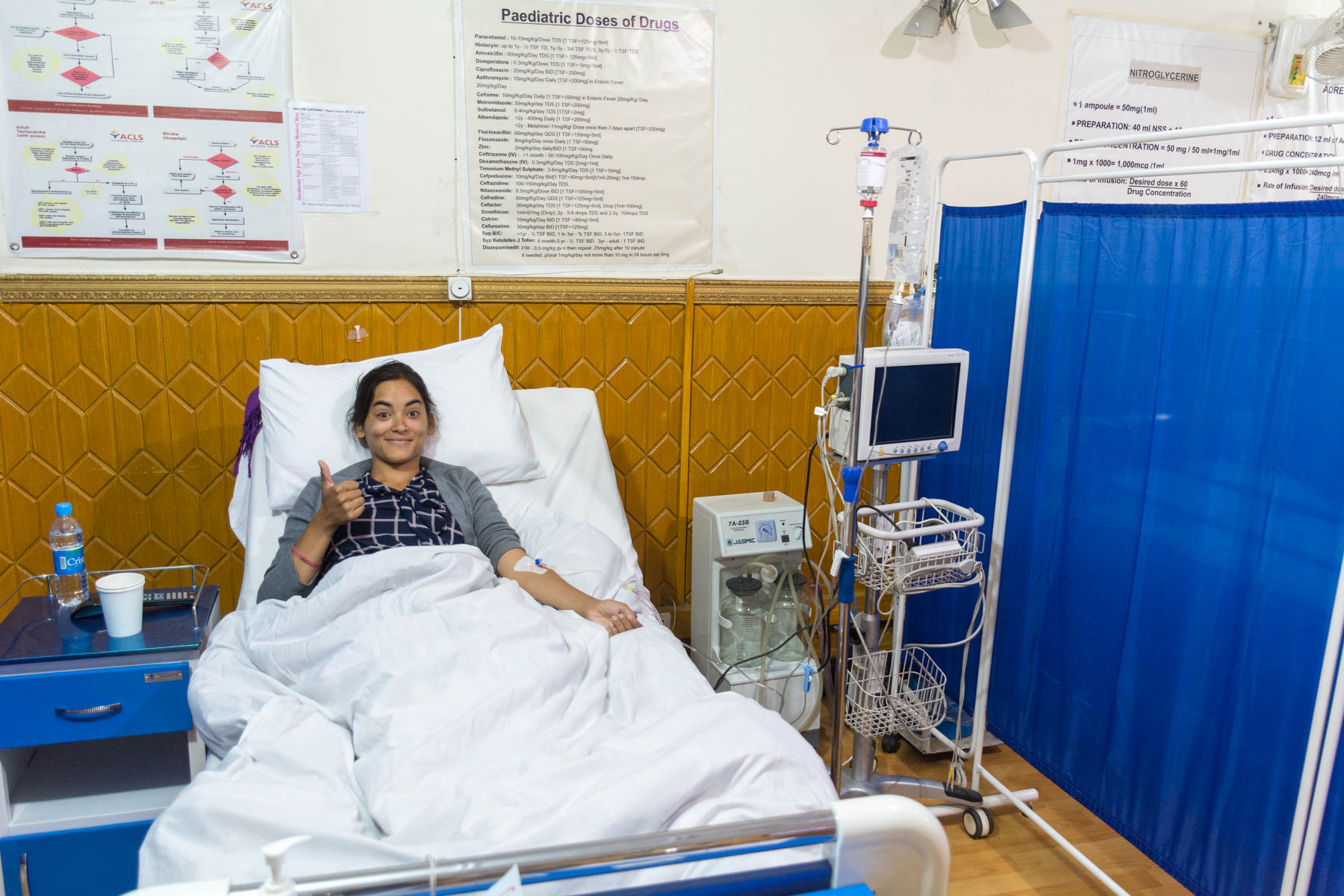
We had a little battle with Afghan bacteria and ended up having to pay the clinic fees out of pocket. Don’t make the same mistake!
Travel insurance for Afghanistan
As you could’ve guessed, it’s not easy to find insurance companies willing to cover travel in Afghanistan. Despite the difficulty, it’s not a bad idea to get travel insurance when traveling through a third world war zone. Just sayin’.
There’s an incredibly thorough guide to insurance options for Afghanistan (and other war zone areas) on Lonely Planet’s Thorn Tree travel forums.
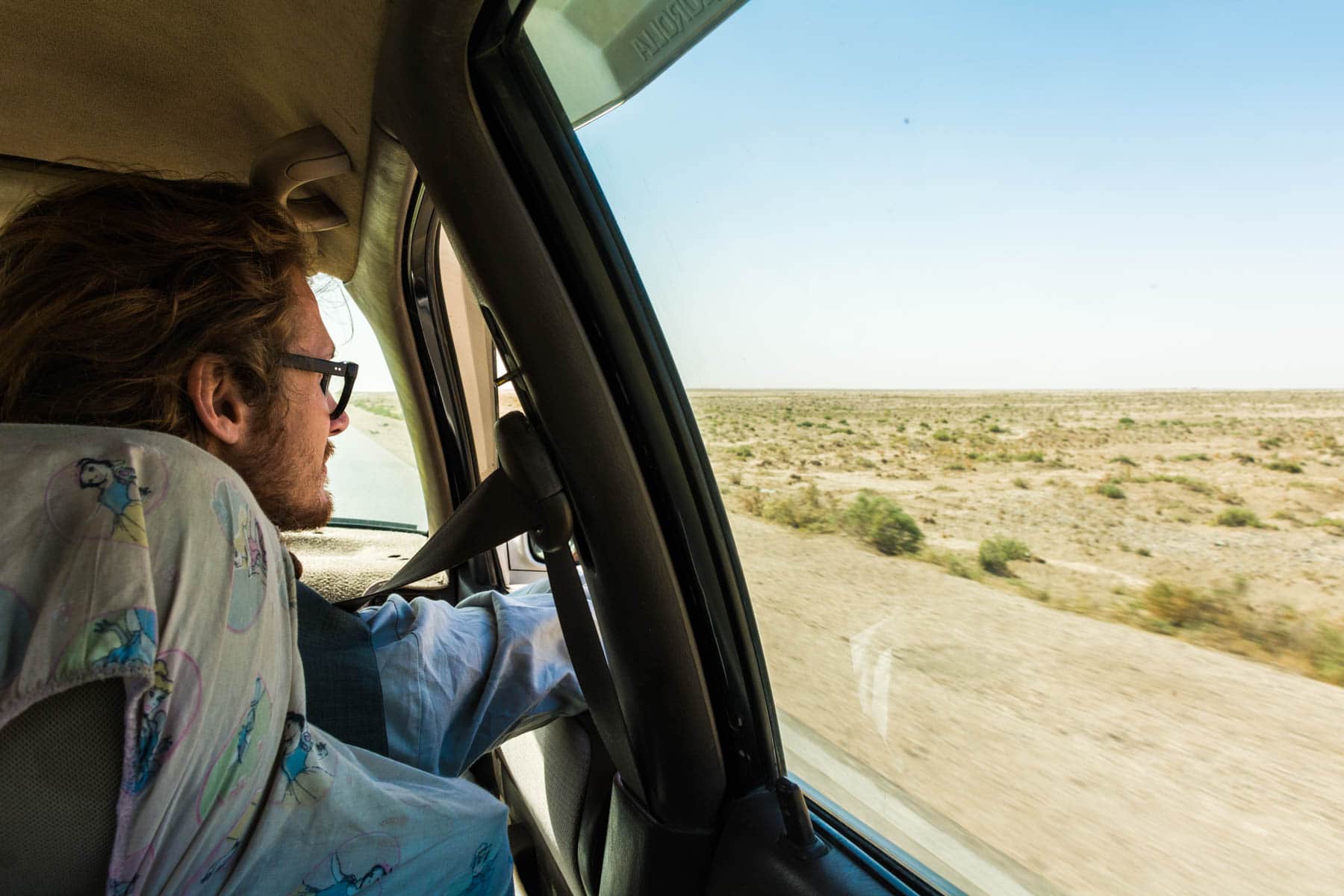
Our first taxi ride in Afghanistan, coming from the Uzbek border .
Getting to Afghanistan
Visas & permits for afghanistan and the wakhan corridor.
It’s notoriously difficult to get an Afghanistan visa in many countries. Some don’t even issue visas anymore, others demand a lot of waiting time.
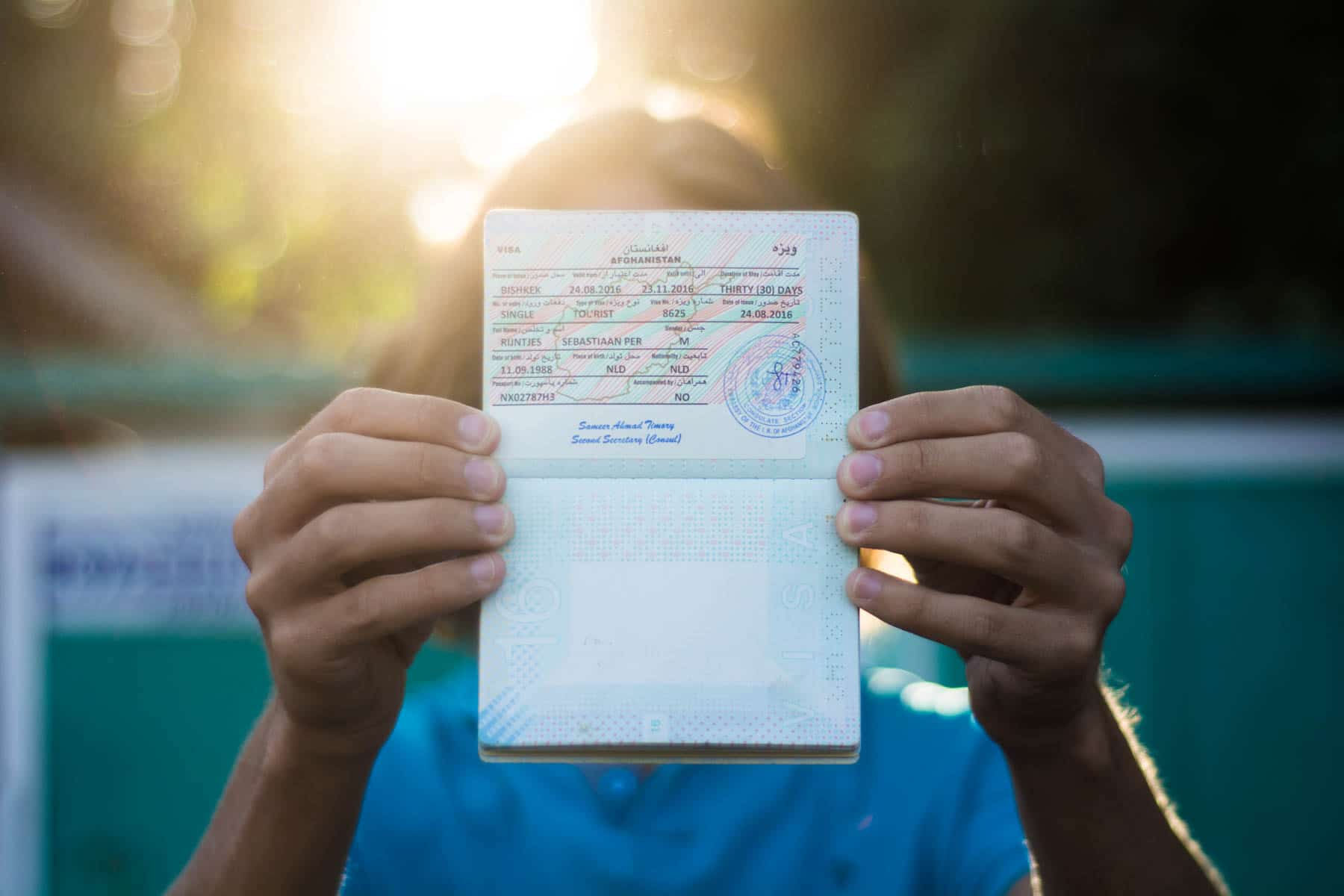
We applied for our Afghanistan visa in Bishkek, Kyrgyzstan , which used to be the easiest place to get an Afghan visa in Central Asia. However, since August 2017 the embassy in Bishkek doesn’t issue tourist visas anymore.
Right now, the best options to get a visa for Afghanistan are the Afghan embassy in Islamabad or the Consulate in Karachi, or the Afghan embassy in Dubai. It’s reportedly also possible to obtain an Afghan visa in Kuala Lumpur. Some embassies require an invitation letter. There are several people in the Kabulians Facebook group who can help you with this if necessary.
For reports from other embassies around the world, check out Caravanistan’s Afghan visa guide .
Permits for the Wakhan corridor
A permit is necessary for trekking in the Wakhan corridor, which can be obtained in Ishkashim, Afghanistan. More information can be found in Caravanistan’s Afghan visa guide .

A border guard at the Uzbek-Afghan border crossing trying to wrap his head around a GoPro.
Border crossings in Afghanistan
If coming in by land, you have a limited number of options. At the time of writing, the only border crossings open to foreigners are:
- Uzbekistan – Afghanistan border crossing at Hairatan – The crossing we used in 2016.
- Turkmenistan – Afghanistan border crossing at Torghundi – This information dates from 2011, so be cautious. If you plan on taking this crossing, talk to your Turkmenistan tour operator and your contacts in Herat for advice.
- Iran – Afghanistan border crossing – Buses from Mashhad head to the border via Torbat-e Jam . It should be possible to get a (shared) taxi on the Afghan side. For more information, you can contact Vali of Vali’s Homestay in Mashhad , and your contacts in Herat.
- Tajikistan – Afghanistan border crossing (Wakhan Corridor) – The most commonly used border crossing, “plenty” of tourists will hop over the border for a day or two to visit the Afghan border market .
- Pakistan – Afghanistan border crossing – The borders between Afghanistan and Pakistan are usually only open for Afghan’s and Pakistanis. However, there have been several reports of foreigners crossing the border to Pakistan from the Afghan side. However, at the time of writing, we do not recommend this unless you have high places contacts on both sides of the border.
Flying to Afghanistan
If you prefer to fly into Afghanistan, there are multiple international carriers (of varying quality) that operate flights into Afghanistan.
- Turkish Airlines operates flights from Istanbul to Kabul.
- Kam Air operates flights from several international destinations. These include Delhi (India), Dubai (United Arab Emirates), and Dushanbe (Tajikistan).
- Ariana Afghan Airlines operates flights from several international destinations, including Ankara (Turkey), Delhi (India), Dubai (United Arab Emirates), Istanbul (Turkey), Moscow (Russia), and Urumqi (China).
Practical Afghanistan travel info
Places to visit in afghanistan.
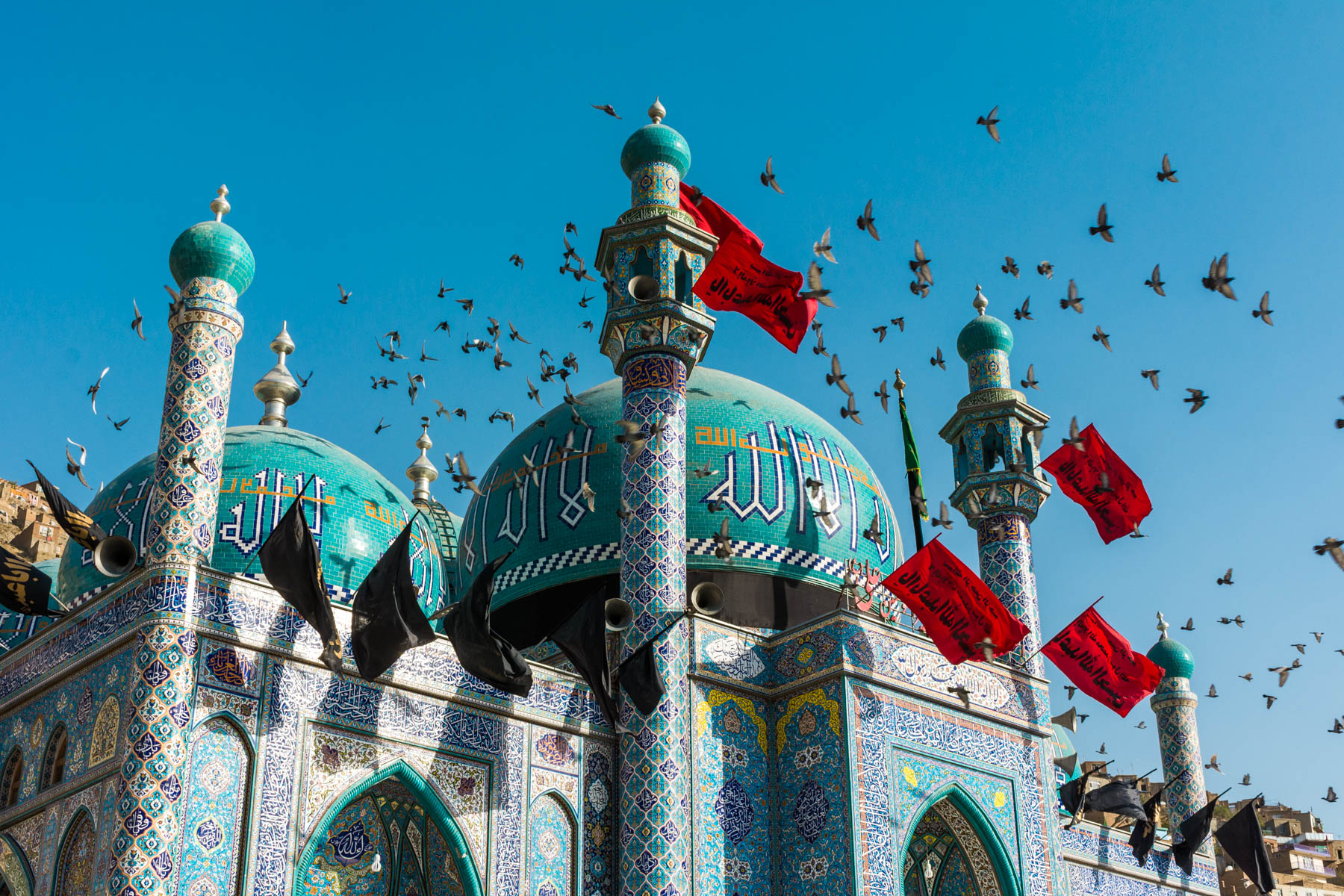
The Sakhi shrine in Kabul, where dozens of Shias were killed in an attack on the holiday of Ashura in 2016.
The most common starting point for travel in Afghanistan. Kabul, Afghanistan’s capital, is an intense introduction to the country. Expect concrete walls, barbed wire, police galore, and a tense atmosphere in many places. The center city is more like a big fortress than a city.

Concrete-chic.
But that’s not to put you off your appetite! You can just as easily find places filled with happy families picnicking, or groups of teens relaxing and smoking some hashish. The city is ringed by beautiful mountains blanketed by stepped houses and offers plenty of excellent panoramic views. Kabul has something for everyone, from old shrines and cramped bazaars to chic hotels and secret bars where you can find a rare drink (or three).
If you go to Kabul, realize that kidnappings are a problem, and it’s best to stay as low-key as possible.
Where to stay in Kabul
There are several budget and mid-range options in the Shahr-e Naw area of Kabul. This area is relatively safe and is home to the famous Chicken Street. We stayed in Salsal Guesthouse during both of our visits.
- Budget: Salsal Guesthouse – $10/$20 for a single/double with breakfast and shared shower,
- Mid-range: Omega Guest House – Low profile guesthouse
- High end: Serena Hotel – $350/night, the best hotel in Kabul with security to match
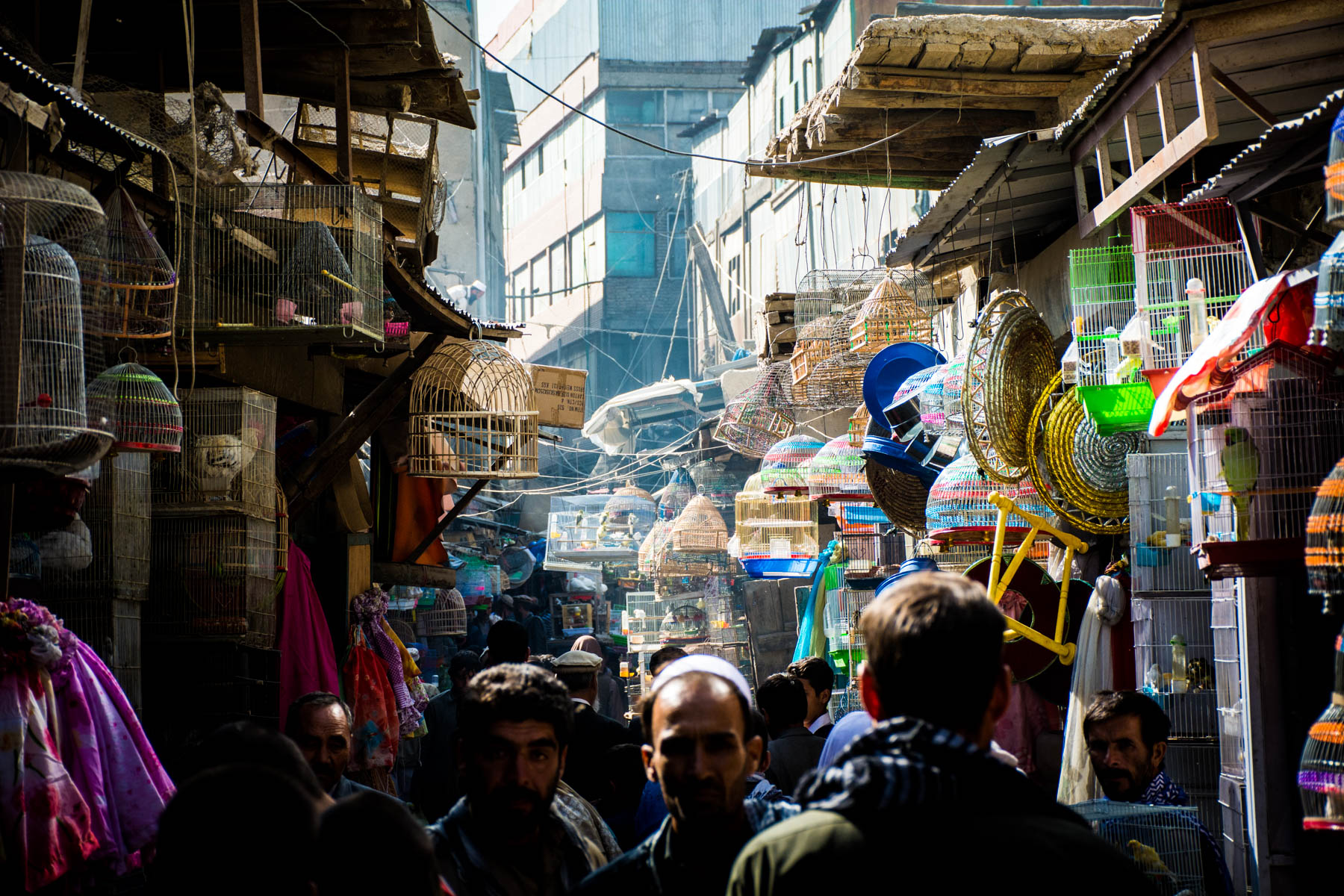
Ka Faroshi bird market.
Things to do in Kabul
Kabul is an ancient city with many things to do. From wandering through the bird market and the old city to finding tranquil peace in Babur’s Mughal Garden, Kabul has the ability to stun and perplex. Below are some of our favorite places to visit in Kabul.
- Murad Khani – The old city of Kabul has partly been restored by Turquoise Mountain , and can be visited if you have the right contacts. Send them a mail for more information or try showing up for an impromptu tour.
- Shrine of Sakhi
- Gardens of Babur – A peaceful oasis in a chaotic city
- Bibi Mahro Hill (behind Wazir Akbar Khan) – views over the center city
- View from the T.V. tower hill
- Ka Feroshi bird market and surrounding bazaar
- Kabul Museum
- OMAR Landmine Museum
- Chicken Street – old tourist gift shops from the Hippy Trail days
- Shah-do-Shamshira Mosque
- Panjshir Valley (day trip) – Nature, destroyed tanks, Massoud’s tomb
- Istalif – a small town about 2 hours away from Kabul and an excellent day trip
- Paghman – a small valley about an hour out of Kabul, another great day trip.
There are also several trendy cafes in Kabul where the young urbanites of Kabul mingle and dream. These include The 14th, Slice Bakery, Afrah Cafe, Nosh Book Cafe, Kora, The Cupcake Cafe, and iCafe. These cafes can be found on Google Maps.
Note: The destroyed Darulaman palace , once a popular tourist stop, is now being renovated and is no longer visible nor accessible.
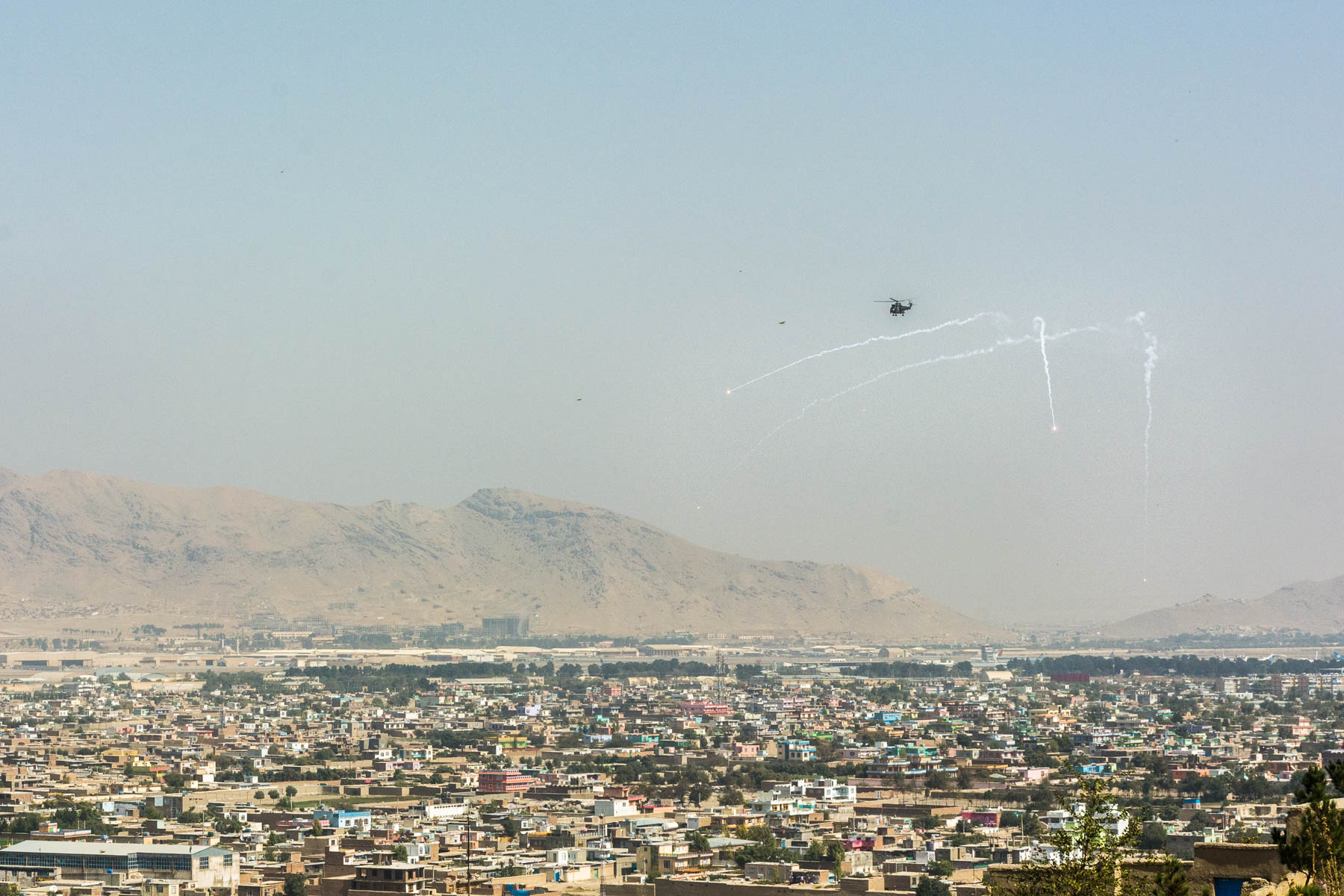
A military helicopter patrolling the skies.
Safety in Kabul
Kabul is probably the least safe city of the places you’ll visit in Afghanistan. Though that wasn’t always the case, in recent times Kabul has seen regular violence and a slurry of large attacks, most notably the attack on the American University.
Your biggest concern in Kabul is the high prevalence of kidnapping. Not necessarily by the Taliban, but by impoverished people looking for ransom money. To be safe, don’t tell people where you’re staying, be careful who you trust, and try not to roam too much after dark.
Being caught in some crossfire, though less likely, is another concern. To reduce your chances of the worst happening, avoid:
- Spending time near important governmental places such as embassies and ministries
- Getting stuck in traffic jams on main roads
- Large gatherings of people on the street, especially with lots of police
- Religious events, especially events held by minorities such as Shias
For constant updates on activities in Kabul (and to get a sense of how much really goes on there), join the Kabul Security Now Facebook group.
Protip: If you’re hungy at night but don’t want to leave your hotel, use the app ZootZoot . ZootZoot is the only food delivery app in Afghanistan and has a good selection of restaurants signed up.
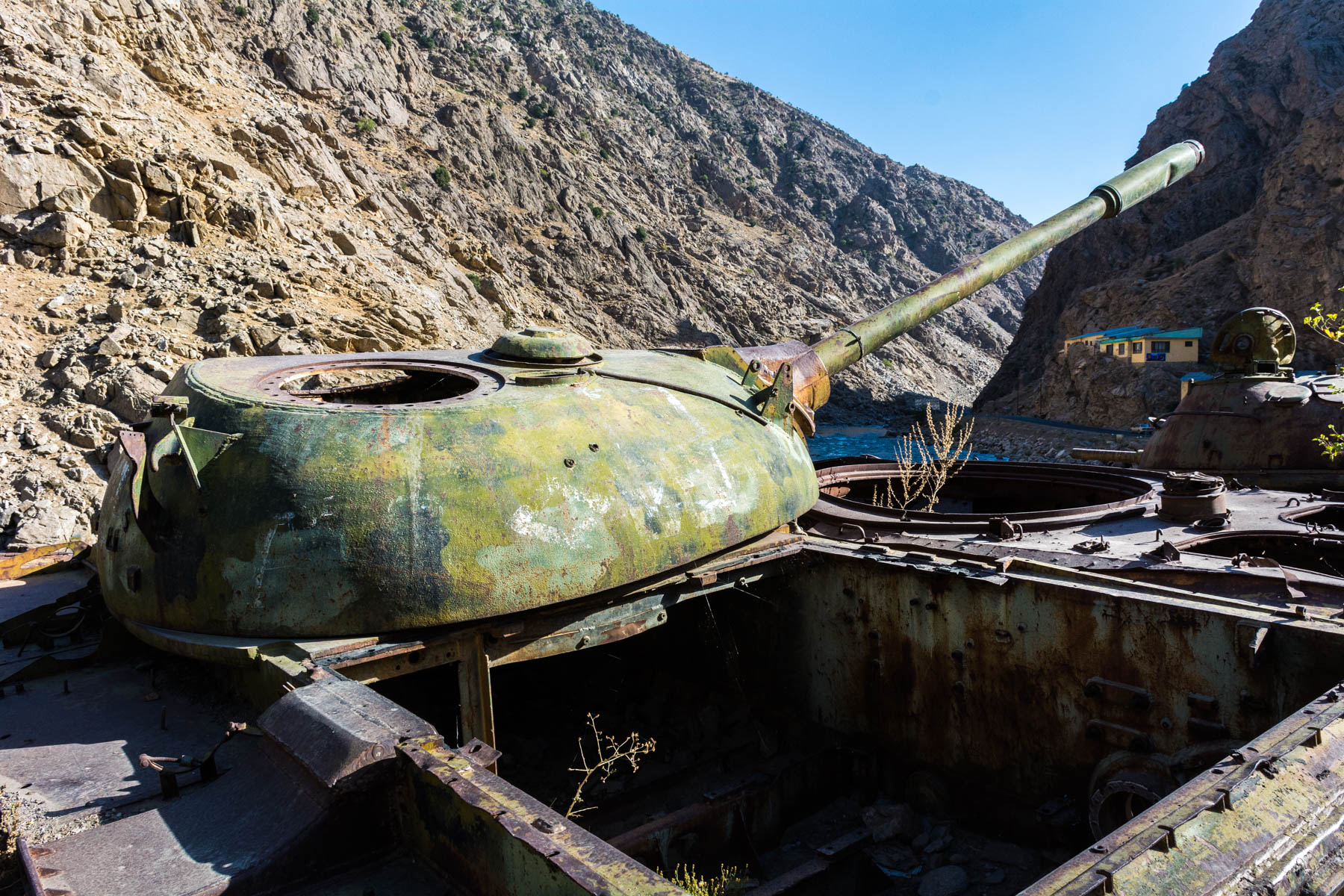
A tank in the Panjshir Valley, only 2 hours away from Kabul by taxi.
Transportation in/out of Kabul
- Taxi to the Panjshir Valley: We paid about $45 (3000 Afs) for a taxi to and from the Panjshir Valley, but we’ve heard it can be done for $40… or less. It’s about 100 km to the valley, and the drive takes 2-3 hours with checkpoint stops once you’re in the valley.
- Bus to Mazar-i-Sharif: There is a bus between Mazar-i-Sharif and Kabul for around 600 Afs/person . Ask around to see if the route is safe before buying a ticket, and make sure to leave early so the bus arrives before dark. If you opt for this route, dress local and keep a low profile. The fewer people know there is a foreigner on the bus, the better. In November 2018 we were told that this route is relatively safe at the moment, but please exercise caution.
- Bus to Herat: W e highly recommend you do not take this route . It passes through regions controlled by the Taliban, and even Afghans prefer to fly. A Couchsurfing host said he does know foreigners who successfully made the trip, but he suspects they only made it because they could pass as Afghans. If you do take the bus, stay silent.
- Bus to Bamiyan: Since flights are still not operating regularly, you have to take a bus to visit Bamiyan. Since the area between Kabul and Bamiyan sees occasional violence, it’s important to ask locals about the status of this area before going. If you opt to take the bus, make sure the driver is taking the Ghorband route, which is considered safe. The road through Wardak is not safe.
- Flights to Mazar-i-Sharif, Herat, Kandahar, and Bamiyan: Ariana Afghan Airways flies to Kandahar and Herat. Kam Air flies to Mazar-i-Sharif, Herat, Kandahar, and Bamiyan. Note that not all destinations are listed on the airline’s respective websites. It’s best to go to a ticket office for domestic bookings. One-way tickets are between $50 and $110, depending on the destination. Flights to Bamiyan are still not operating regularly.
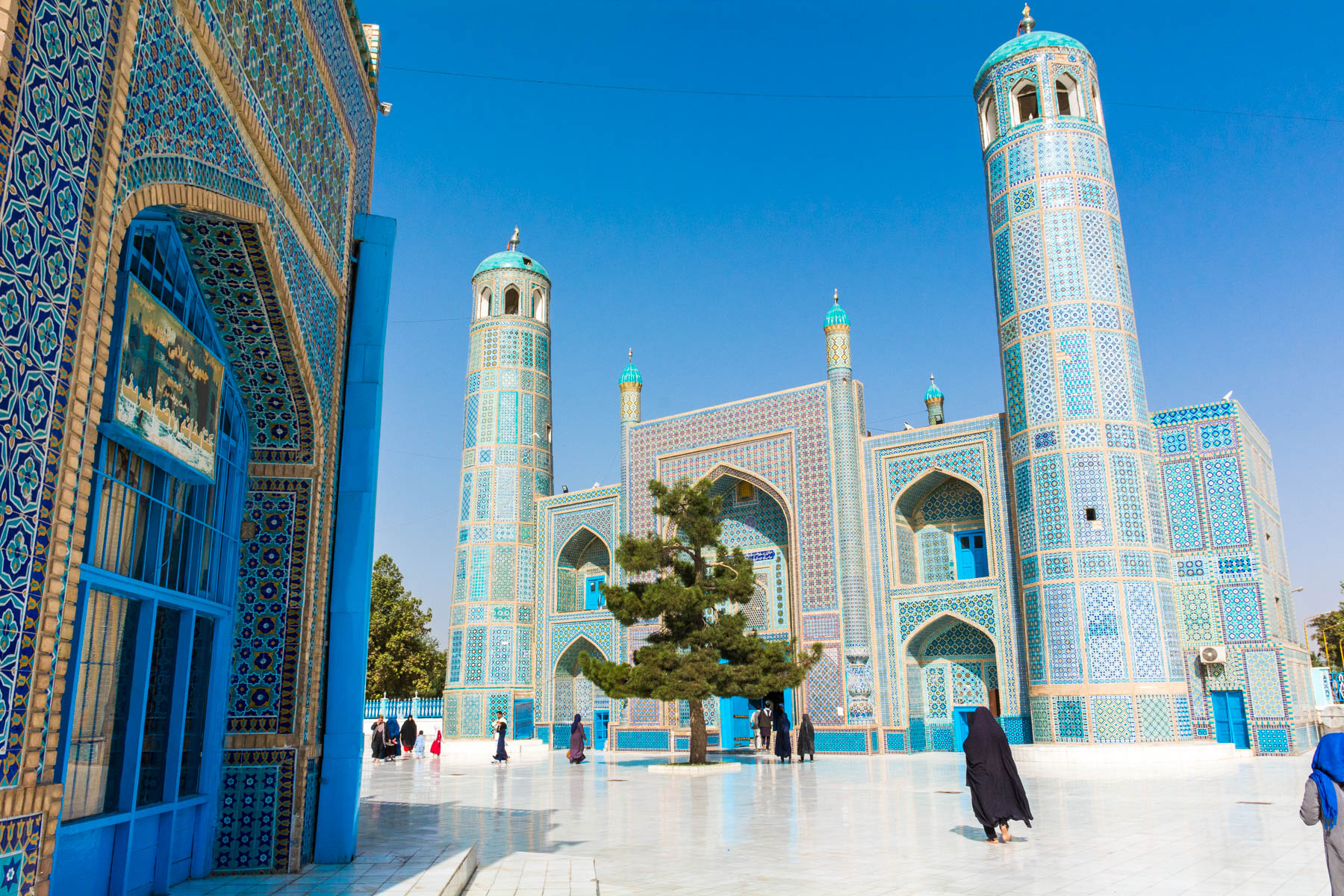
The Shrine of Hazrat Ali, also known as the Blue Mosque.
One of Afghanistan’s most liberal cities, you’ll see plenty of people walking around in modern, colorful clothes, and plenty of girls in only hijab , not burqa . Aside from the stunning Shrine of Ali and the bazaars, there’s not so much to see in Mazar’s city limits itself, but there are a couple of day trips throughout Balkh province that will definitely be worth your while.
Where to stay in Mazar-i-Sharif
Most accommodation options are clustered around the bazaar and are walking distance from the Shrine of Ali. There are also plenty of cheap eateries around. We stayed in Barg-e-Sabz Guesthouse when we visited.
- Budget: Barg-e-Sabz Guesthouse – $20 for a double with private shower and breakfast
- Mid-range: Barat Hotel – $30 for a single with shared toilet
- High end: Royal Oak Hotel (Renaissance Hotel) – $70 for a single with security
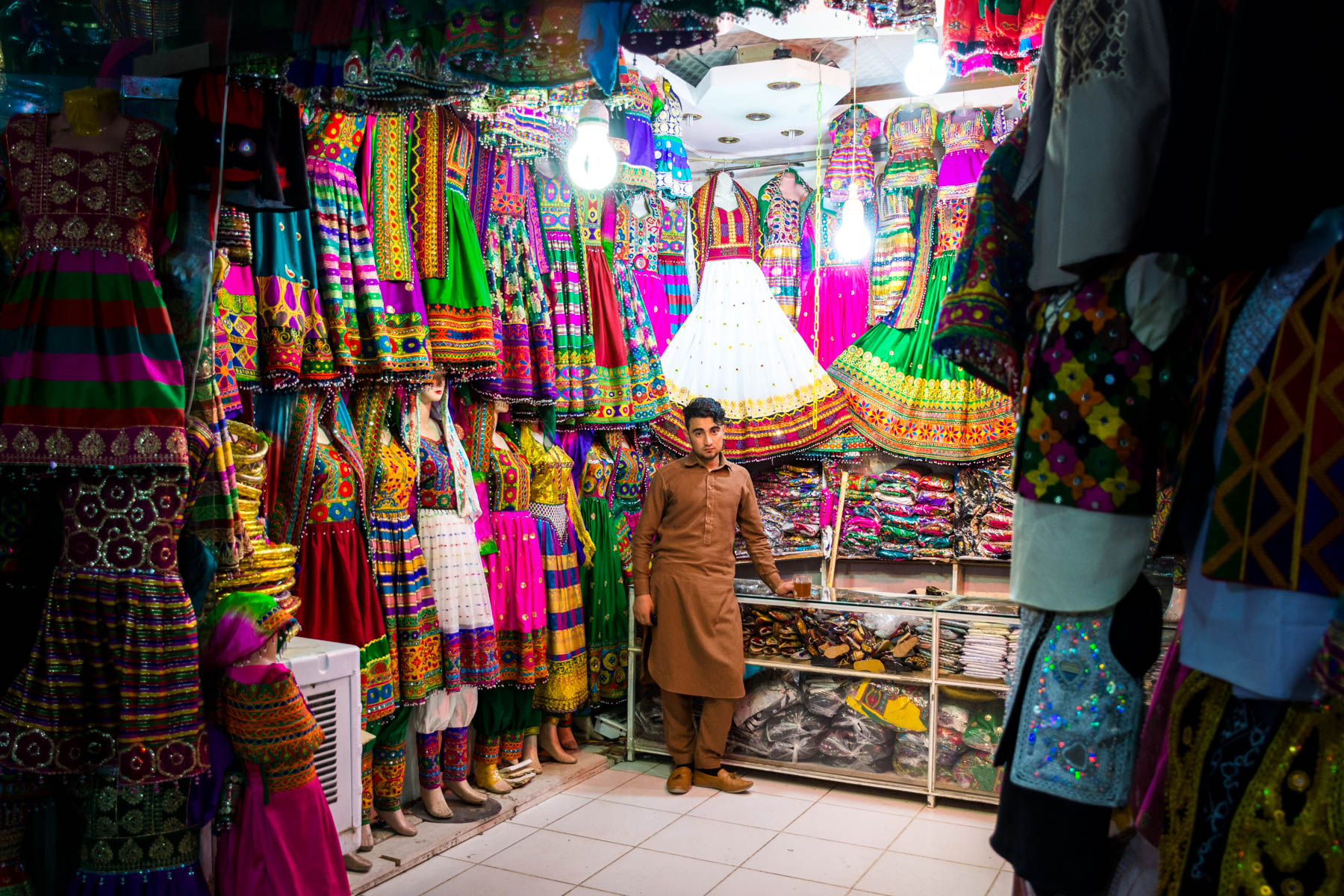
One of the many colorful shops in the bazaars around the shrine.
Things to do in Mazar-i-Sharif
The Shrine of Ali, better know as the Blue Mosque, is one of the highlights of any visits to Afghanistan. Besides that, there are several day trips that can be made from Mazar. For more inspiration, check out our photo essay on Mazar-i-Sharif .
- Shrine of Hazrat Ali, AKA the Blue Mosque
- Old Balkh (day trip)
- Samangan (day trip)
- Bazaars around the shrine
- Mausoleum of Hazara leader Abdul Ali Mazari
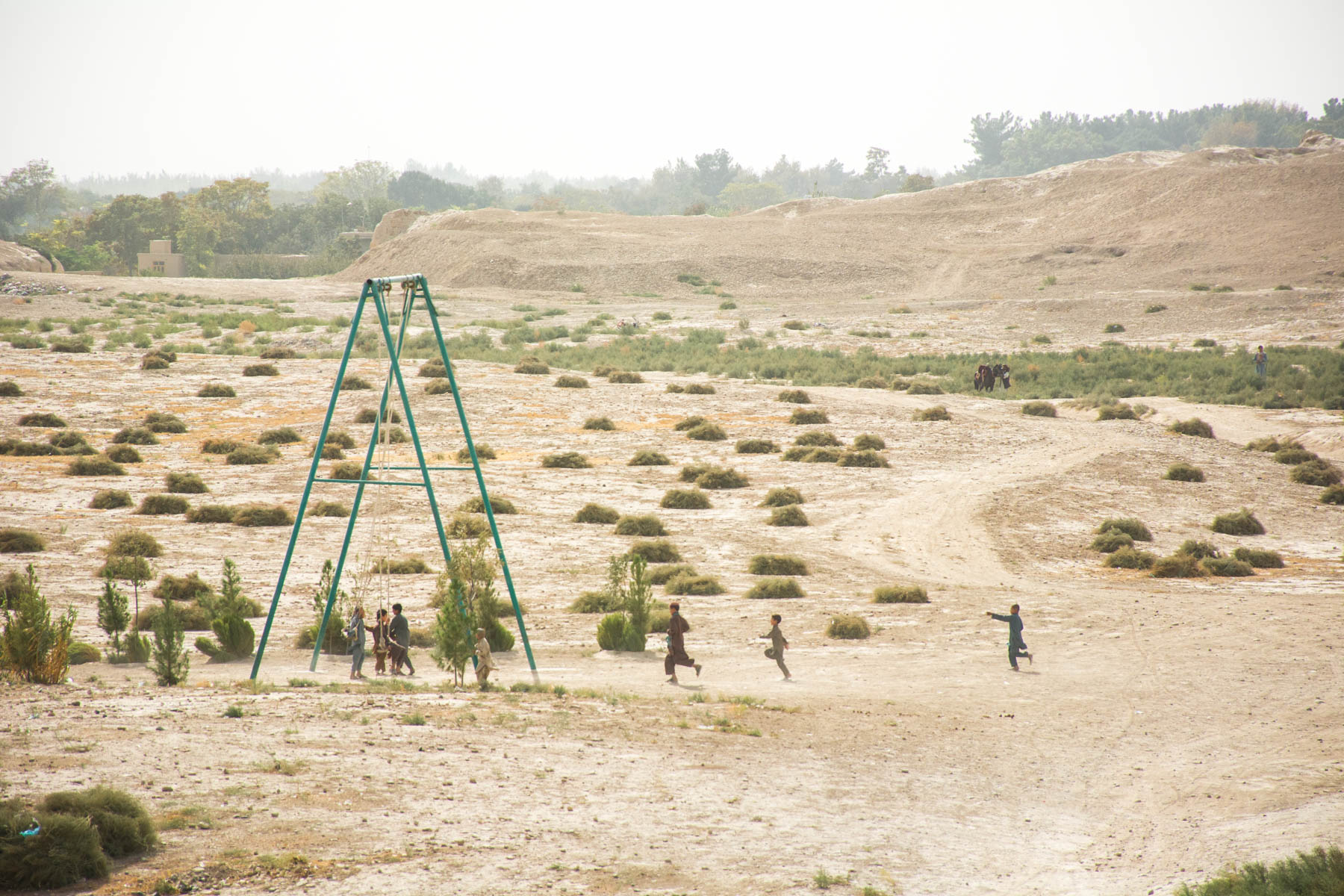
Kids playing on a swing set in Old Balkh.
Safety in Mazar-i-Sharif
Mazar-i-Sharif is Afghanistan’s safest major city. There are fewer problems with kidnapping here than anywhere else, and the Taliban doesn’t operate here often. That being said, there was an attack on the German consulate in the center of Mazar, proving that even the “safest” places in Afghanistan are risky.
Blasts aside, it’s safe to walk around until about 8 or 9 at night, especially in the bazaar area where there are lots of police, but try not to stray too far from your guesthouse at night unless with a local.
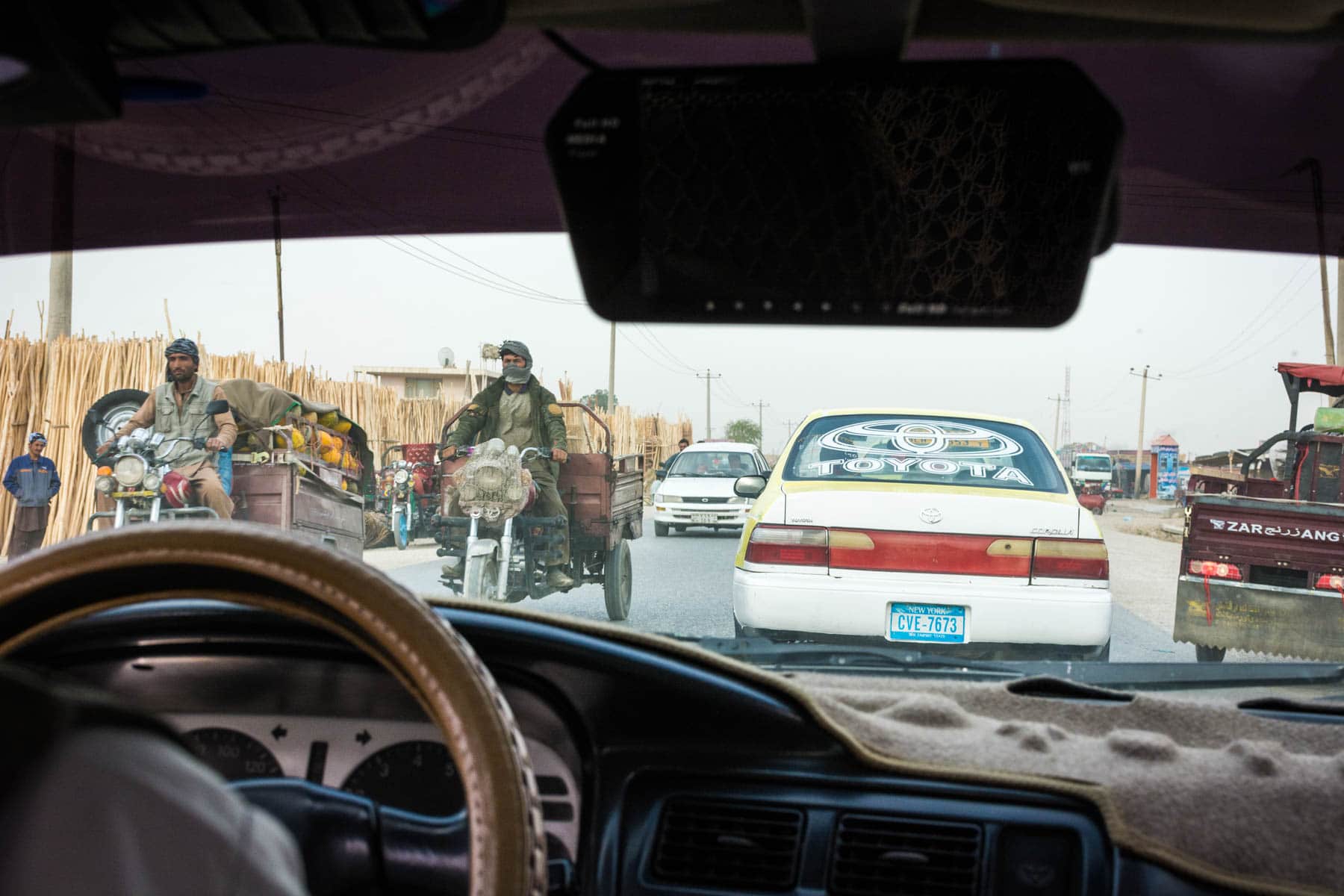
Transportation in/out of Mazar-i-Sharif
- Taxi to Old Balkh: A taxi for a day trip around the sights of Old Balkh cost us $20 . We stopped at 7 or 8 different places, and the guide didn’t speak English (but was kind and patient despite the fact that we were stoned for half of it). We organized the taxi with the help of Barg-e-Sabz Guesthouse.
- Bus to Kabul: There is a bus between Mazar-i-Sharif and Kabul for around 600 Afs/person . However, at the time of writing, civilian traffic was stopped on this route due to increased Taliban activity in the area. Ask around to see if the route is safe before buying a ticket, and make sure to leave early so the bus arrives before dark.
- Ticket to Herat: 8,000 Afs/person ($120) – Mondays and Thursdays
- Ticket to Kabul: 6,000 Afs/person ($90) – daily
- Prices may vary depending on the oil price and the safety situation in Afghanistan
- Taxi to Hairatan (Uzbekistan border crossing): A taxi to the border was $15, but can be bargained down to $10 (780 Afs). See our Uzbekistan – Afghanistan border crossing post for more details.
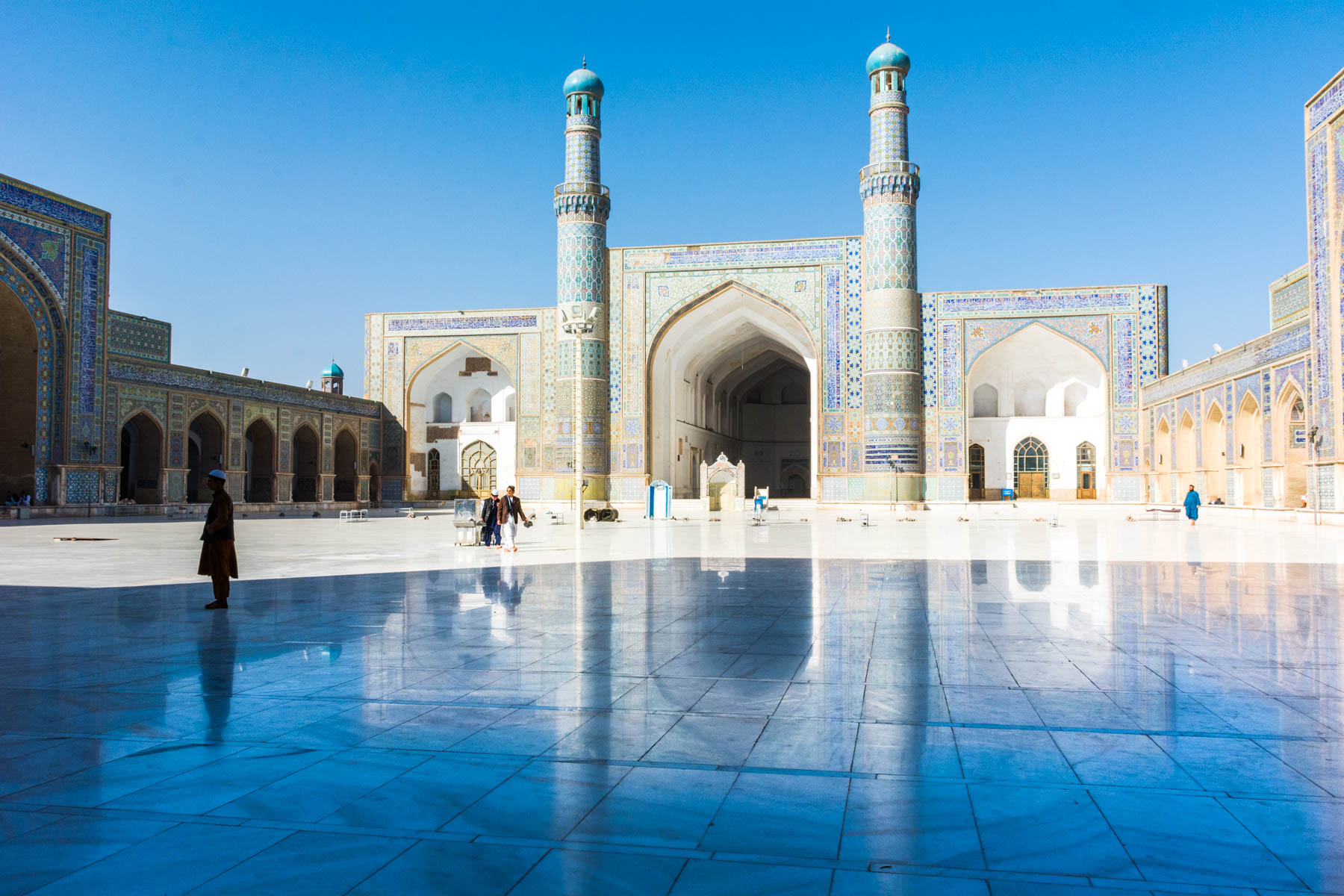
Herat’s Jama Masjid, or Friday Mosque.
Walking around in Herat is almost like walking around in Iran … one of the more conservative cities in Iran, that is. You’ll be hard-pressed to find a woman not wearing chador or burqa. But despite the dark dress, people in Herat are some of the friendliest you’ll meet, and the city is far from dull. Filled with colorful Persian mosques, ancient houses, and caravanserais, and surrounding an epic, recently restored citadel, Herat is one of Afghanistan’s prettiest cities.
Where to stay in Herat
Besides the guesthouses we mention below, Herat has a decent CouchSurfing scene for Afghan standards. There are several trusted hosts in Herat, so check it out if you’re so inclined.
- Northeast corner of Chawk-e-Golha, next to the Bank Milli. It’s famous, taxi drivers will know it.
- Badmurghan street, +93 (40) 221 946 or (40) 221 947, mobile +93 (0) 799 206 192 or +93 0700 436 622, [email protected]
- High end: Nazary 4 Star Hotel – Rooms for less than $150 a night, Herat’s most luxurious hotel

The recently restored Herat Citadel.
Things to do in Herat
Herat is full of ancient buildings and narrow alleyways to walk around in. We recommend taking at least two days to explore this city and the marvels it has to offer.
- Jame Mosque (Friday Mosque)
- Herat Citadel
- Wander around the old city
- Mausoleum of Gowhar Shad – Ask to be let inside!
- Shrine of Gazar Gah
- Musalla Complex and minarets – the grounds were closed when we visited in 2018 so ask around for a caretaker
- Pul-e-Malan arched bridge
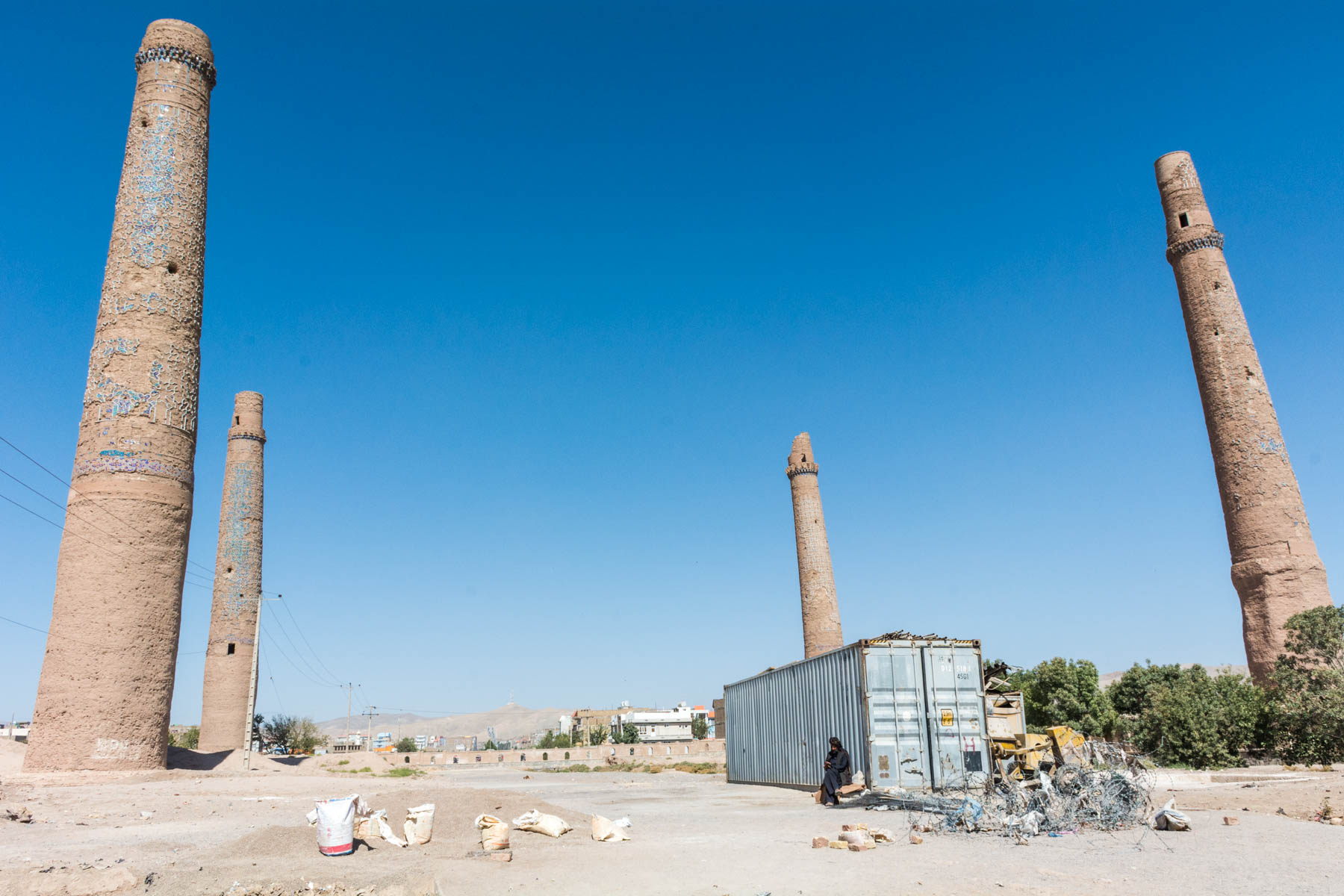
The last standing minarets of the Musalla complex.
Safety in Herat
There is a lot of poverty in Herat, and drug use runs rampant. Herat is growing increasingly dangerous due to poverty, to the point that the police felt the need to let us know that we were not safe and needed to leave certain areas.
Kidnapping is your biggest concern here, so be cautious: don’t wander too late at night, try not to walk the same route every day, and don’t tell people where you’re staying unless you trust them. Try to blend in by wearing a local dress, though female travelers will inevitably get stares if they aren’t in chador or burqa .
If you need help with anything in Herat, the men working in the offices of the citadel are extremely friendly and have a good command of English. Meeting them on one of your first days in Herat can be very helpful. There are also several reputable Couchsurfers in Herat.
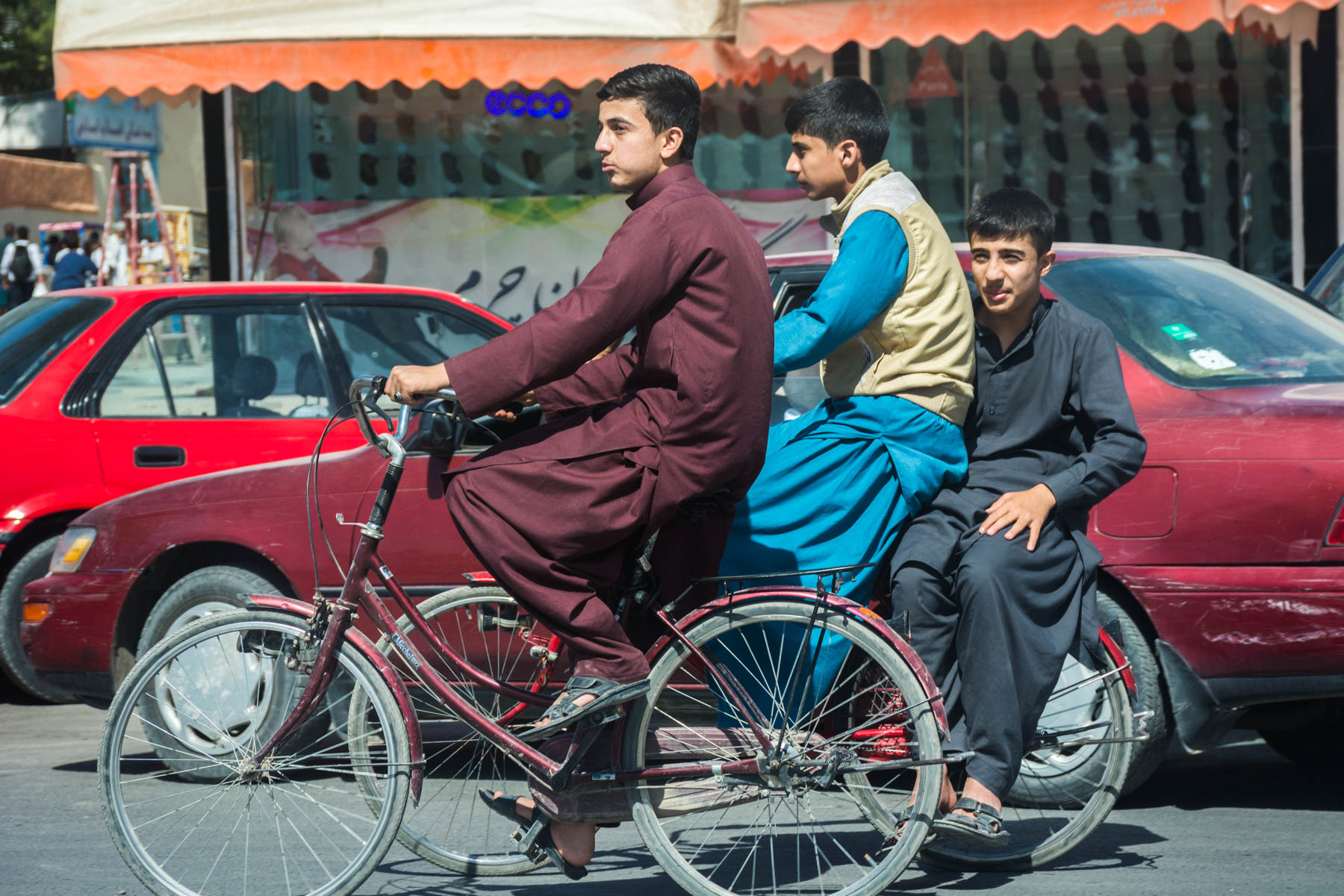
Transportation in/out of Herat
- Bus to Kabul: There is a bus to Kabul from Herat, but we highly recommend you do not take this route . It passes through regions controlled by the Taliban, and even Afghans prefer to fly over these regions. A Couchsurfing host said he does know foreigners that have successfully made the trip, but he suspects they only made it because they could pass as Afghans. If you do take the bus, stay silent so no one knows you’re foreign!
- Ticket to Mazar-i-Sharif: 8,000 Afs/person ($120), Mondays and Thursdays
- Ticket to Kabul: 7,000 Afs/person with Kam Air ($91), 6,000 Afs/person with Ariana Afghan Airlines ($80), daily

The caves around the Buddhas of Bamiyan.
After the tense, concrete jungle of Kabul, Bamiyan is literally and figuratively a breath of fresh air. A stunningly colorful town in the mountains near Kabul, Bamiyan was once home to thousands of Buddhist monks, and a critical point along several Silk Road trade routes. These days, it’s a haven for history buffs and hikers, and it’s even possible to ski or board during the winter!
It’s easy to spend several days in Bamiyan exploring all of its caves, fortresses, and natural areas. You can do so with ease, as Bamiyan is the safest place for foreigners to visit in “mainland” Afghanistan, and its Hazara population is one of the most hospitable in Afghanistan. Thanks to their growing tourism efforts , there are a decent number of people that can speak English, too.
Where to stay in Bamiyan
- Budget: There are several “hostels” along the main bazaar street. This means sleeping on the floor in a room with… whoever else shows up! If a couple, this likely means sharing a room with big Afghan families. A spot in a room is 400 – 500 Afs/person .
- Across the street from the base of the large Buddha
- They’ll assume you want breakfast and dinner here too, for $10 per day/2 people. If you don’t want this, make sure to tell them.
- High end: Highland Hotel – $70 – 90 for a standard room

The red walls of the Shahr-e-Zohak fortress.
Things to do in Bamiyan
Note that a ticket is required to visit certain sights in Bamiyan, which we have marked with an asterisk (*) below. A ticket is 300 Afs and is only valid for one day. The first 3 on the list can be seen in one day. If you ask, the ticketing office has a very informative pamphlet on Bamiyan and its sights.
- Buddha enclaves*
- Shahr-e-Zohak fortress*
- Shahr-e-Gholghola fortress*
- Chehel Situn caves*
- Dara-e-Azhdahar (Dragon Valley)
- Watch the sunset from over the big Buddha or Shahr-e-Gholghola
- Go skiing or boarding (winter)
- Visit Band-e-Amir (see below)
- Foladi ice caves
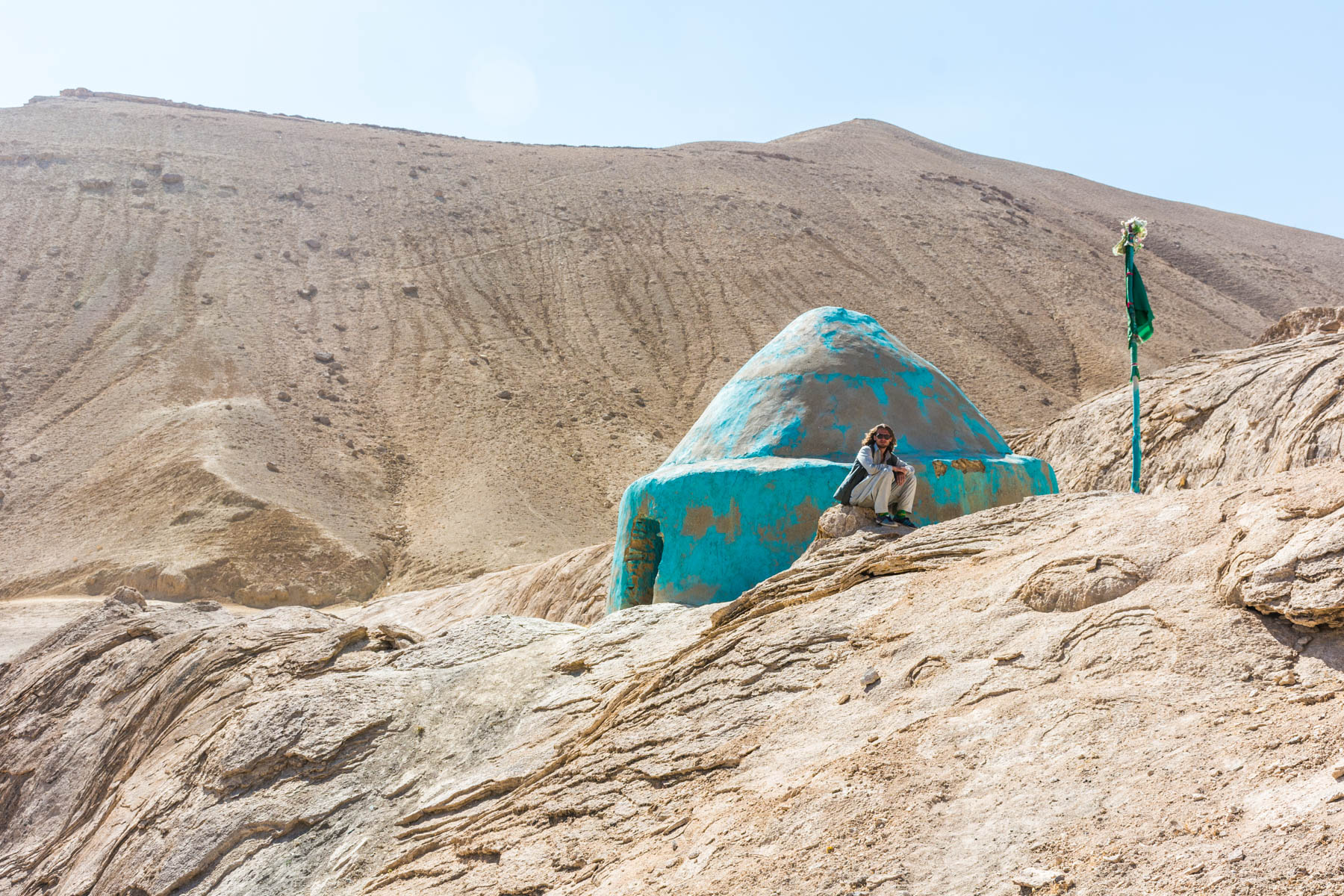
A shrine to Ali in Dara-e-Azdahar, the Dragon Valley.
Safety in Bamiyan
You can walk around in the evenings, stroll to nearby villages, and generally relax. Just be cautious when walking around in nature—the areas around Bamiyan were once heavily mined. Though most mines have since been removed, those that value their legs and/or lives would do good to stick to beaten paths.

Straight cruising on the surprisingly good roads near Bamiyan.
Transportation in/out of Bamiyan
Update 2018: As of November 2018, flights between Kabul and Bamiyan are still sporadic. However, the road going through Ghorband is considered relativley safe. Make sure to talk to local contacts for before going overland.
- Flight days: Wednesday, Thursday, Saturday, Sunday
- Kabul – Bamiyan: 7 AM, arrives 7:30
- Bamiyan – Kabul: 8 AM, arrives 8:30
- Taxi to Shahr-e-Zohak: The fortress is about 18 kilometers from Bamiyan. A taxi there and back should be around 400 – 500 Afs . Official taxis can be found on the main bazaar street. Shared taxis are 150 Afs one way.
- Taxi to Dara-e-Azdahar: About 7 kilometers away from Bamiyan, you can either walk (2-3 hours) or take a taxi. If you’re willing to walk a bit out of Bamiyan, you’ll eventually encounter unofficial shuttle/shared taxis driving up and down the road between Bamiyan and the village in Dara-e-Azdahar. We were picked up by one on our way back, and the several kilometer ride was only 20 Afs/person .
- Taxi to Band-e-Amir: The lakes are about an hour’s drive away. We paid 1,500 Afs for a taxi for the day, and he took us to 3 of the 6 lakes (the third required a bit of persuasion). A shared taxi to Band-e-Amir is 250 Afs one way.
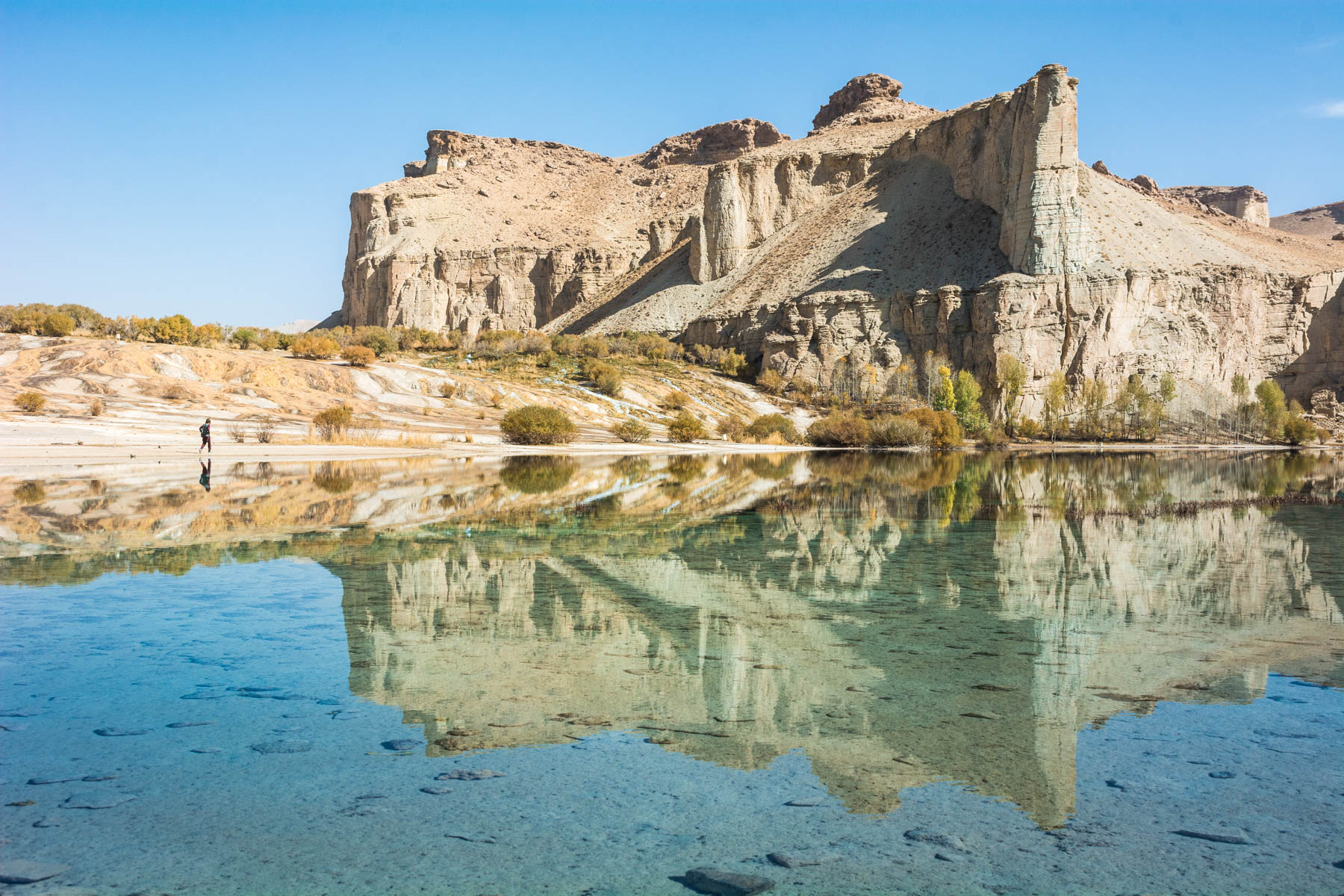
Oh hello gorgeous.
Quite possibly the bluest waters in the world, the 6 lakes of Band-e-Amir are absolutely stunning and a highlight of traveling in Afghanistan. The site of Afghanistan’s first—and only—National Park, they’re a popular summertime destination for Afghan tourists.
Services run around the lakes from March to mid-November. If you visit outside of summer, be sure to bring some extra layers—it gets chilly, especially at night! There was ice on the ground when we visited in October.
Where to stay in Band-e-Amir
- Camping: There’s free public camping space, and public toilets are available throughout the village. However, locals have advised against camping here, as a few people got kidnapped several years ago.
- Budget: The Dir Hotel/chaikhana near Band-e-Haibat, the most popular lake, offers a mat on the floor for 100 Afs .
- Sign for the property is on the left of the main road through the Band-e-Amir village

The famous swan paddle boats in Band-e-Haibat lake.
Things to do in Band-e-Amir
Sights are free, but you need to pay a 200 Afs park entrance fee when approaching the town.
- Walk around the lakes (… duh)
- Take a ride in the tacky swan paddle boats in Band-e-Haibat
- Bathe in the waters, which supposedly have healing powers; women can bathe in the small hut near the Band-e-Haibat waterfall
- Visit the shrine to Hazrat Ali
Safety in Band-e-Amir
Band-e-Amir, like Bamiyan, is safe. However, the mine issue still applies—stick to paths and marked areas.
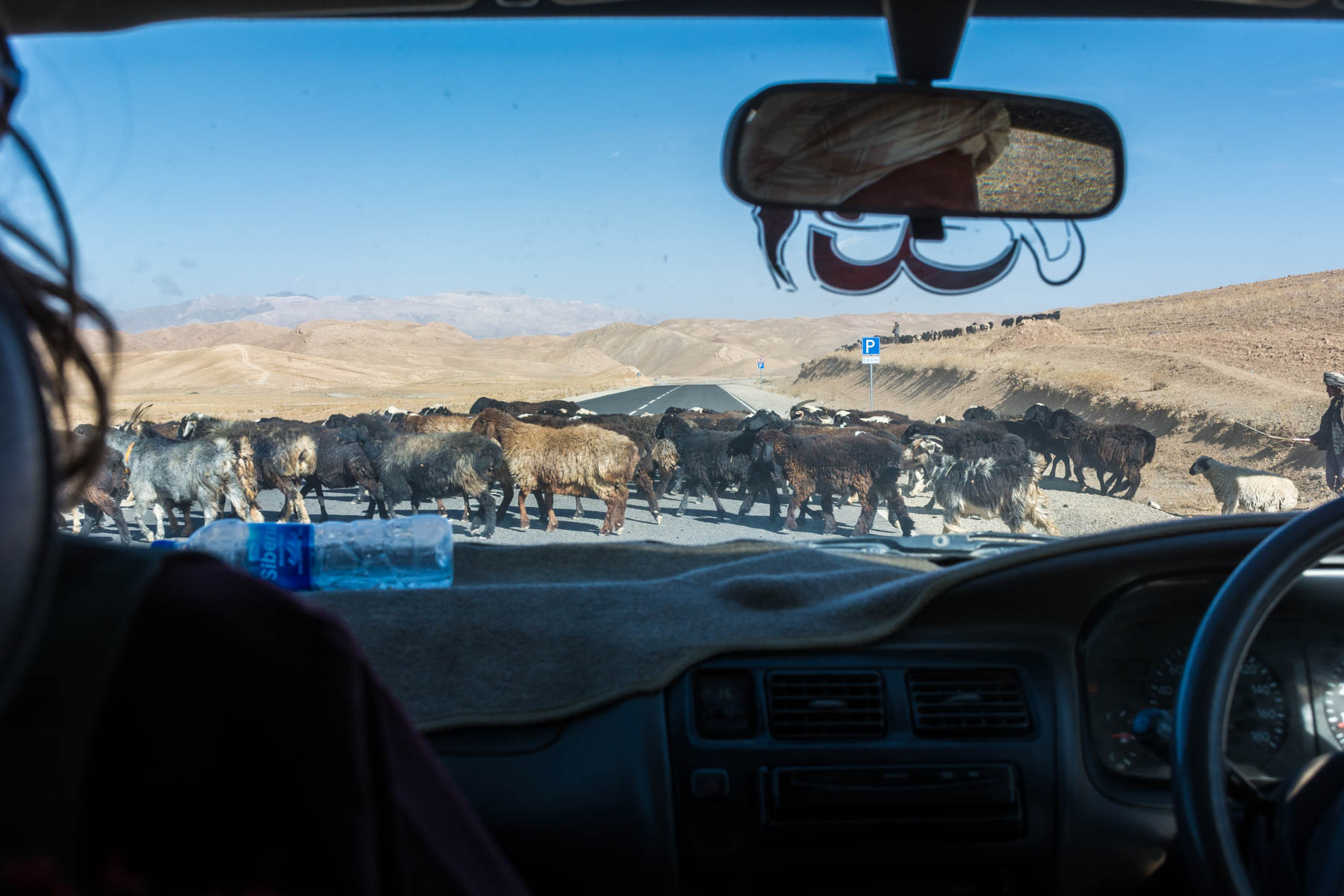
A rather furry roadblock near Band-e-Amir.
Transportation in/out of Band-e-Amir
- Bus to Bamiyan: According to Wikitravel , a minibus from Bamiyan to Band-e-Amir runs on Thursday afternoon and Friday mornings in the high season. Ask a local to verify this (and let us know if you find it!).
- Taxi to Bamiyan: It’s best to arrange a taxi to take you from Bamiyan to Band-e-Amir and back. Ours was 1,500 Afs for a day trip (organized by the friendly owner of Caravanserai), but the price could go as high to 2,000 – 3,000 Afs . If you’re lucky you can also get a shared taxi for 250 Afs one way.
The former capital of the Durrani Empire is steeped in history and houses some of the most significant religious sites in Afghanistan. Founded by Alexander the Great, the city plays a significant role in the history of Afghanistan and was the first capital of the Afghan Empire under Ahmad Shah Durrani
Deemed too unsafe for travel until recently, the city itself is now reasonably safe. However, we highly recommend to make locals contacts before you go, as showing up by yourself is not recommended. Between Taliban activity in the surrounding areas and an almost overzealous security apparatus in the city, Kandahar is not a place you should navigate by yourself. Couchsurfing is your friend.
Where to stay in Kandahar
As we said above, you should have a local contact with whom you can stay, or who can make sleeping arrangements for you in Kandahar. Kandahar is not used to seeing foreign tourists, and most hotels or guest houses won’t allow you to stay.
However, if you can’t find anyone to host you, there are two options you can check out to stay in Kandahar
- Budget: Armani Hotel – Charges $22 for a double. You can email them for more info.
- Mid-range: Continental Guest House – Costs $55 for a double and they have a pleasant courtyard.
Things to do in Kandahar
With so much history, there is a lot of ground to cover in Kandahar. Some of these places are a bit outside of the city, so it’s recommended you visit them with a local contact.
- Mosque of the Cloak of the Prophet
- Mosque of the Hair of the Prophet
- Tomb of Ahmad Shah Durrani
- The 40 Steps (Chilzinia) – a security checkpoint was set up near the entrance when we were there, and our host said they would not let us in
- Mausoleum of Mirwas Khan Nika
- Orange Palace and Old Kandahar
- Shrine of Baba Wali Kandhari
- Sarphosa Bazar
Safety in Kandahar
The recently murdered police chief of Kandahar, sometimes referred to as torturer in chief , has done a lot to clean up the city, although as his nickname suggests, through brutal means. So the city itself is relatively safe, and there might be a stronger police presence here than even in Kabul. However, the surrounding areas are still filled with both Taliban and drug cultivators, so make sure to keep a low profile and dress locally.
Transportation in/out of Kandahar
The only viable way to get to Kandahar is by flying. The road between other major cities runs through Taliban controlled areas, and the road between Kabul and Kandahar leads through areas that have seen an increase in violence.
- Flights to Kabul: Daily flights by both Kam Air (6,400 Afs/$85) and Ariana Airlines (5,400 Afs/$70).
The stunning Wakhan corridor is the only certifiably safe place in Afghanistan, and also the country’s most visited when it comes to foreign tourism. Far removed from the rest of the country, the little panhandle is filled with Kyrgyz and Wakhi people, who are different from the “mainland” Afghans.
It’s an incredibly remote area, to the point that some people in the region don’t even know that the Taliban exist . If it’s hiking and camping that you’re interested in, the Wakhan is the place for you. Note that it can only be accessed by crossing over from Tajikistan unless you’re interested in traveling through Taliban-controlled areas. (Hint: don’t.)
We didn’t go to the Wakhan ourselves, but since it’s a (relatively) popular destination, there are plenty of other resources about it on the internet! For more information, check out:
- Backpackingman’s guide to hiking in the Wakhan Corridor
- Expert Vagabond’s guide on how to travel Afghanistan’s Wakhan Corridor
- Caravanistan’s guide to the Wakhan Corridor
- End of the road, beginning of the journey
Getting around in Afghanistan
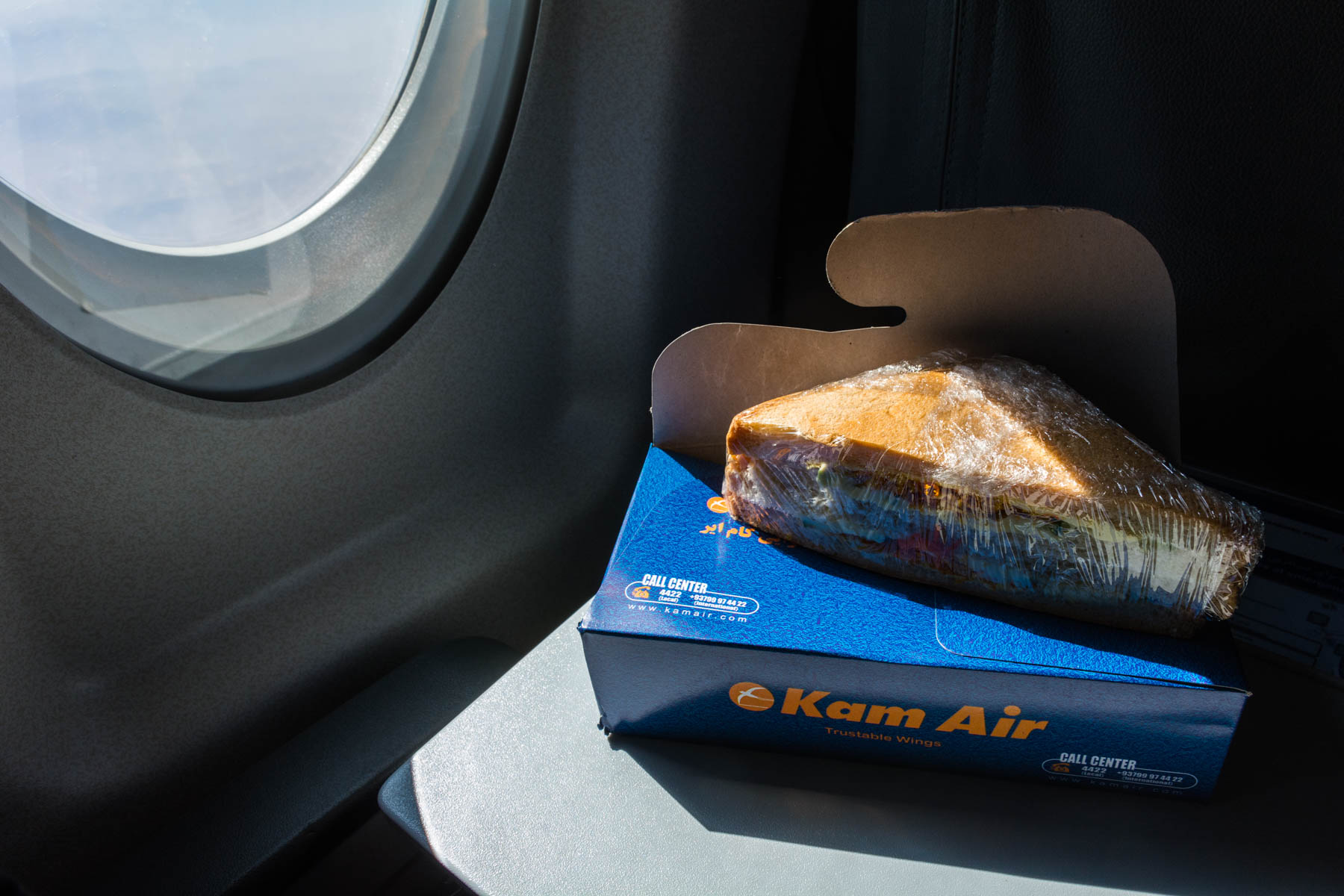
The grossly ubiquitous dried chicken sandwich served on all Kam Air flights.
Airlines in Afghanistan
Kam Air and Ariana Afghan Airlines are Afghanistan’s two main carriers. Ariana is generally a little bit cheaper than Kam Air, but Kam Air has a better reputation.
Where to buy tickets
You’ll most likely be buying your tickets with cash, so stock up! Domestic tickets can be booked in person with your passport at a travel agency or airline office. Tickets can also be booked online. Try to book several days in advance, especially for Bamiyan (if flights resume), as tickets can sell out fast. International tickets can be purchased on whatever websites you normally use, although it pays to see what local operators charge.
Airports in Afghanistan
Airports in the country are layered in defenses, thanks to a history of attacks targeting airports. Be sure to arrive about two hours before flights, allowing time to go through the multiple levels of security. Each airport has several bag scans, body searches, and bomb-sniffing dogs.
Women have to go through a separate area for body searches. The women’s check is usually hidden behind a fluttering curtain off to the side.
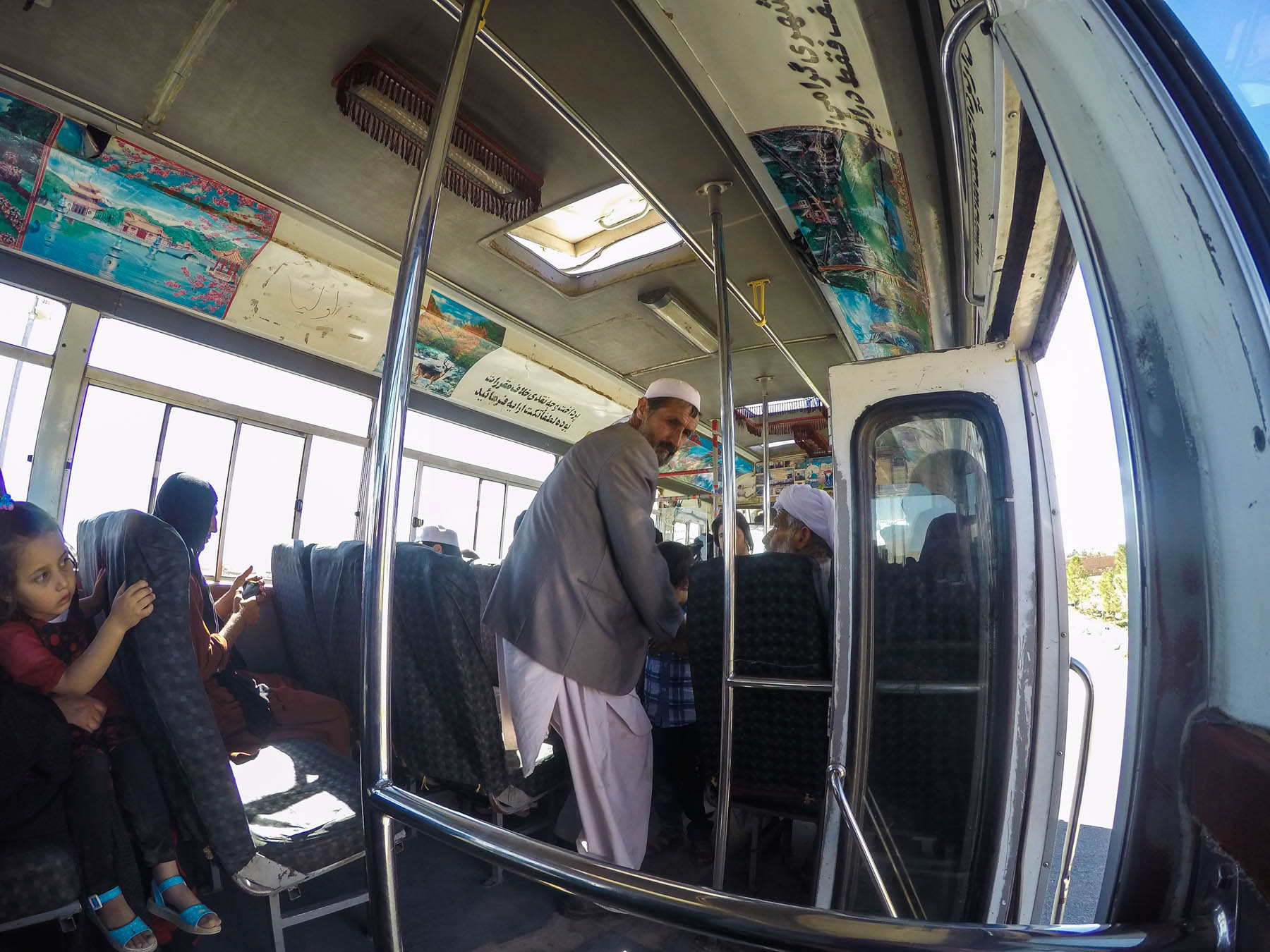
Buses in Afghanistan
Long-distance buses.
The only known “safe” long-distance bus route foreigners can take is the Kabul – Mazar-i-Sharif bus. However, during our first visit the road was deemed unsafe for civilian travel. Check with a local to see if the road is safe for transportation while you’re there.
Inner-city buses
These buses can get cramped, but at around 5 – 10 Afs per ride, they’re cheap transport that can’t be beaten. They have set bus stops, though you can always try and hop off in-between. Generally, men sit in the front and women in the back, though couples can sit together in the middle.
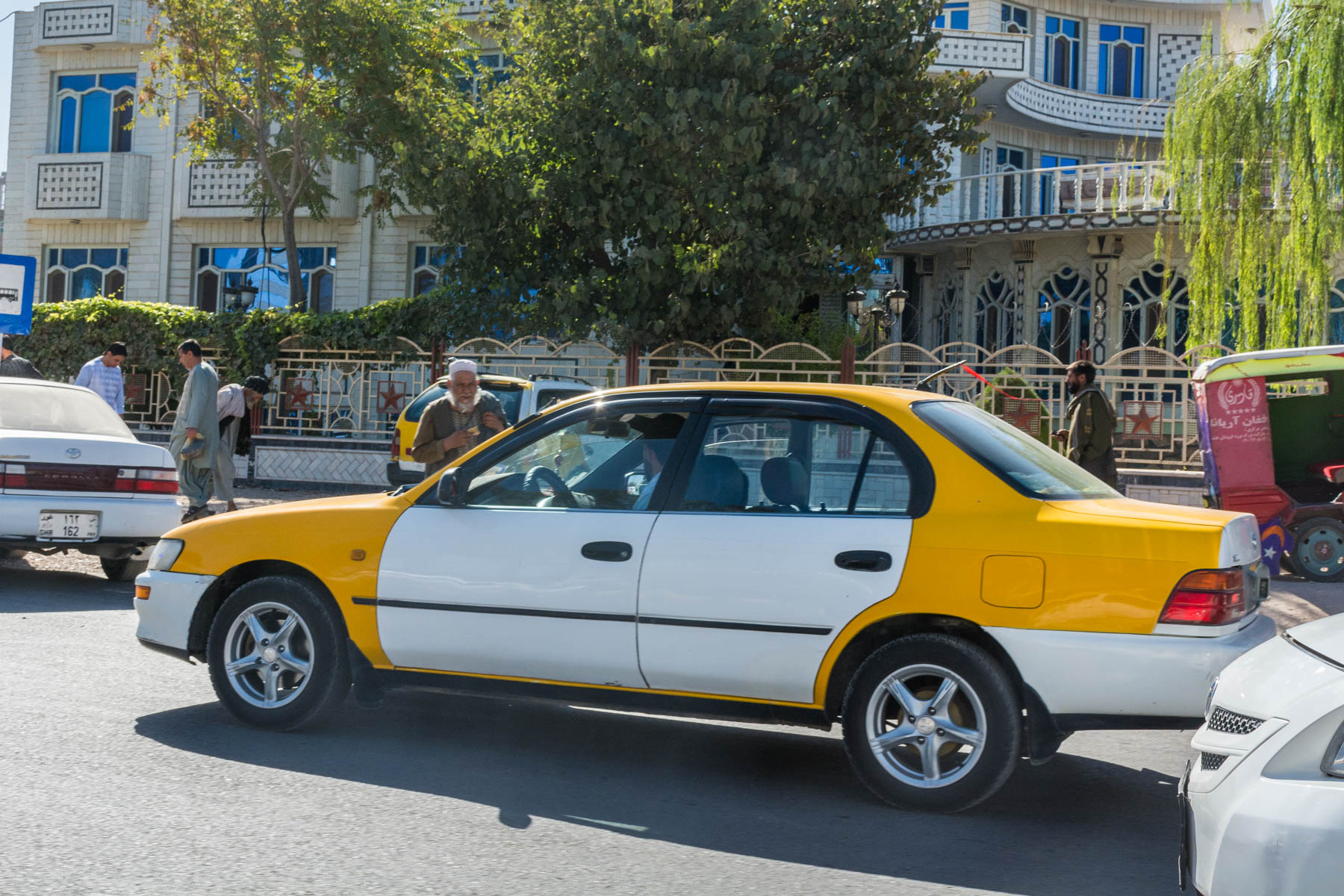
Private taxis
Yellow (ish) taxis can be found in all of the major Afghan cities, and a handful outside of the city limits, too. There are no meters, but an inner-city ride can start at around 50 Afs , and should never be more than 200 Afs , though you might have to bargain hard at times. Always decide on a price upfront! Aim for 2/3 of the quoted price, unless it seems abnormally high.
In practice, any car willing to stop can be a taxi. It’s up to you to decide if you want to take the ride—for security reasons, it’s a bit safer to stick with the yellow cabs if you’re by yourself.
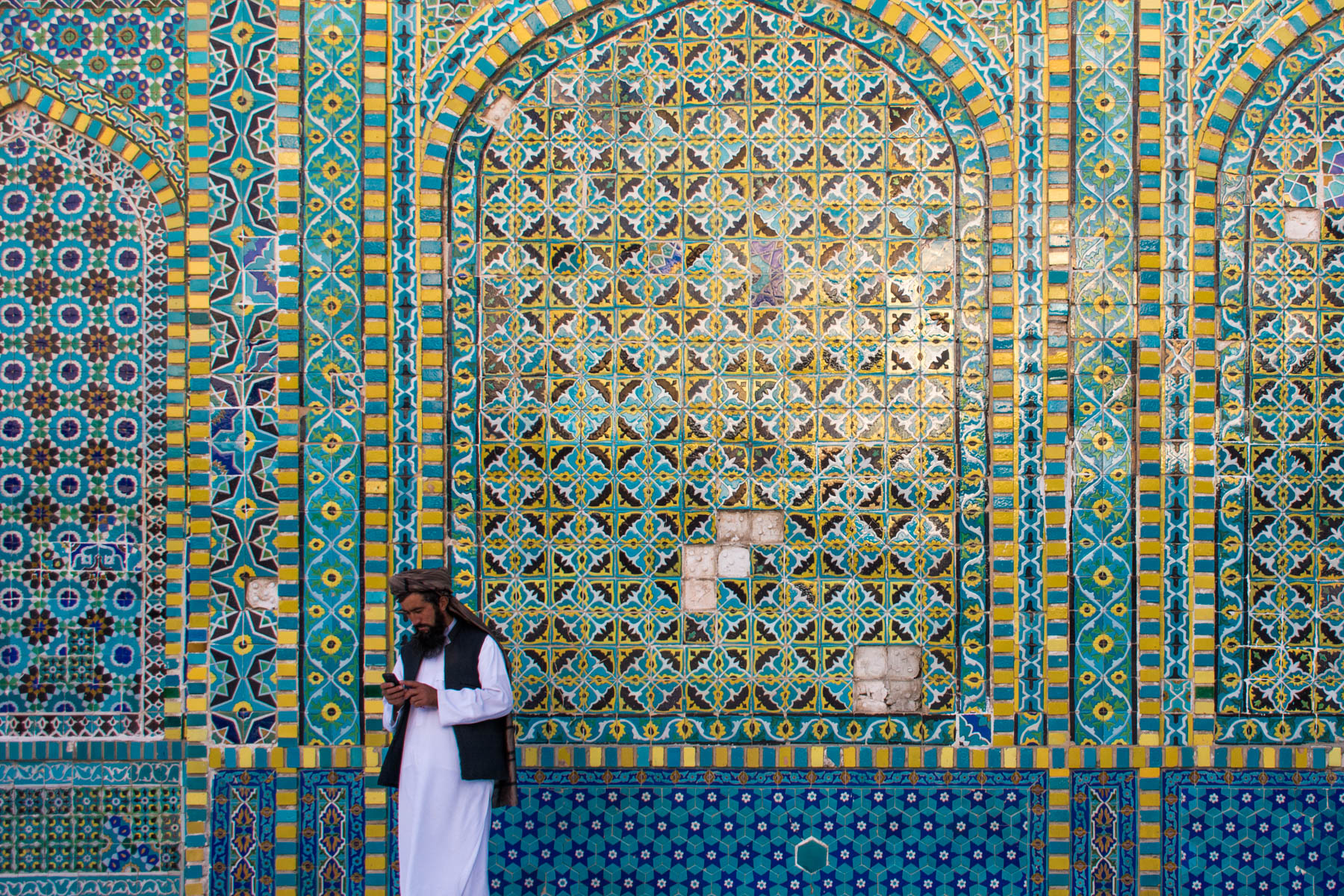
Calling and internet in Afghanistan
If you want to stay connected while in Afghanistan, Roshan or Afghan Wireless (AWCC) are your best bet for phone service. MTN and Etisalat are two other options. Wifi can be found in most hotels, though whether or not it works depends on Allah’s mood.
Sim cards can be purchased at any official carrier office. Bring your passport, and prepare to have fingerprints taken. Calling credit top-up/scratch cards can be purchased from vendors on the street, or in mobile stores. Note that street vendors only sell top-up for calling and SMS; you’ll have to go to a mobile store for data top-up.
We used MTN (because lazy, ignorant, and the store was right there) , and coverage was decent to good in all of the cities we visited, except Kandahar, where AWCC worked much better than MTN.
Prices for Roshan service
- Sim card and 25 Afs credit – 50 Afs
- 3GB /month data – 350 Afs
- More prices on the Roshan website
Prices for Afghan Wireless
- 1GB /month data – 150 Afs ($2.30)
- 3GB /month data – 400 Afs ($6)
- More prices on the Afghan Wireless website
Prices for MTN
- 2.5 GB /month data plan + sim card – 500 Afs
- 1 GB top-up – 350 Afs (must be done at an official MTN store)
Everything else you need to know when traveling to Afghanistan
Culture in afghanistan.
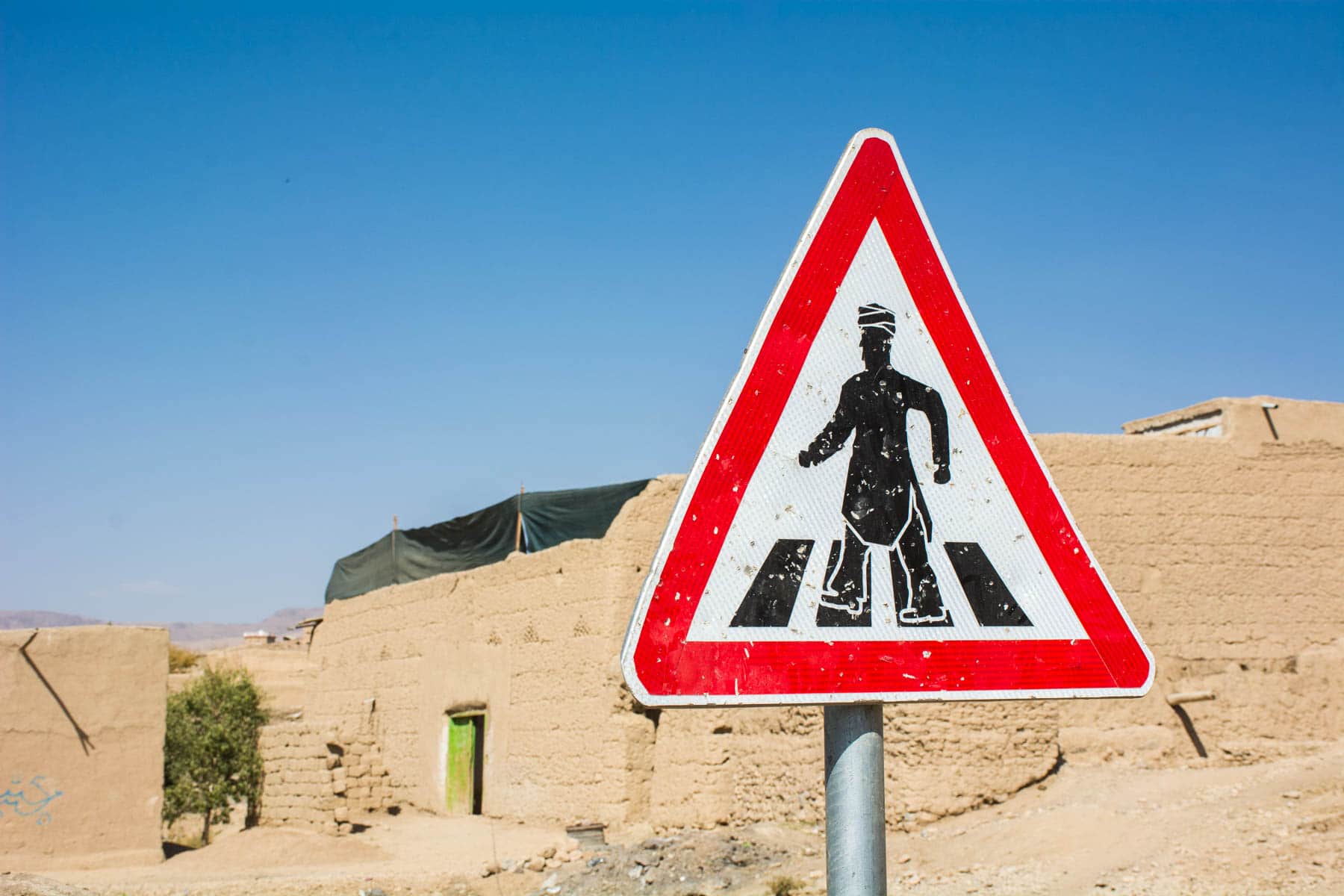
Caution: cultural crossing ahead.
What to wear when traveling in Afghanistan
Dressing in local attire is essential for blending in and reducing the amount of attention you get. It’s also a great icebreaker when talking to Afghans! They’ll be super amused (and pleased) to see you in local garb.
For the boys
Most men in Afghanistan dress in loose, comfortable shalwar kameez, also known as perahan tunban , which consists of a long shirt and baggy pants. The shirt and pants must be the same color, and it’s traditional to wear a vest, sportscoat, or Afghan scarf over it.
It’s possible to buy premade shalwar kameez , but for the best effect, pick up some fabric in a store and get one tailored. Fabric should cost around 300 – 800 Afs , and getting an outfit tailored around 300 – 400 Afs .

Getting measured for a shiny new shalwar kameez at a tailor in Bamiyan.
For full effect, don a pakol , the round, flat, woolen hats favored by Pashtuns. You can buy one for a couple of hundred Afghanis in bazaars.

Some other tourists trying to blend in with perehan tunban and pakol hats.
If you’re not interested in being comfortable (… but… why?) some men also wear western clothes, especially in Kabul. Jeans and a shirt are quite a common sight, and short sleeves are acceptable. Avoid shorts.
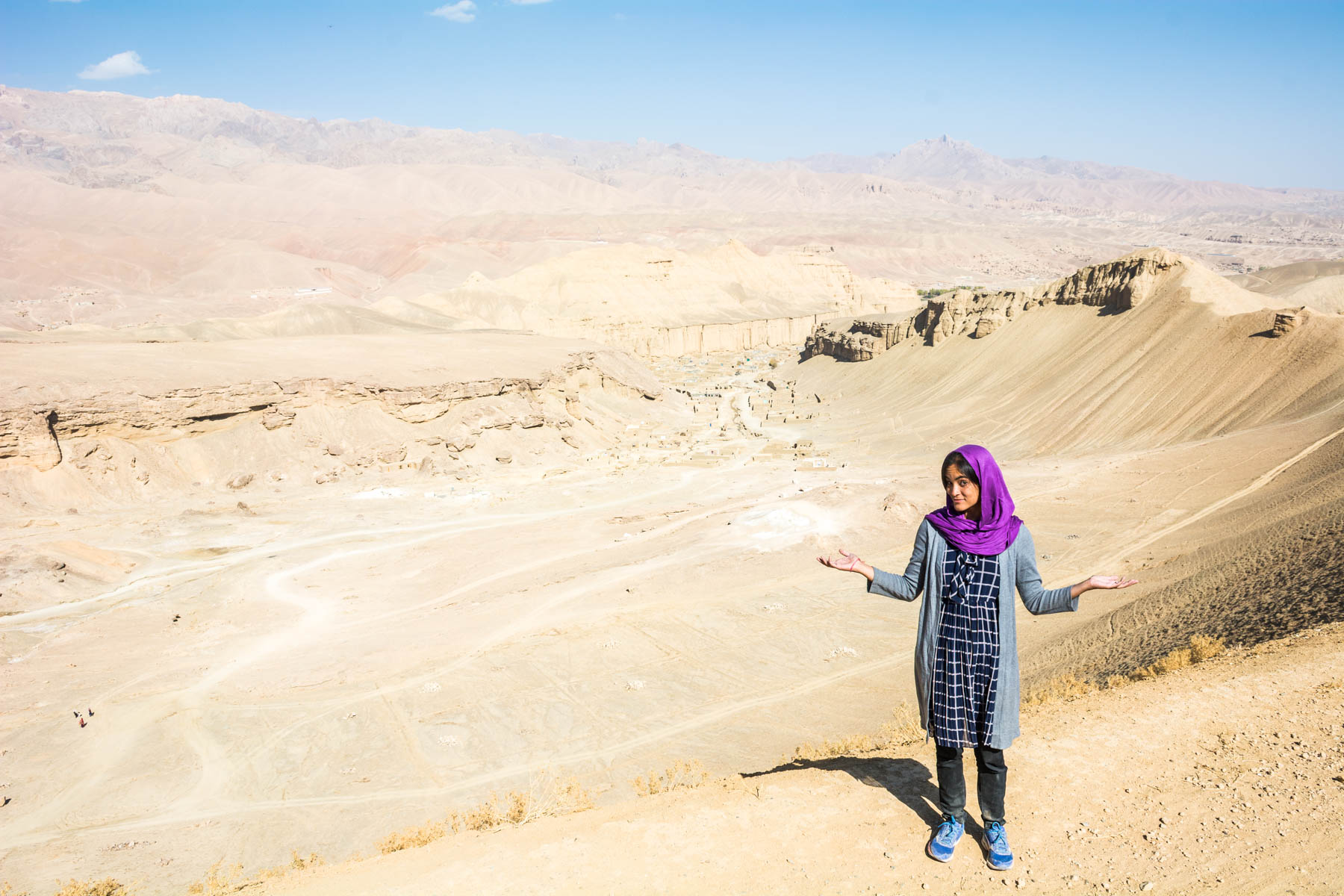
For the girls
As you could’ve guessed, clothing options are much more restricted for the ladies.
Women in Afghanistan must dress according to hijab , Islamic modest dress. This means:
- Long sleeves. 3/4 length sleeves are passable, though not common everywhere.
- A long shirt/tunic/dress that covers your bum.
- Long pants or skirts. Skinny jeans are okay. Just don’t wear any shorts or short skirts.
- A headscarf. Head covering isn’t required by law, but if you don’t wear one, you will be the only woman on the street without a head covering.
- Open shoes are okay, though your feet will get quite dusty! Know that it’s not very common to see trainers/sneakers on the streets, especially the colorful variety that are popular now. We suggest buying shoes once you get to Afghanistan to help you blend more.
Accessories
Flashy items such as fancy watches and expensive cameras can draw unwanted attention. Your best option is to buy a bag in a bazaar upon arrival and carry your camera in it.
Fancy hiking packs will also draw attention, but plenty of men carry around simple backpacks. Women usually carry generic leather bags, which can also be purchased in bazaars for a dime a dozen.
For more information, check out our guide on female travel in Afghanistan .
How to act in Afghanistan
If you’ve traveled in Iran, you’ll be familiar with the concept of tarof , a form of politeness. A similar practice often occurs in Afghanistan.
People will often try to reject payment for their services or offer you something for free, whether it be a cup of tea or a taxi ride. Politely insist several times that you can’t accept it for free and want to pay—they’ll usually give in quite quickly.
If not, and you’re uncomfortable with accepting what they’ve provided for you, a handshake with some money in it will often be accepted. Gotta save face!
Photography in Afghanistan
Be wary when snapping photos in Afghanistan. A small camera can fly under the radar, but a big DSLR can attract (too much) attention! When taking photos, keep the following tips in mind:
- Ask before photographing anyone, especially women. Just as you shouldn’t stare at women in burqa, you shouldn’t take photos of them willy-nilly and up close, either.
- Carry your camera in a bag. A camera advertises the fact that you have money, and that’s not good in a country as poverty-stricken as Afghanistan.
- Be subtle about taking photos. If people see you taking photos, they might crowd around you and ask to have their photo taken, or a photo with you instead. Crowds attract attention, and that’s the last thing you want as a foreigner.
For a more nuanced explanation, see Chasing the Unexpected’s guide to photographing Afghanistan while staying safe .
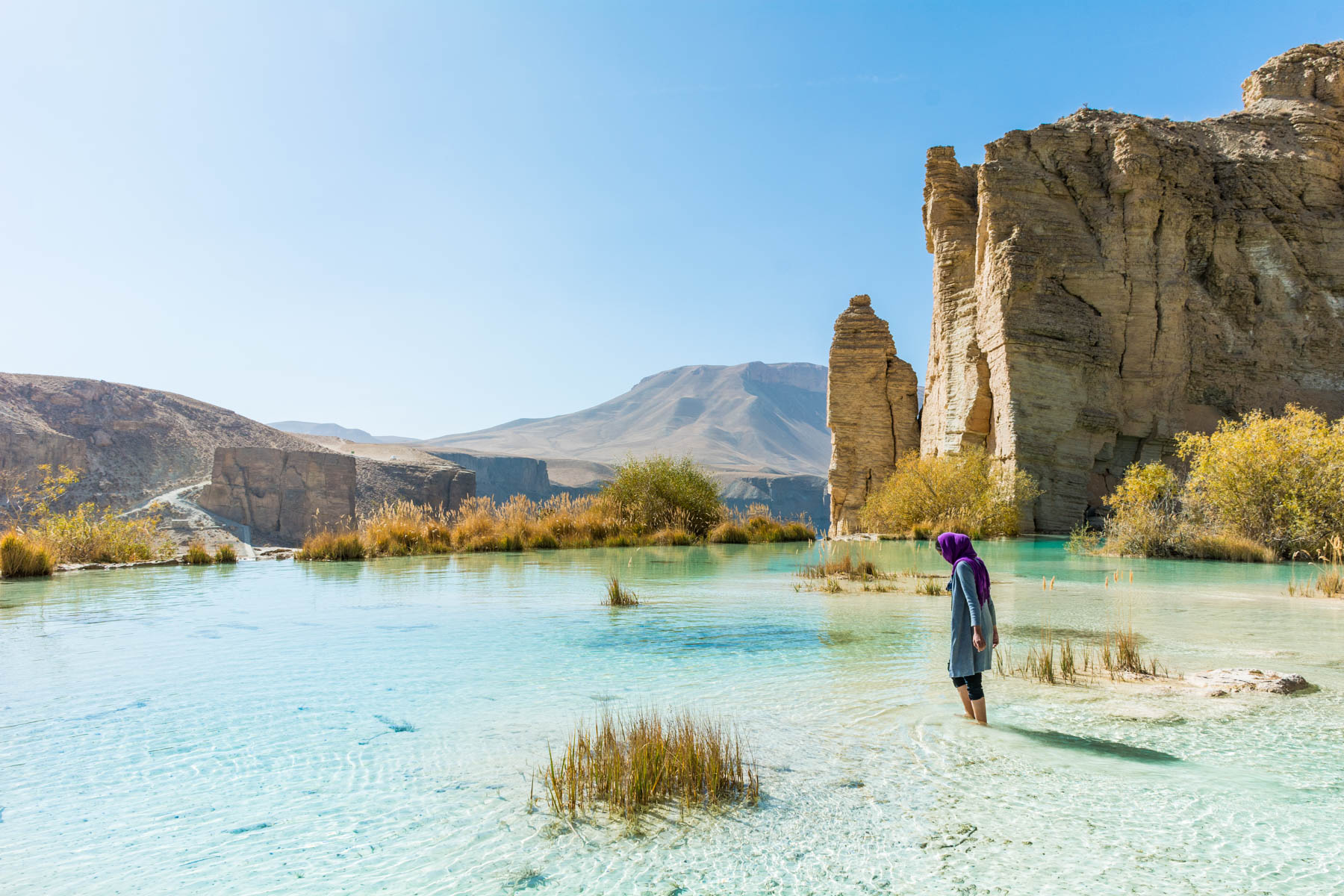
Gettin’ scandalous with rolled-up pants in Band-e-Amir.
Women travel in Afghanistan
Afghanistan is one of the worst places in the world to be a woman, and as such, traveling as a woman in Afghanistan requires a bit more consideration. We’ve put together a post on what it’s like to travel as a woman in Afghanistan , but for now, some quick tips:
- Always dress in hijab , Islamic modest dress. See the what to wear section for more information.
- In restaurants, women and families eat in a separate area. This could be a whole separate seating area or a small area in the back separated by a curtain. You can sit in the men’s area, but you’ll get a lot of stares and will make people uncomfortable in small restaurants.
- Accept that if traveling with a guy, you’ll initially be ignored. Men will direct comments and questions to your male companion first, though if you’re persistent or they’re more liberal, they’ll start talking to you eventually.
LGBTQ travel in Afghanistan
We’re not gay, so we can’t give firsthand accounts. But, as you might have guessed, being gay is not okay in Afghan society. Men, however, are very intimate and touchy with each other, and you’ll see men holding hands often.
Same-sex couples, just be discreet and say you’re friends. No one will know unless you tell them… or start making out in public (not advised).
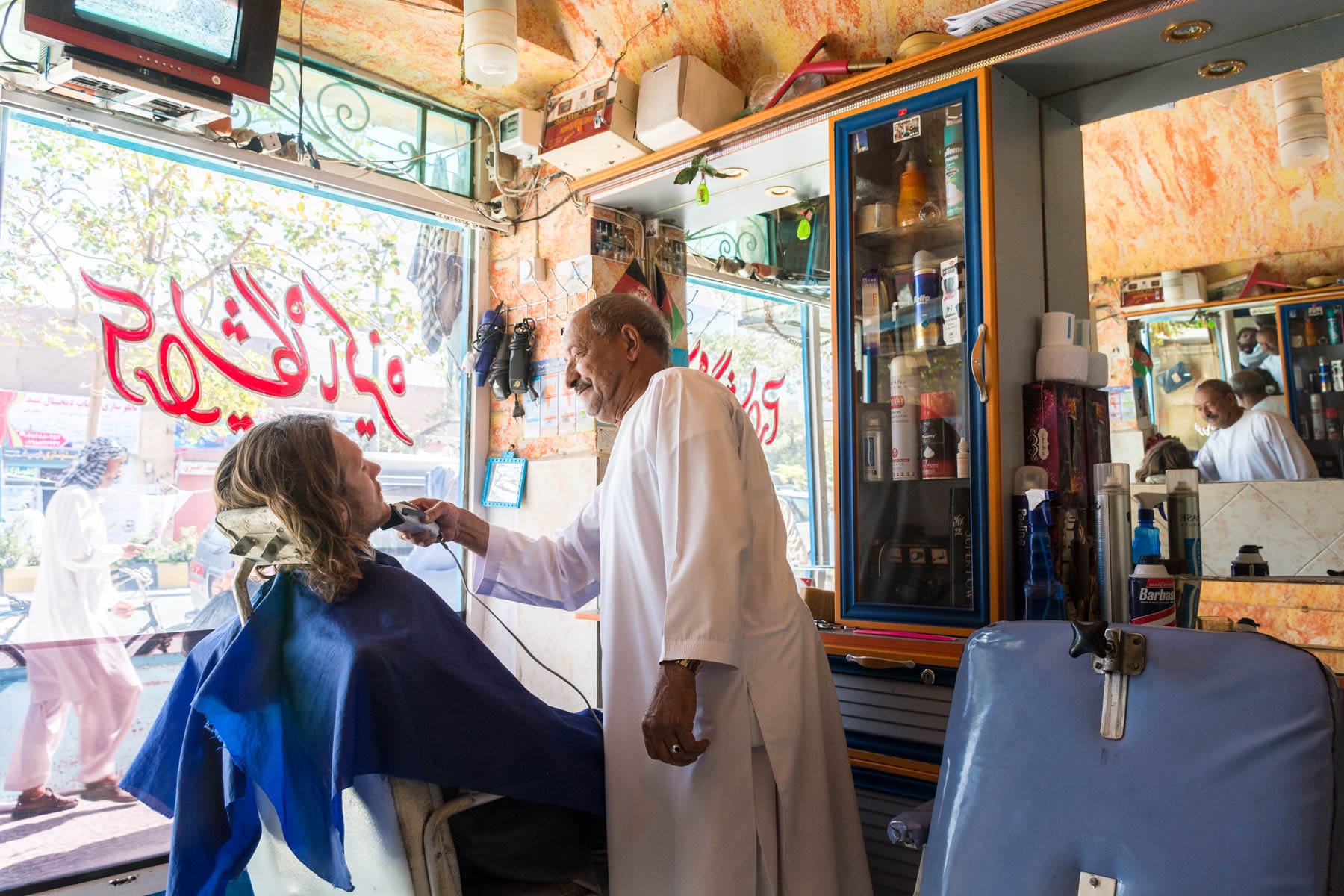
Getting a straight razor shave in Herat for less than $1. Not bad!
Financials in Afghanistan
Once you’re on the ground, Afghanistan isn’t particularly expensive—it’s on par with the rest of Central Asia. It’s flying that will strain your wallet, as a one-way ticket between cities will be somewhere around $100 despite a short flying time.
To get a more thorough idea of budget, check out our report on how much it costs to travel in Afghanistan .
Average costs for travel in Afghanistan
- Total per day: 3,858 Afs / €54 / $59
- Food and drinks per day: 400 – 700 Afs/ €5.55 – 9.70 / $6.15 – 10.80
- Accommodation per day: 1,300 – 2,000 Afs / €18 – 28/ $20 – 30
Note: Prices for accommodation are per room. However, solo travelers can bargain for a discount.
- Flight between cities: 3,250 – 7,150 Afs/ €45 – 99/ $50 – 110
- Taxi for a day trip: 1,300 – 3,250 Afs / €18 – 45 / $20 – 50
- Taxi around town: 1,00 – 3,00 Afs/ €1.35 – 4.15/ $1.55 – 4.60
- Entrance to tourist sights: 0 – 800 Afs / €0 – 11.10 / $0 – 12.30
Money saving tips for Afghanistan
- Haggle at hotels . The price is very often flexible, and it’s not unheard of for hotels to mark up prices for foreigners. Make sure to practice your charming foreigner persona.
- Use Couchsurfing . It can be tricky to find someone to host you due to security issues, but it’s definitely possible.
- Aim for 70% of the quoted price for taxis. We found drivers in Afghanistan to be fair (most of the time). A host told us it’s offensive to counter with too low an offer, so don’t halve the price unless the driver is really ripping you off.
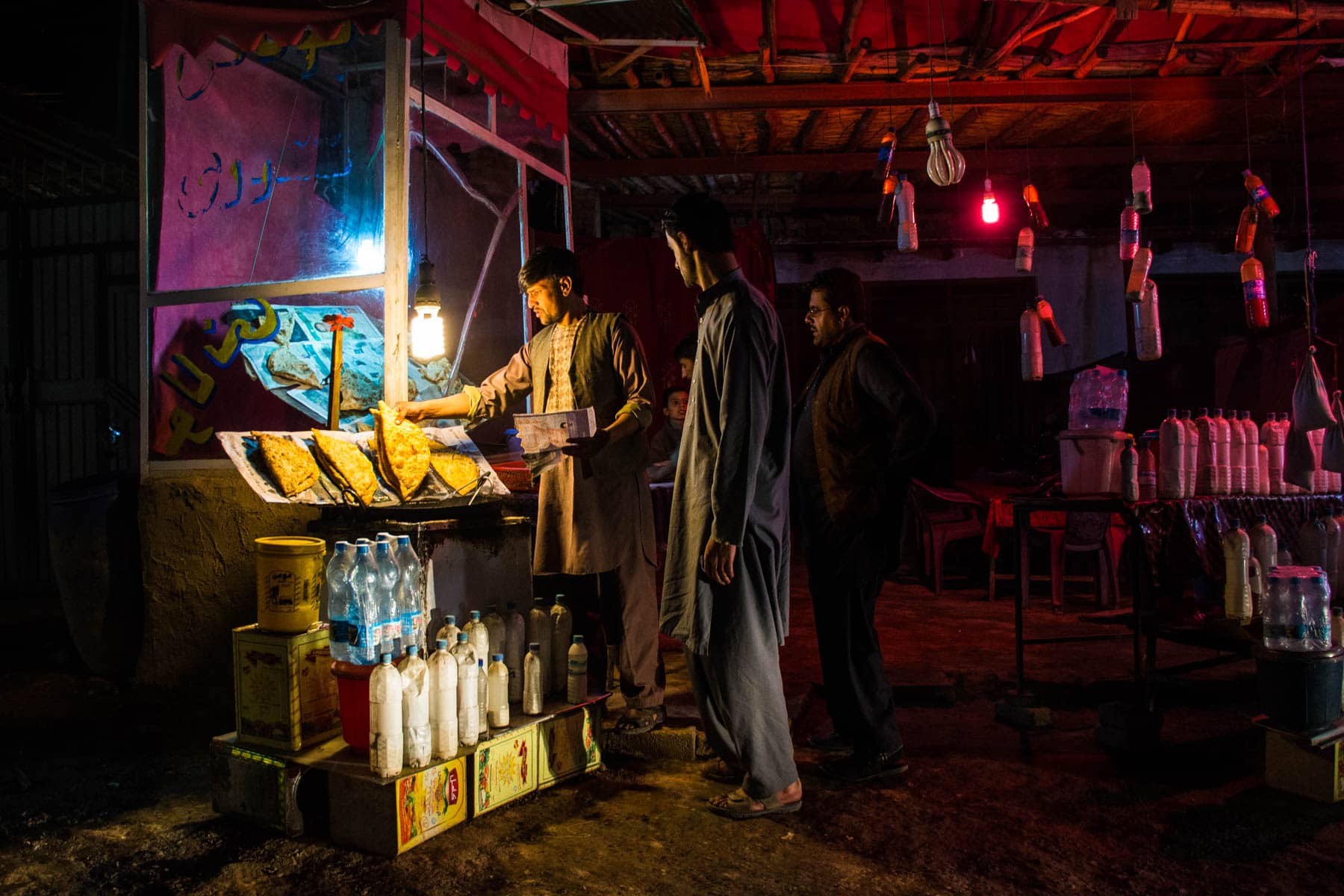
Picking up some noms after dark. Okay because we were with a local… right?
Safety in Afghanistan
Safety is the most essential part of travel in Afghanistan! Like we’ve said already, “safe” is relative, but there are some measures you can take to reduce the risk of anything happening to you.
Try to avoid walking around much after dark, unless accompanied by a local. More importantly, avoid traveling between cities after dark, as this is when the Taliban will set up unofficial checkpoints on the roads.
If you need something after dark and aren’t comfortable going outside, hotel and guesthouse workers will be happy to get things for you (often for a small fee).
Dress like a local
Anything helping you to blend is a good idea. It might seem fruitless, but Afghans are much more diverse in color than you might expect—even blondes can blend in Afghanistan! See the What to wear section for tips on local dress.
Don’t wander around shouting in your local language—it advertises the fact that you’re foreign! Word travels fast in Afghanistan, and the fewer people realize there are foreigners wandering around, the better.
This holds especially true on local buses. If someone realizes there’s a foreigner on the bus, they could call ahead to a friend, who could arrange a mishap further down the road. People get money if they turn in others to the Taliban, so beware.
The police in Afghanistan are there to help, so cooperate, and if you need anything or see anything suspicious, let them know.
We had two run-ins with police/intelligence. They accosted us out of nowhere, didn’t speak any English, and were a bit aggressive at first, so we were on our guard. Turns out they just wanted to let us know that Afghanistan is dangerous and we should be careful!
Know your consulate
It’s always smart to know which embassy or consulate you can turn to in case of an emergency. If your country doesn’t have representation in Kabul, look for a neighbor or ally’s embassy.
List of diplomatic missions in Afghanistan
Health in Afghanistan
Food and water.
Hygiene is important in Afghan culture—you’ll see people washing their hands before and after every meal, and you should do the same!
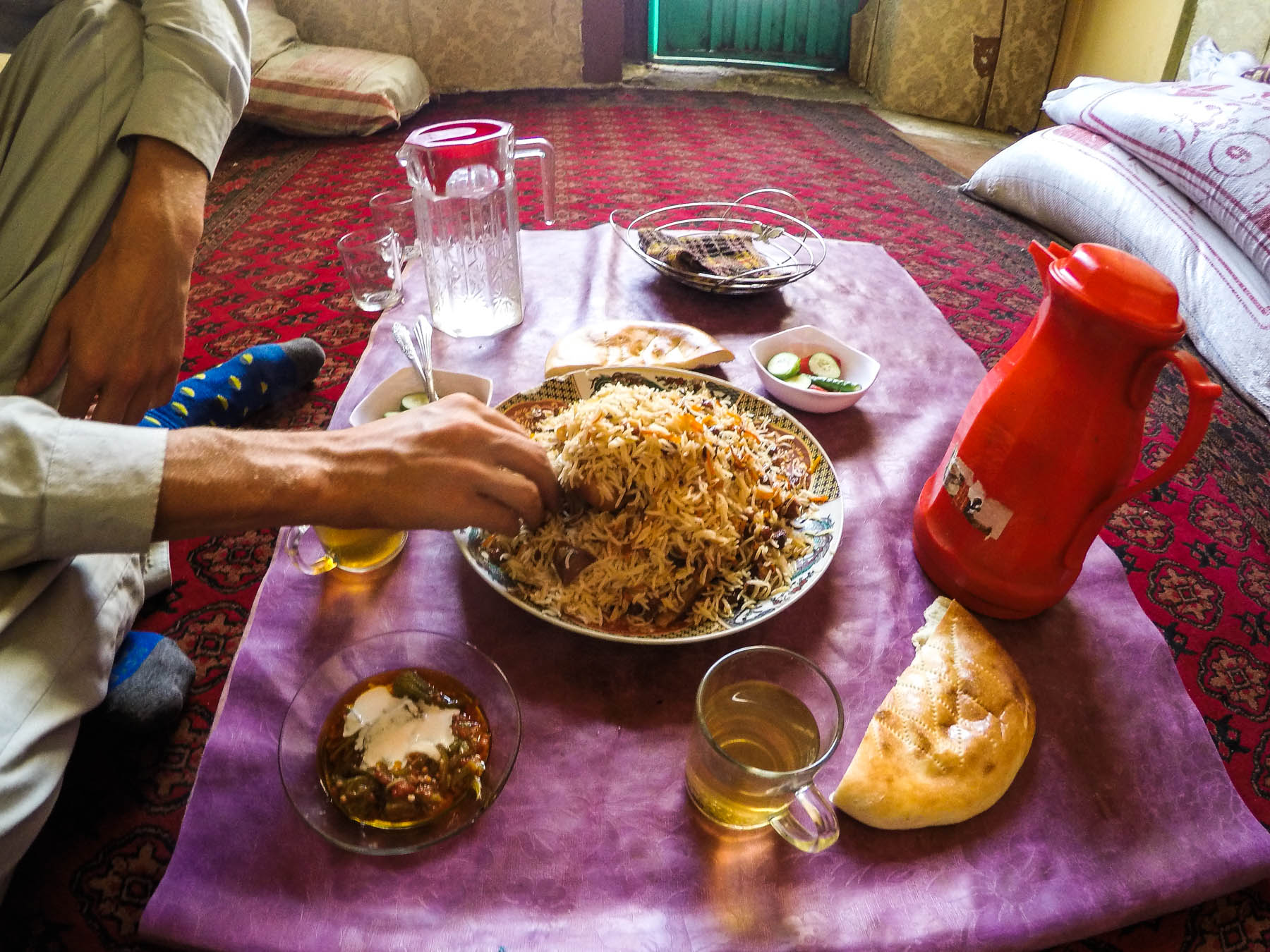
The ever-ubiquitous Kabuli pulao. Delicious as it may be, prepare to OD on it!
… but this doesn’t mean everything is squeaky clean. Food-related illnesses are common in Afghanistan, so use your discretion around feeding time. Tap water is a big no-no, and avoid anything made with ice unless eating at higher-end or family establishments.
Vaccinations
Standard travel vaccines are recommended but not required. See this vaccination list from the CDC for more details.
There are plenty of small clinics to be found around the cities, but if looking for top quality medical treatment and/or someone that speaks English, Westex Medical Solutions in Kabul caters to foreigners. They’re incredibly friendly, speak excellent English, and will give you a discount if you tell them you’re just a traveler, not an aid worker.
Note that their address has changed from what’s listed online—they’re now found on Sherpoor Road, Street 4 in the Wazir Khan district of Kabul.
News resources
For the best and most thorough news coverage of what’s going on in Afghanistan, use these sites:
- Azadi Radio (in Pashto and Dari)
And of course, don’t miss out on other international news sources:
- Al Jazeera Afghanistan
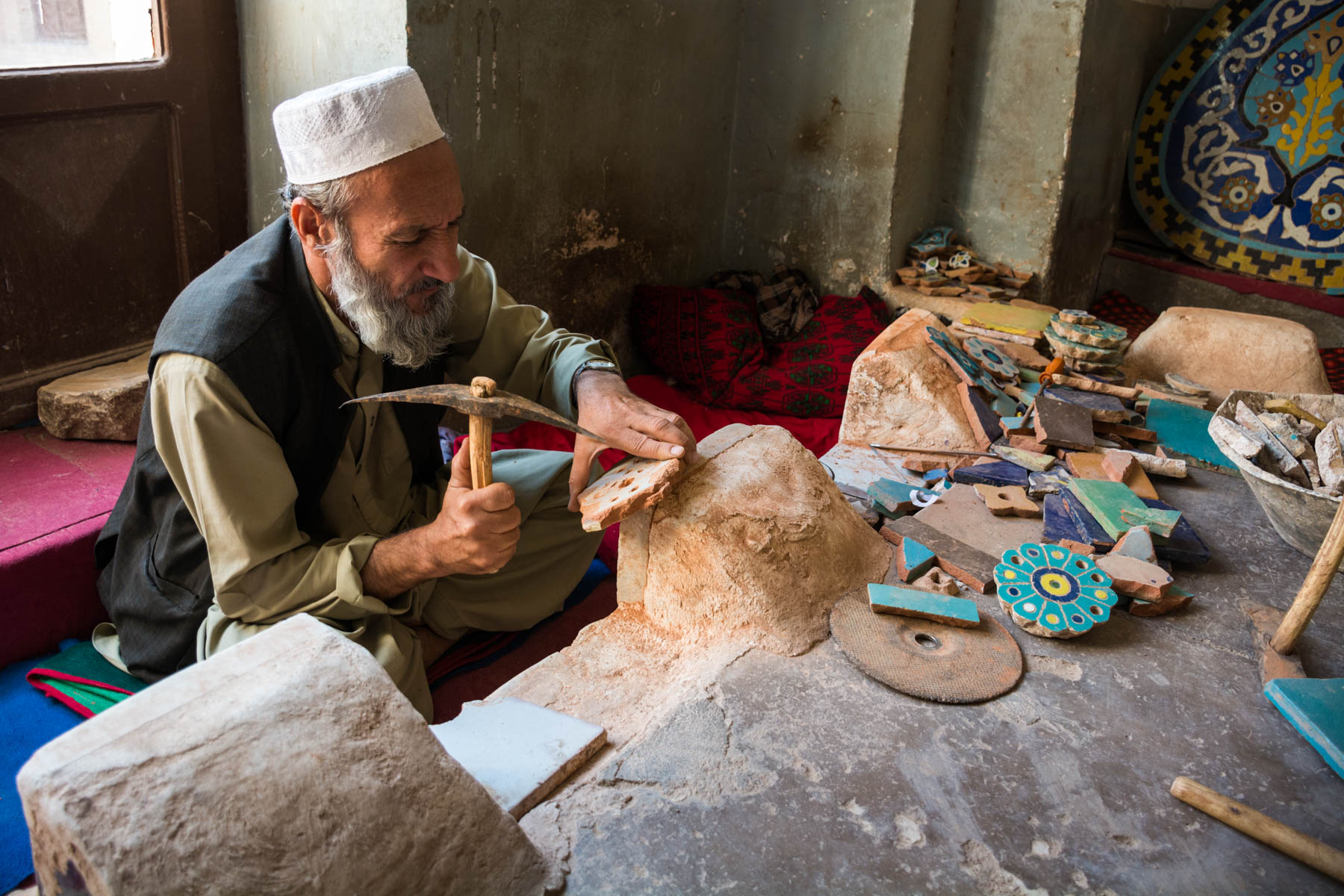
A tile maker chipping away at the Jame Mosque in Herat.
Further Afghanistan tourism resources
Tourist information.
- Official Bamyan tourism site
- Wikitravel Afghanistan
- Underground Girls of Kabul by Jenny Nordberg – A deep look into a curious and sad phenomenon in Afghanistan: girls dressing as boys to escape gender restrictions.
- An Unexpected Light: Travels in Afghanistan by Jason Elliot – An engrossing, well-written travelogue of observations by a man who visited Afghanistan in the 70s as a teenager, then 20 years later after learning Farsi.
- A Historical Guide to Afghanistan by Nancy Dupree – An oldie but a goodie, this is the authoritative guidebook for Afghanistan, with a thorough look at the country’s history.
- The Kite Runner by Khaled Hosseini – The most famous work of fiction set in Afghanistan. A modern-day classic, you won’t be putting this one down until you’ve read it cover-to-cover.
Guidebooks for Afghanistan are painfully outdated. Still, things change slowly in Afghanistan, and guidebooks are handy for getting a bit of background and history about the places you’re seeing. If you choose to invest, remember not to take any prices at face value.
- A Historical Guide to Afghanistan by Nancy Dupree (It is a guide, after all!)
- Afghanistan: The Ultimate Visual Travel Guide by Harry N. Abrams
- Lonely Planet Afghanistan
Here are some of our favorite travel blogs on Afghanistan. If you know of any more, send them on over!
- Don’t Stop Living – Mazar-i-Sharif and surroundings
- Backpackingman – Wakhan Corridor
And there you have it, everything you need to know to travel in Afghanistan. Let us know in the comments if you have any questions.

Yay transparency! The book links in this guide are affiliate links. That means if you buy one of those books, we’ll make a small amount of money at no extra cost to you. Think of it as a way of saying thanks and helping us to run the blog!
- Central Asia

Alex Reynolds
74 thoughts on “ the ultimate guide to travel in afghanistan ”.
I admire your pioneer spirit , having an awesome holiday where hardly most people would go. It does seem like a very esoteric and mysterious place, also doesn’t seem like a death trap like most advisories want us to believe. My sister works for Medics Without Fronteers and they wanted her to go there , but we all reccomended against it. But looking at your blog it reassuring. Myself I have been to some unstable places such as Somaliland (business trip), where I have heard so many bad things about it, but I totally enjoyed my 3 months stay. Thanks again for posting this.
Very awesome work done by you. The Content written here is very informative. Thanks a lot for sharing it
Thank you for the informative overview.
Leave a Reply Cancel reply
Your email address will not be published. Required fields are marked *

- Privacy Overview
- Strictly Necessary Cookies
This website uses cookies so that we can provide you with the best user experience possible. Cookie information is stored in your browser and performs functions such as recognising you when you return to our website and helping our team to understand which sections of the website you find most interesting and useful.
Strictly Necessary Cookie should be enabled at all times so that we can save your preferences for cookie settings.
If you disable this cookie, we will not be able to save your preferences. This means that every time you visit this website you will need to enable or disable cookies again.
Travel in Afghanistan: The Ultimate Backpacker’s Guide
March 23, 2020.
Everything you need to know about travelling in Afghanistan. Where to visit, how to get around, safety, and more are covered in this comprehensive travel guide.
Wondering what it’s like to travel in Afghanistan? You’ve come to the right place.
I’ve spent over 5 weeks independently solo travelling all over the country – from the bazaars of Herat to the remote Wakhan Corridor. I absolutely adore Afghanistan and it’s people and would love for more travellers to be able to experience it for themselves.
In this Afghanistan travel guide, you’ll find all of the practical info you need to know about travel in Afghanistan. Let’s get right into it!
- 1 Why travel to Afghanistan?
- 2.1 Is Afghanistan safe?
- 2.2 Travel Insurance for Afghanistan
- 2.3 Money in Afghanistan
- 2.4 Languages of Afghanistan
- 3.1 How to get a visa for Afghanistan
- 3.2 Flying into Afghanistan
- 3.3 Overland into Afghanistan
- 4.2 Mazar-e-Sharif
- 4.4 Bamiyan
- 4.5 Wakhan Corridor
- 5 When to visit Afghanistan
- 6 Internet in Afghanistan
- 7 Female Travel in Afghanistan
- 8 Solo Travel in Afghanistan
- 9 How much does travel in Afghanistan cost?
- 10 Couchsurfing in Afghanistan
- 11 Resources for travel to Afghanistan
- 12 Afghanistan Travel Guide Wrap-up
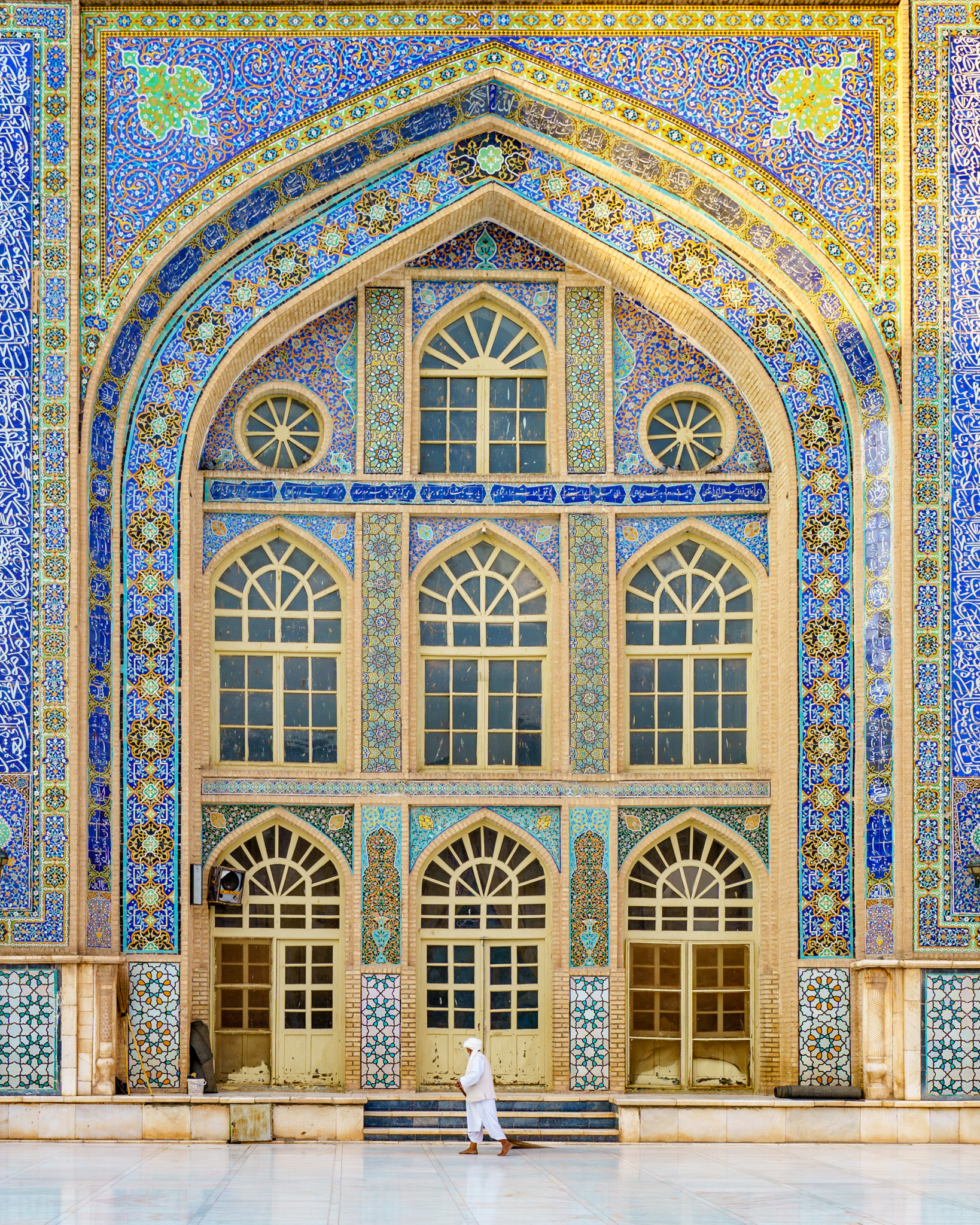
Why travel to Afghanistan?
This is a question that I’ve been asked a lot, and I understand why.
Western media only portrays Afghanistan as a poor and war-torn nation. While they’re not wrong, Afghanistan is so so so much more than that.
Afghanistan is a land where cultures, languages, and people collide – it’s where the Middle East, the Indian Subcontinent, and Central Asia blend together. When you visit Afghanistan, you’ll get to taste Persian food, hang out with Pashto speakers, and smoke hash with Uzbeks.
Afghanistan is also insanely beautiful . The Hindu Kush mountains run through the heart of the nation and offer scenery that you can’t find anywhere else. Further east in the Wakhan Corridor are some massive 7,000-meter peaks that tower above the villages at their feet.
I don’t recommend Afghanistan as a travel destination for everyone. It’s a challenging country to travel in, and it is not safe.
But if you’re up for it, then a visit to Afghanistan will be unforgettable. I promise.
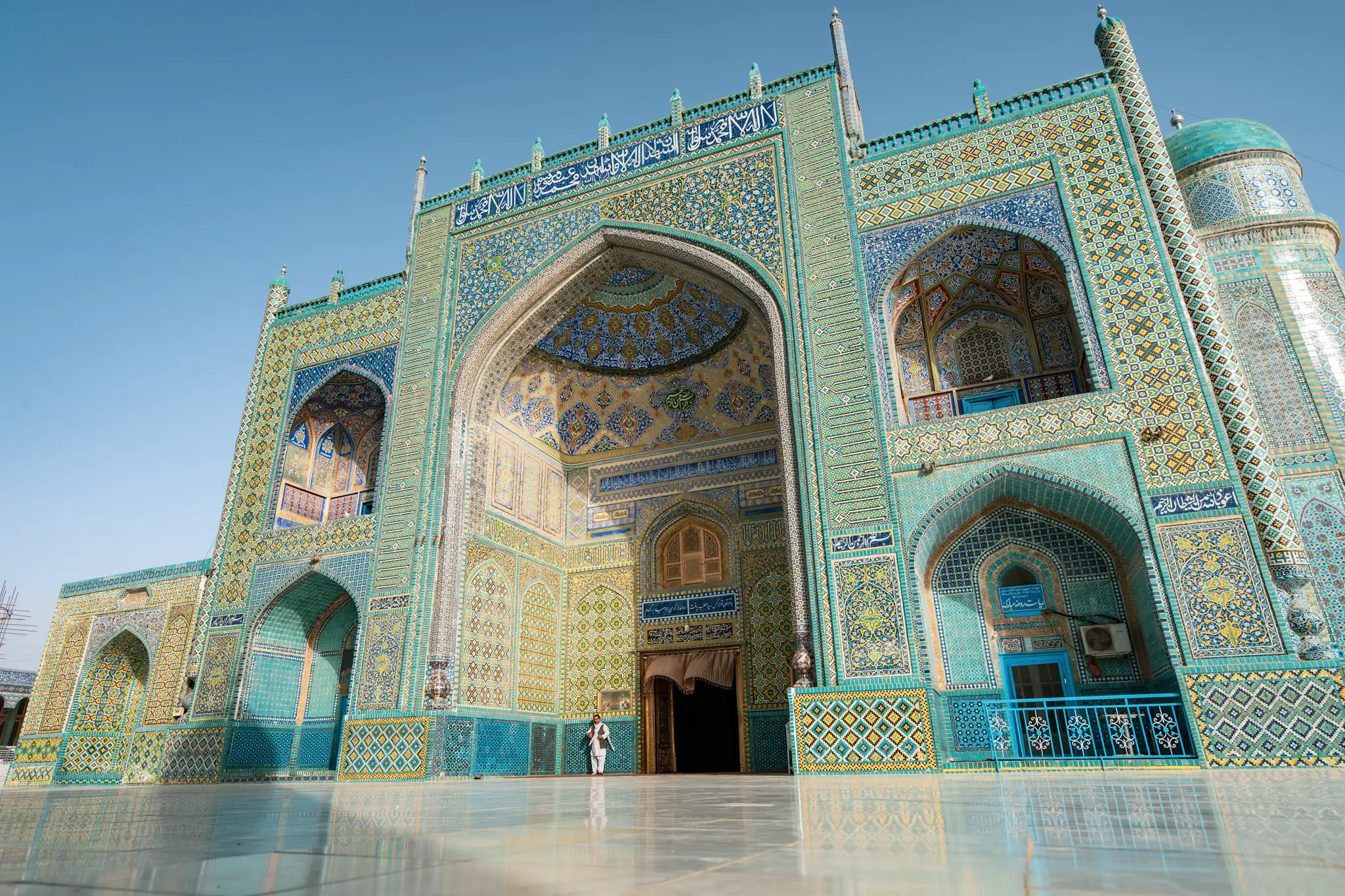
Before you visit Afghanistan
Here are a few things that you need to know about Afghanistan before your visit.
Is Afghanistan safe?
This is probably one of the first things on your mind when you think about heading to Afghanistan.
Afghanistan is not a safe country – and it would be foolish for me to say otherwise. Large areas of Afghanistan are under Taliban control, which means that travelling there is basically suicidal.
Here are the places that are currently relatively safe to visit in Afghanistan:
- Kabul (including Panjshir)
- Mazar-e-Sharif (including Balkh and Samagan)
Wakhan Corridor
While it’s possible to visit these places somewhat safely, certain precautions still need to be taken. They’re certainly not as safe as destinations such as Europe or SEA, but they’re also not on the same level as Yemen.
When visiting the above destinations, your main risks are kidnapping, robbery, and random attacks (wrong place at the wrong time).
You’ll need to decide for yourself if your risk tolerance is high enough to visit Afghanistan. Travel to Afghanistan is not something I can recommend (at this time), although if you’re an experienced traveller, then it is possible.
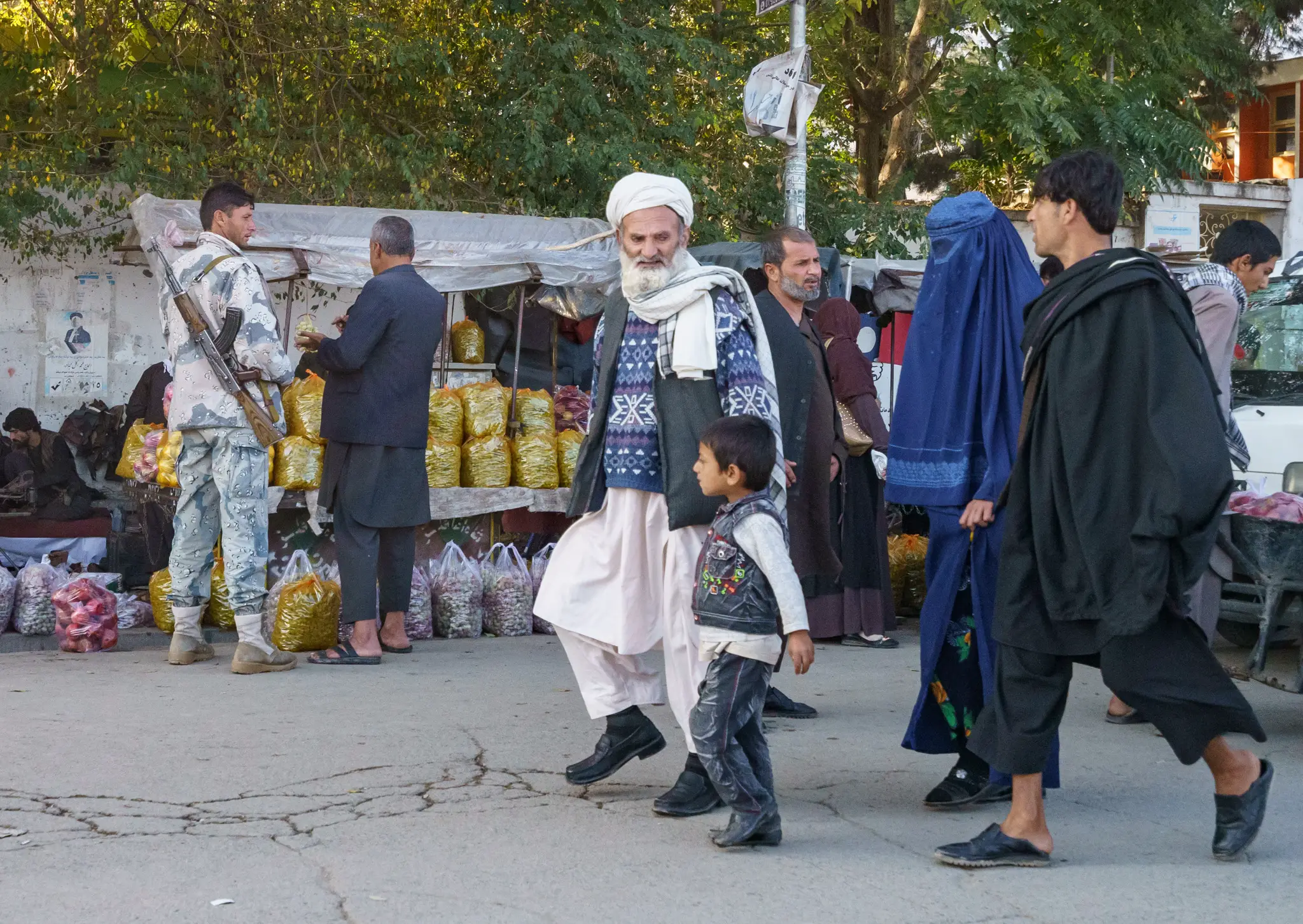
Travel Insurance for Afghanistan
Travel insurance is extremely important if you’re going to visit Afghanistan. Unfortunately, finding travel insurance that will cover Afghanistan is difficult. While I normally use World Nomads when travelling, they don’t cover Afghanistan (understandably).
I’ve been searching for an insurance provider to recommend to my readers, but I haven’t found the ideal one yet. Check out this thread for some discussion on travel insurance in Afghanistan.
Money in Afghanistan
Afghanistan’s official currency is the Afghani (AFN).
The current exchange rate is $1 = 76 Afghani as of March 2020. Check out XE.com for the latest rates.
US dollars are widely accepted in Afghanistan, and you’ll be able to find money changers all over the place. Money changers usually offer very fair rates to change USD to AFN, although be sure to bring crisp US bills.
Credit cards are basically useless in Afghanistan, outside of high-end hotels in Kabul. There are some ATMs in Kabul and other cities that accept foreign debit cards, but I wouldn’t count on the reliability of these things. Instead, try to bring enough USD to last your entire trip.
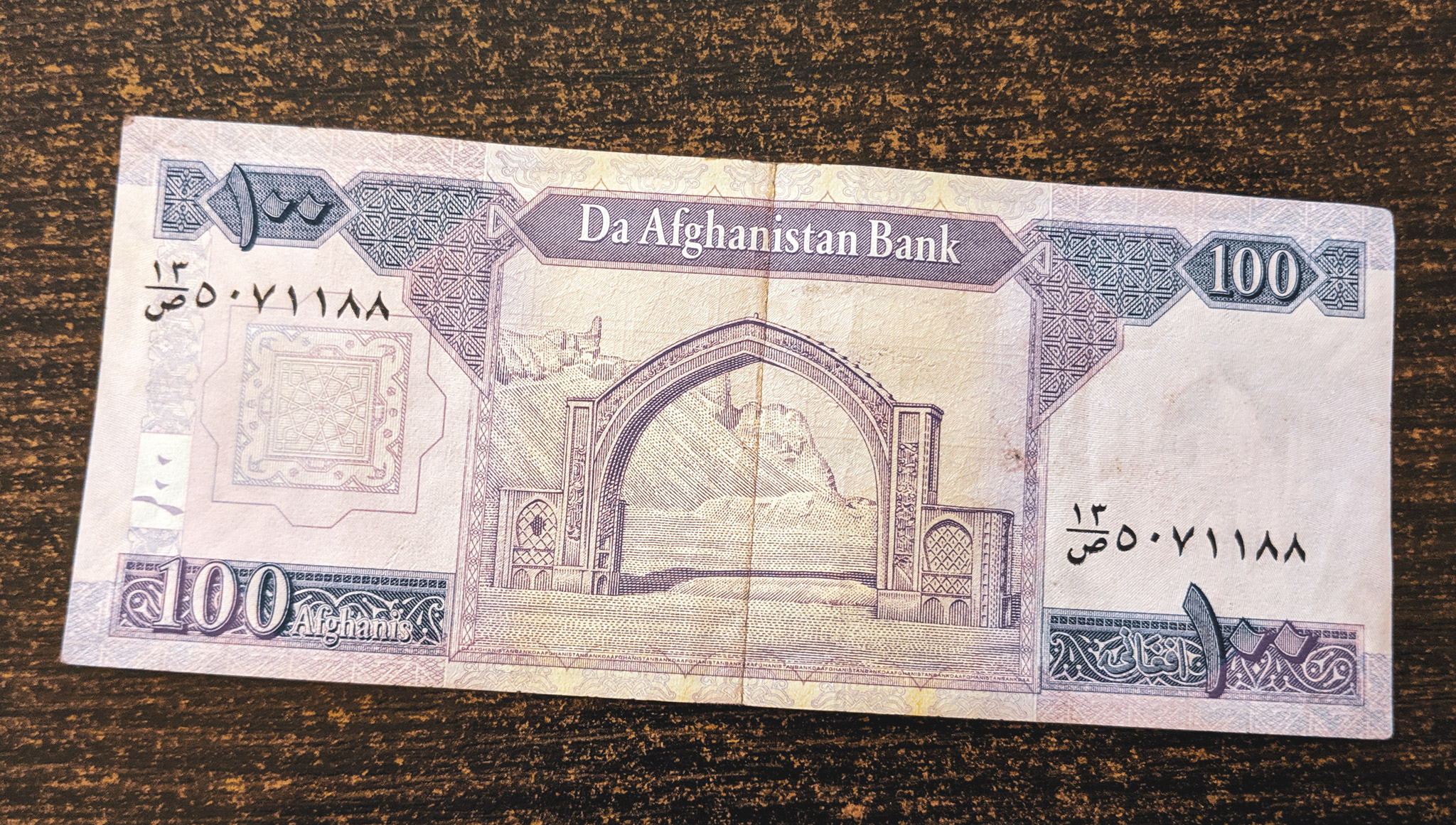
Languages of Afghanistan
Afghanistan is a multilingual country, with it’s two official languages being Dari (Afghan Farsi) and Pashto.
In certain parts of the country, you’ll also find Uzbek, Turkmen, Balochi, Pashai, Nuristani, Wakhi, and Kyrgyz being spoken.
English is hard to come by in Afghanistan, especially outside of Kabul. Learning basic Dari and carrying a phrasebook will be very helpful if you plan on travelling in Afghanistan.
People working in the tourism industry often have a basic grasp of English, especially guesthouse owners.
Travelling with a local is another good idea, as they’ll be able to help translate for you. There are quite a few locals on Couchsurfing who would be happy to take you around.
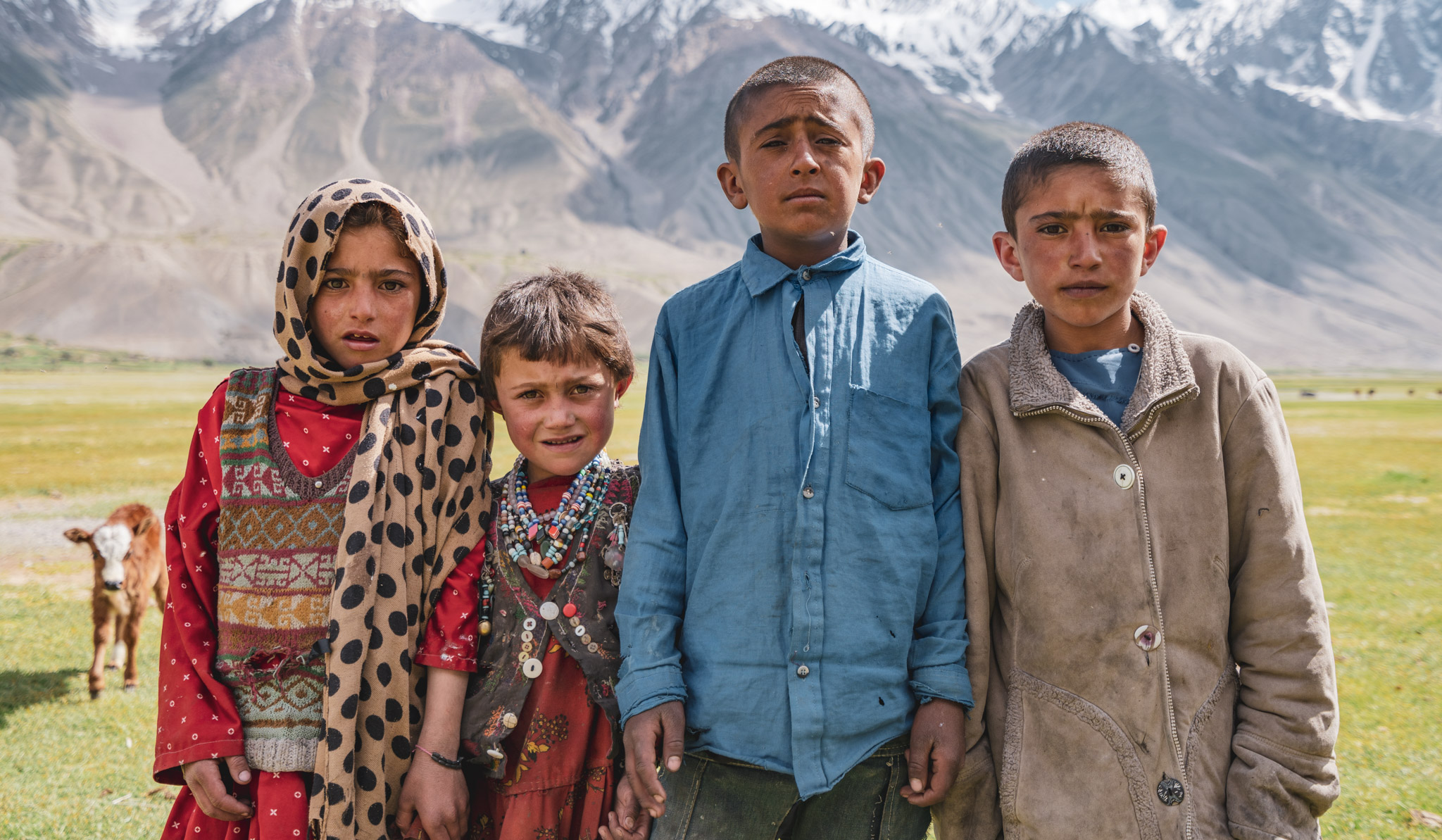
Getting to Afghanistan
Getting to Afghanistan can be a challenge. Tourist visas are hard to come by, and many land borders aren’t safe for foreigners.
Let’s go over what you need to know to get into Afghanistan:
How to get a visa for Afghanistan
All nationalities need a visa to visit Afghanistan, and getting a tourist visa is a challenge. Most Afghan embassies don’t want to issue tourist visas due to the security risks for travellers in Afghanistan.
If you are planning on visiting Afghanistan with a licensed tour operator, they’ll be able to provide you with an invitation letter. With an invitation letter, the Afghan embassy in your home country shouldn’t have any problem issuing your visa.
Things get complicated if you want to visit independently. Tour operators won’t issue an invitation letter if you aren’t travelling with them (understandable).
There are a couple of Afghan embassies that will issue tourist visas without an invitation letter. Currently, they are Khorog , Islamabad , Bishkek , Almaty . Requirements are constantly changing, and this list is only based on the latest information I have available.
I’ve had success in getting Afghan tourist visas in both Islamabad and Bishkek without a letter of invitation.
Afghan tourist visas are always valid for 30-days and are single-entry. They are valid for a 3-month period that is stated on the visa.
For more information, see my guide to getting an Afghanistan tourist visa. ( Coming Soon )
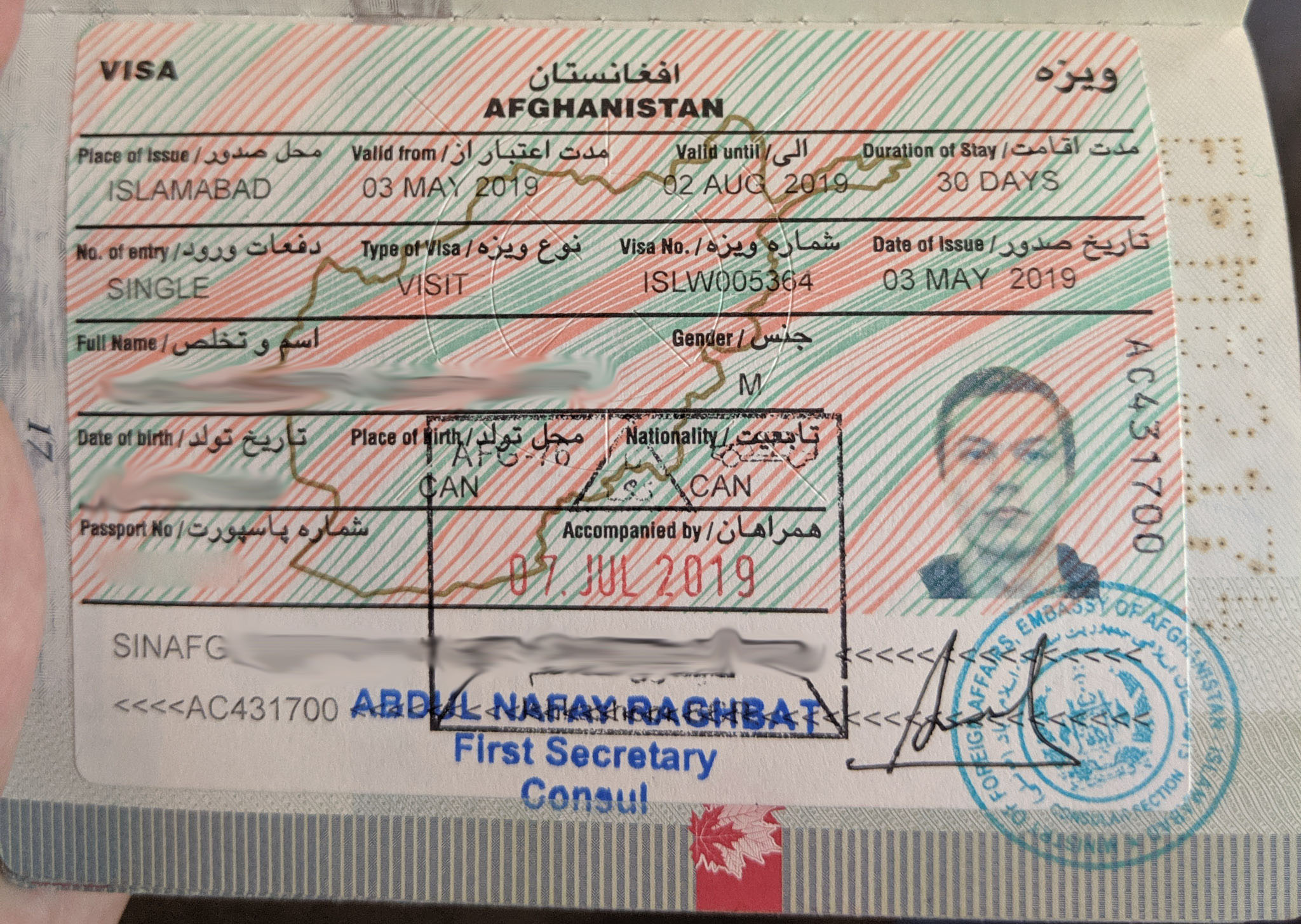
Flying into Afghanistan
Flying into Afghanistan is a good idea if you want to avoid an overland border crossing.
Afghanistan is reasonably well connected to nearby countries by air.
Kabul is the largest international airport, with daily flights from Istanbul, Dubai, Islamabad, and Delhi. There are also frequent flights from Tashkent, Dushanbe, Tehran, Jeddah, and Ankara.
Mazar-e-Sharif has flights to Istanbul, Delhi, and Moscow (once per week).
Herat has flights to Delhi, and Kandahar has flights to Delhi, Dubai, and Jeddah.
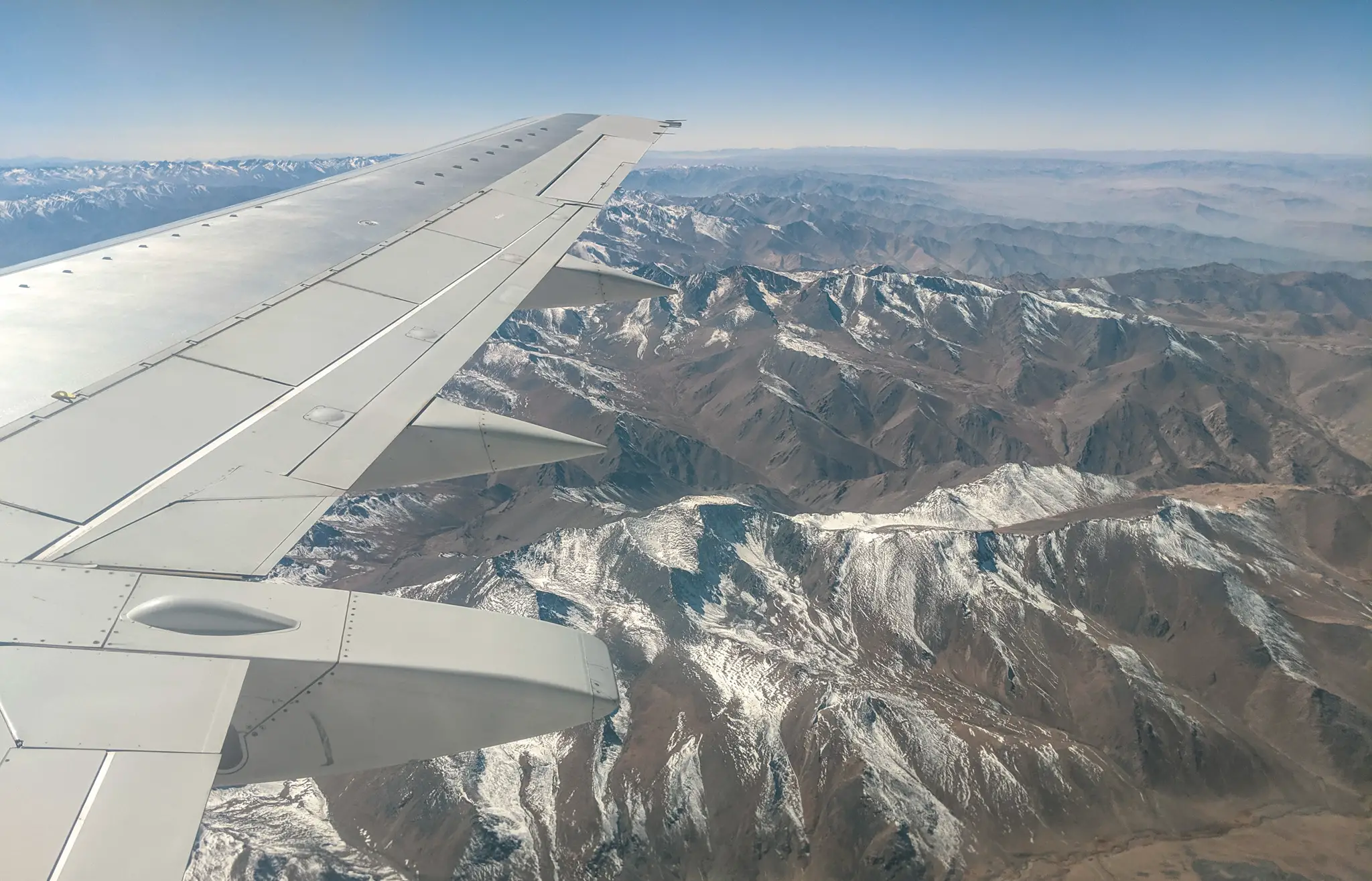
Overland into Afghanistan
There are a few different ways to travel overland into Afghanistan.
Uzbekistan to Afghanistan
The Hairatan border crossing between Termez and Mazar-e-Sharif is one of the safest Afghan border crossings.
Provided your visas are in order, this is a great way to enter Afghanistan overland.
Check out my guide to the Hairatan border crossing for more info.
Tajikistan to Afghanistan
Crossing from Tajikistan to the Afghan Wakhan Corridor at Ishkashim is safe and straightforward.
See my Wakhan Corridor guide for more info on this border crossing.
There is also a border crossing between Southern Tajikistan and Kunduz, but this border is not safe right now.
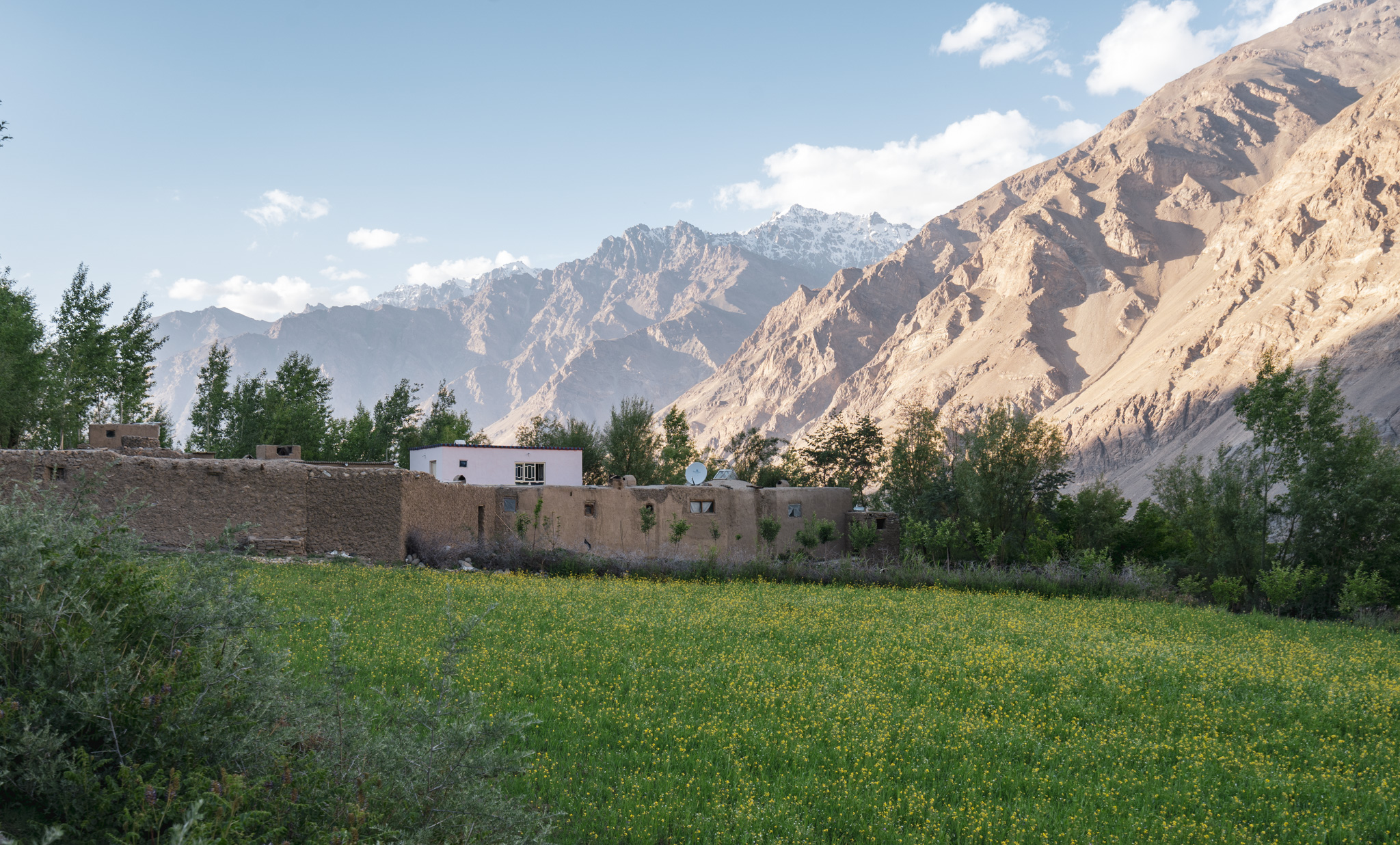
Pakistan to Afghanistan
The Khyber Pass connecting Peshawar and Jalalabad is one of the most famous border crossings in the world.
Foreigners have successfully crossed this border, but it’s not recommended.
Here’s a report from someone who attempted to cross the Khyber Pass in 2018.
Iran to Afghanistan
It is possible to travel between Mashhad and Herat safely. After entering Afghanistan, a shared taxi should cost about 250 Afghani from the border to Herat.
Turkmenistan to Afghanistan
The border between Merv and Herat is reportedly open, although not so easy to cross. You’ll need to arrange a tour to Turkmenistan if you wish to enter this way, as it’s not possible to get a transit visa for Turkmenistan in/to Afghanistan (I tried).
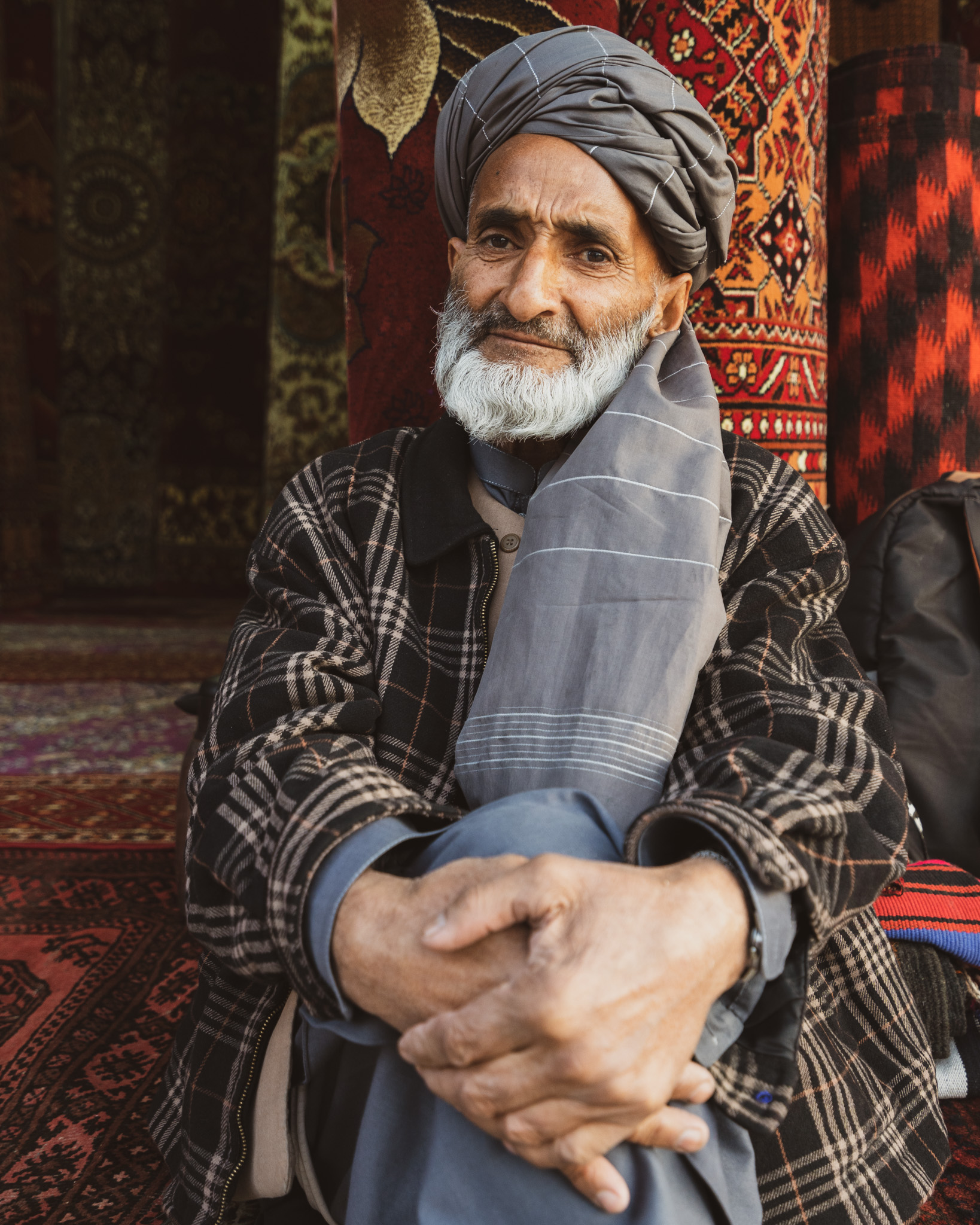
Places to visit in Afghanistan
At the moment, it’s only possible to visit certain parts of Afghanistan. Here’s everything you need to know about travelling to the safe parts of Afghanistan.
Kabul is the heart of Afghanistan. As the nation’s capital, it’s been through a lot – over time it has hosted the British, Soviets, and most recently, the Americans.
Kabul sits at about 1,800 meters above sea level and is surrounded by the high Hindu Kush mountains on all sides.
The city is currently home to over 5 million people and is one of the world’s fastest-growing cities . Kabul is home to people from all over Afghanistan looking to work in the big city.
Things to do in Kabul
There’s of things to do in Kabul, here are some of the ones I recommend:
- Gardens of Babur – Laid out by the Mugal ruler Babur sometime in the 16th century, these beautiful gardens are the perfect way to escape the crowded streets of Kabul for some relaxation time. The entrance fee is 250 Afghani for foreigners.
- Kart-e-Sakhi – A beautiful Shia shrine and mosque that is full of locals in the afternoons (especially on Fridays).
- Shah-e-Doh Mosque – Another beautiful mosque in Kabul. Unfortunately, it was closed for renovations when I was in the city.
- Darul Aman Palace – King Amanullah’s Palace. It was destroyed by the Taliban but has recently been restored to its former glory.
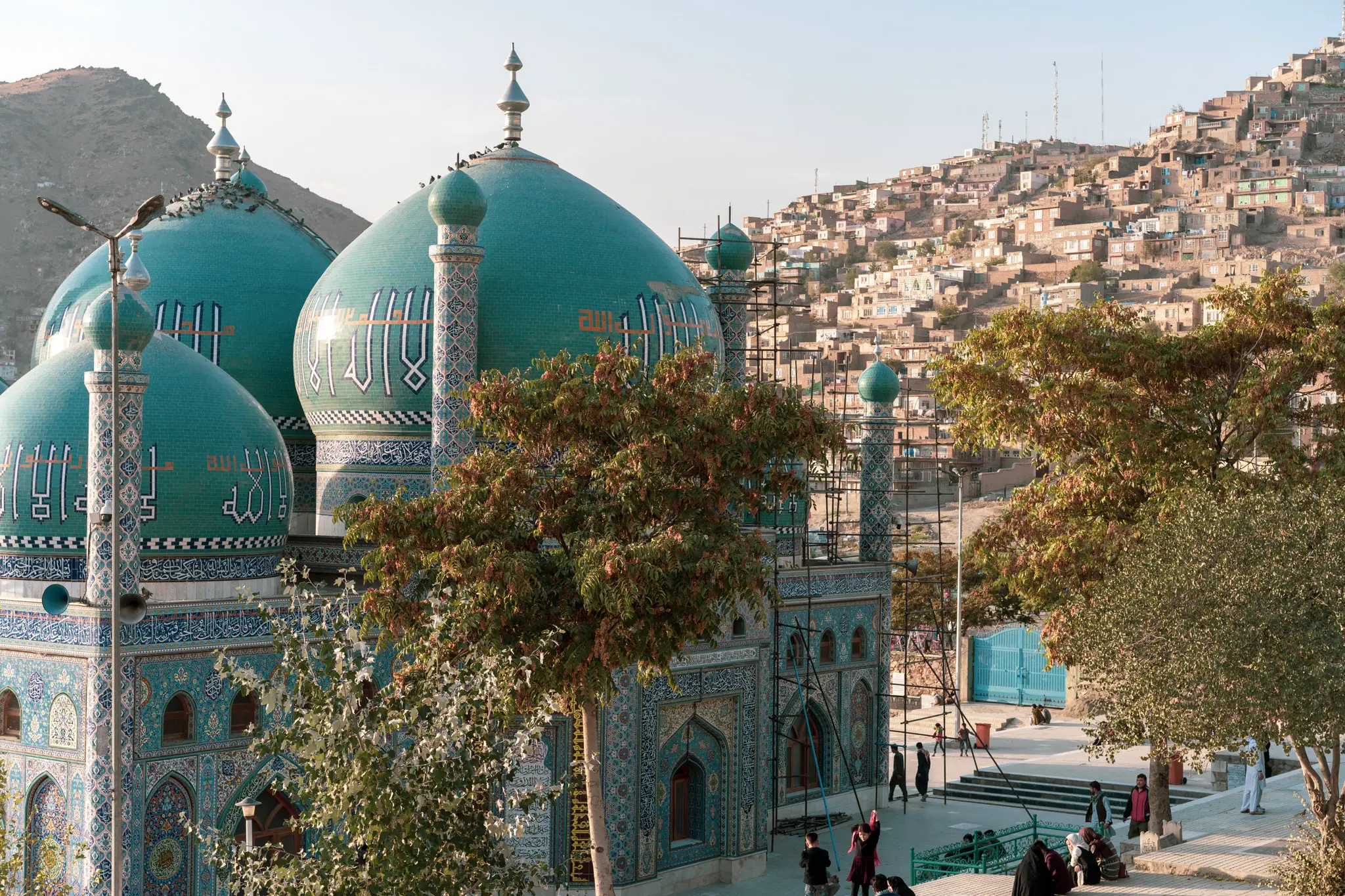
Where to stay in Kabul
- Salsal Guesthouse – A decent budget option in the center of town. No single rooms, but a double with a shared bathroom should cost 1000 Afghani. Not particularly clean.
Getting to Kabul
There are daily flights to Kabul from Mazar-e-Sharif, Herat, and Kandahar. These will typically cost about $100 one-way and can be booked on fairly short notice.
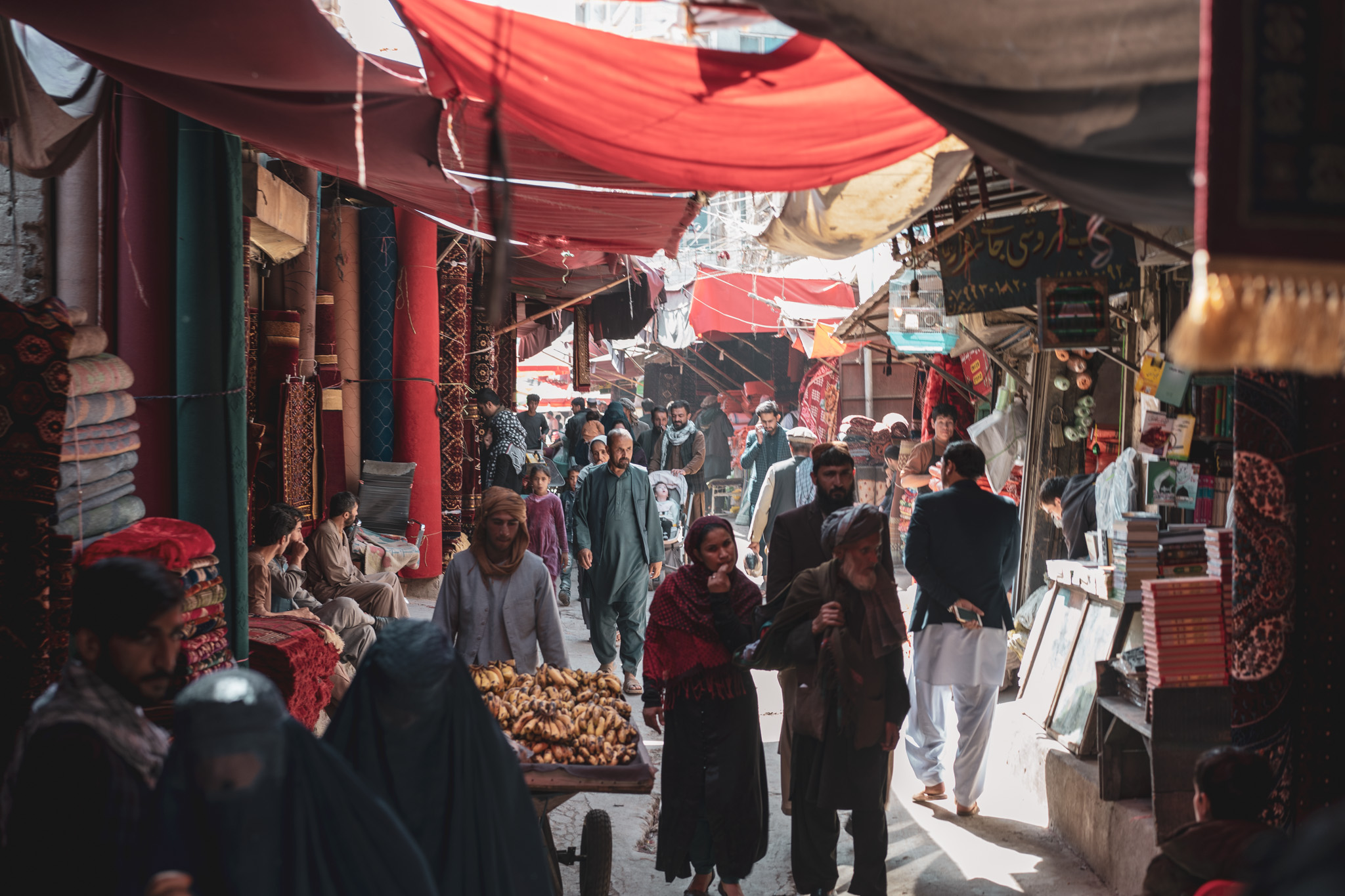
Mazar-e-Sharif
Located in Northern Afghanistan near the border with Uzbekistan, Mazar-e-Sharif is Afghanistan’s fourth-largest city and a must-visit place if you’re planning on travelling to mainland Afghanistan.
Mazar-e-Sharif is most famous for its incredible Shrine of Hazrat Ali (or Blue Mosque). I ended up visiting the mosque on three different occasions, and I’d say it’s one of the most beautiful buildings I’ve ever seen.
Things to do in Mazar-e-Sharif
Here’s what I recommend doing if you make it to Mazar-e-Sharif:
- Shrine of Hazrat Ali – One of the most stunning buildings in the world. Visit in the late afternoon for the best lighting. Entry is free.
- Day trip to Old Balkh – Balkh was the former capital of the Bactrian Kingdom and has existed since as early as 500BC. Alexander the Great, Genghis Khan, Timur, and Marco Polo all passed through this city that nowadays isn’t much more than a large ring of dirt. It’s fairly simple to visit Old Balkh as a day trip from Mazar-e-Sharif. However, the security situation in Balkh is unstable, so get in touch with some locals to find out the latest news before you go.
- Day trip to Samangan – Another awesome day trip, Samangan was once a Buddhist kingdom and is filled with ancient Stupas and other Buddhist relics.
- Roam the bazaars – The bazaars surrounding the Shrine of Hazrat Ali are full of life, and a great place to pick up some local Afghan clothes to help you blend in.
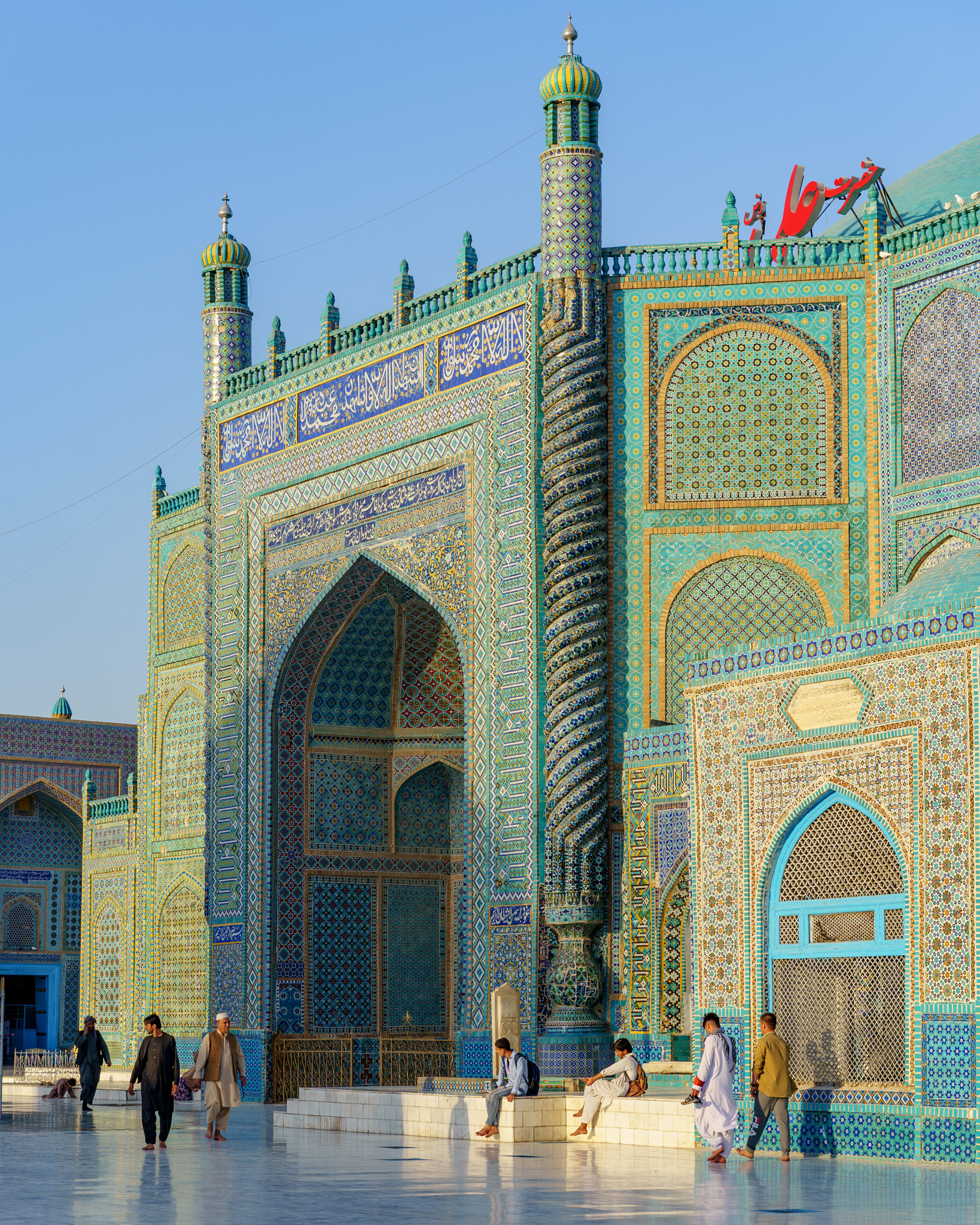
Where to stay in Mazar-e-Sharif
I had a bit of trouble finding a budget place to stay in Mazar-e-Sharif. Barg-e-Sabs was mentioned online as the best budget option, but when I managed to find it there were a bunch of random people hanging out in the “lobby” and it didn’t seem as though it was operating as an official hotel anymore (no staff were there).
I checked out a few other places, so here’s what I found:
- Karwan Balk Guesthouse – This is where I ended up staying. $25 a night for a nice single room on the 7th floor with a great view of the city and including breakfast. The staff were very friendly although didn’t speak any English.
- Barat Hotel – Right next to the Blue Mosque, they wanted $40 a night for a single room and wouldn’t budge any lower. A good option if you want to stay in the center of town.
There are some great people on Couchsurfing in Mazar-e-Sharif, so be sure to see if you can find anyone to host you.
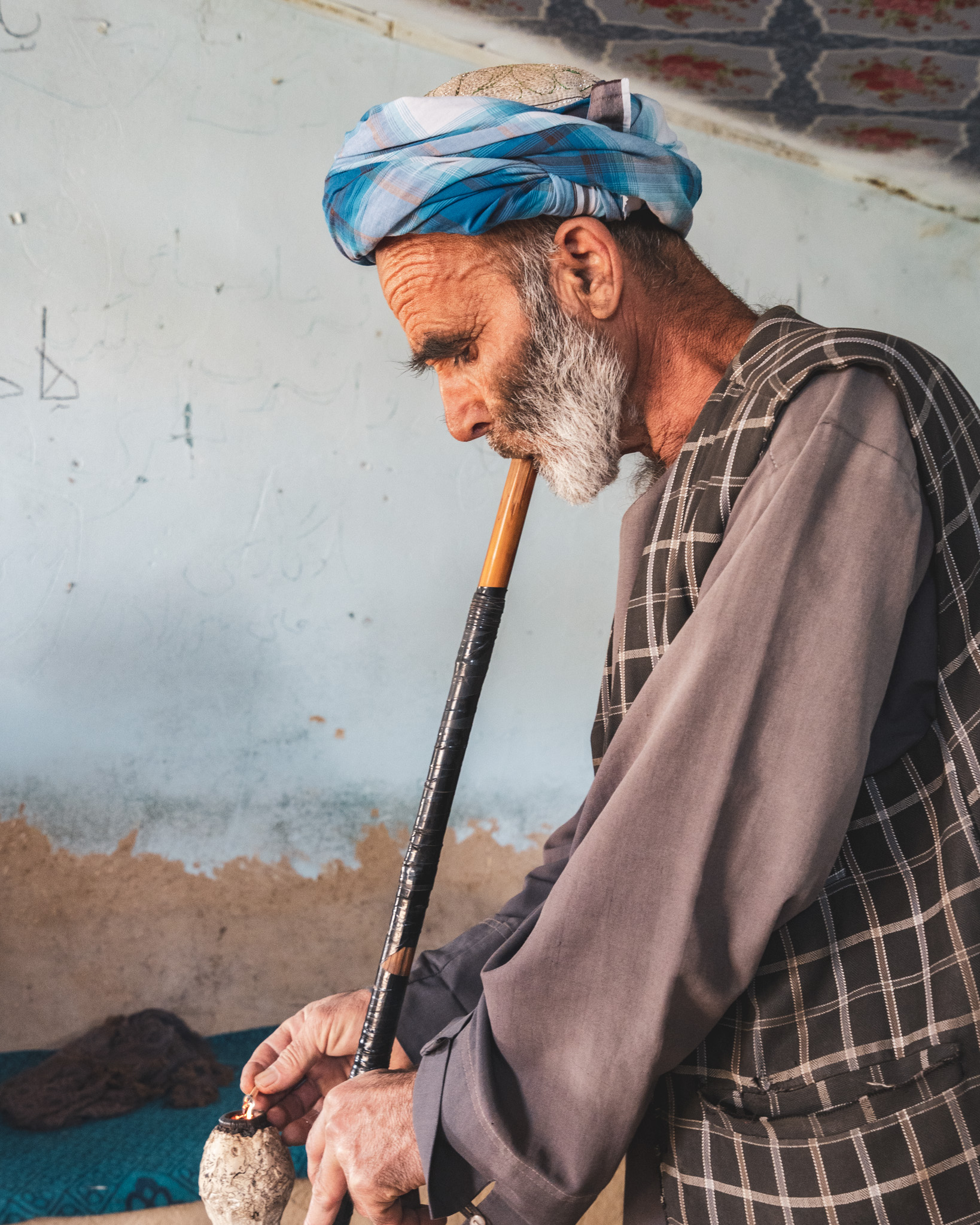
Getting to Mazar-e-Sharif
The easiest way to get to Mazar-e-Sharif is to use the Hairatan border crossing from Uzbekistan .
There are also daily flights between Kabul and Mazar-e-Sharif.
Overland travel between Kabul and Mazar-e-Sharif via the Salang Pass is not advised . The security situation along this road changes rapidly, and even if it was safe 24 hours ago it could be under Taliban control now.
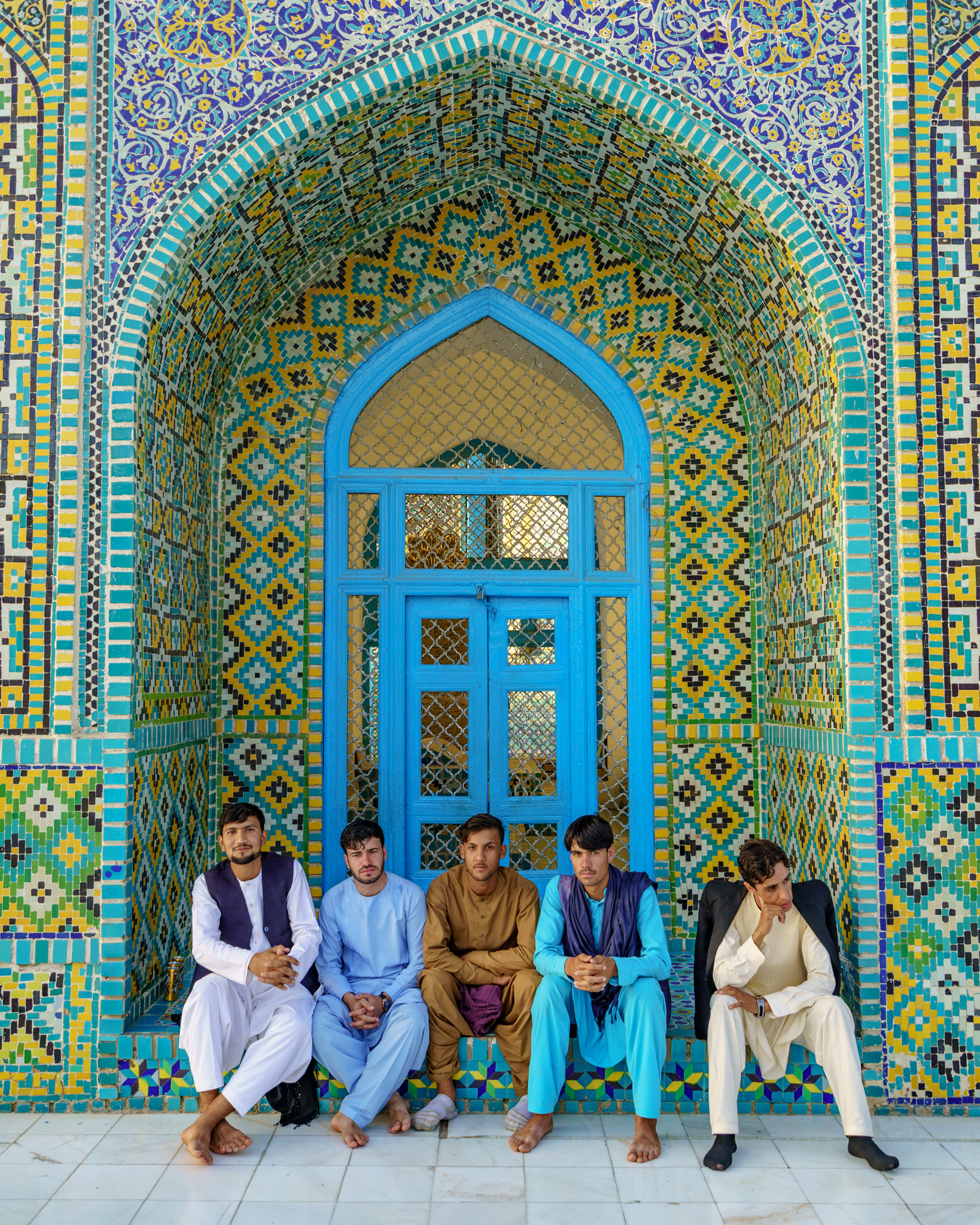
Herat another major city in Afghanistan located near the Iranian border. It’s a historically Persian city and has a very unique Persian-Afghan culture blend.
Wandering around Herat’s Old City feels like travelling back in time, and it’s Friday Mosque will leave even the most well-travelled in awe.
Things to do in Herat
- The Great Mosque of Herat – Another one of Afghanistan’s stunning mosques. This building is absolutely beautiful, and you could spend hours roaming around and watching worshippers pray.
- Musalla Complex – Once upon a time, this was the largest mosque in Herat. unfortunately, it was destroyed by the British in 1885 and today only five massive minarets remain.
- Herat Citadel – A massive fortress that was recently restored. It’s a great place to spend an afternoon wandering around.
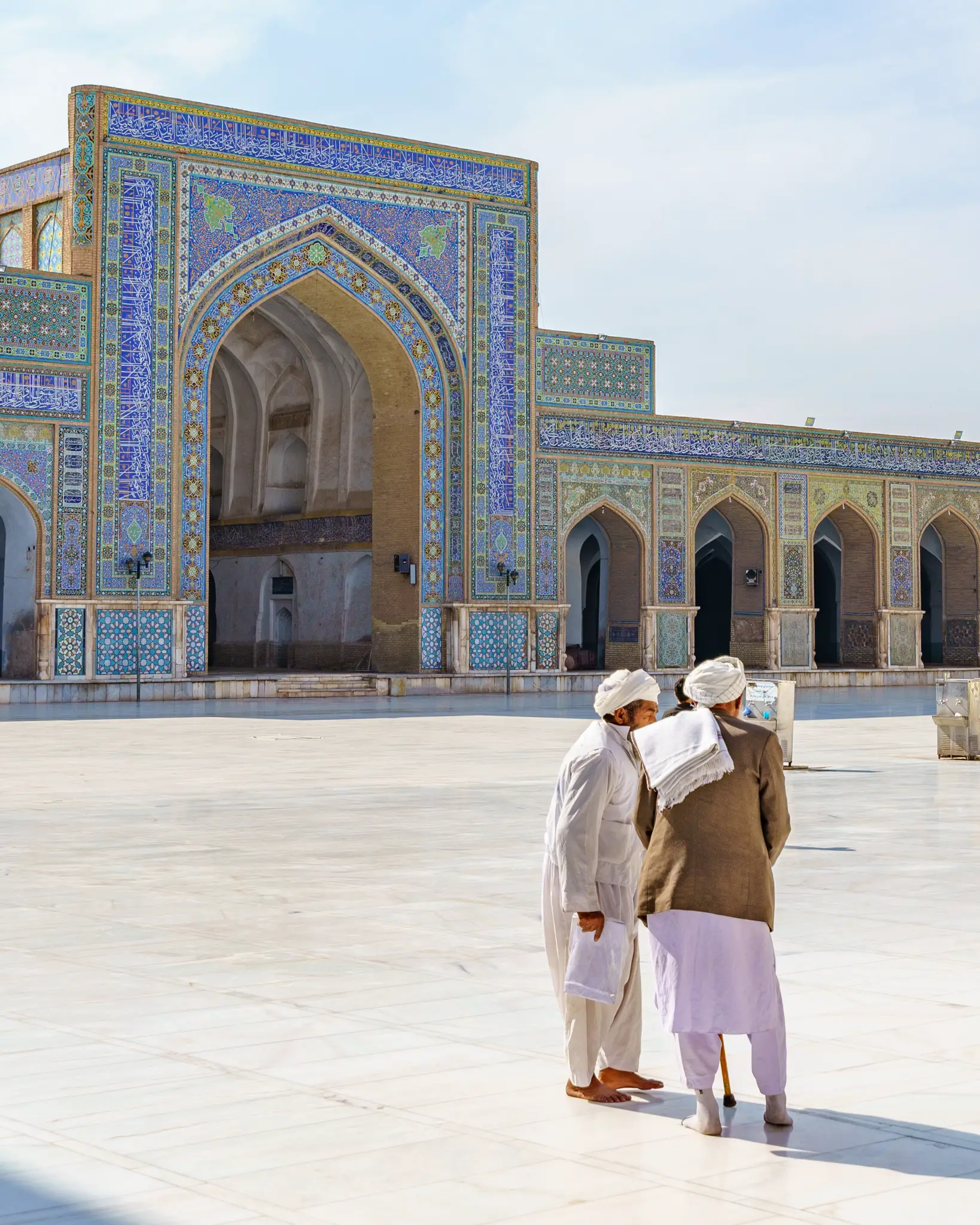
Where to stay in Herat
You’ve got a few different options for places to stay in Herat.
- Hotel Darya – This is where I ended up staying. $20 a night for a basic single room with a private bathroom. It is located right near the Grand Mosque and the staff were friendly.
- Marco Polo Hotel – A slightly more expensive option, rooms here will run you $40 to $50 a night for a single.
Getting to Herat
The only way to safely get to Herat from other parts of Afghanistan is by air. There are daily flights from Kabul on Kam Air for around $90.
The only alternative way to get to Herat is from Mashad, Iran – although you will still need to fly to get to anywhere else in Afghanistan.
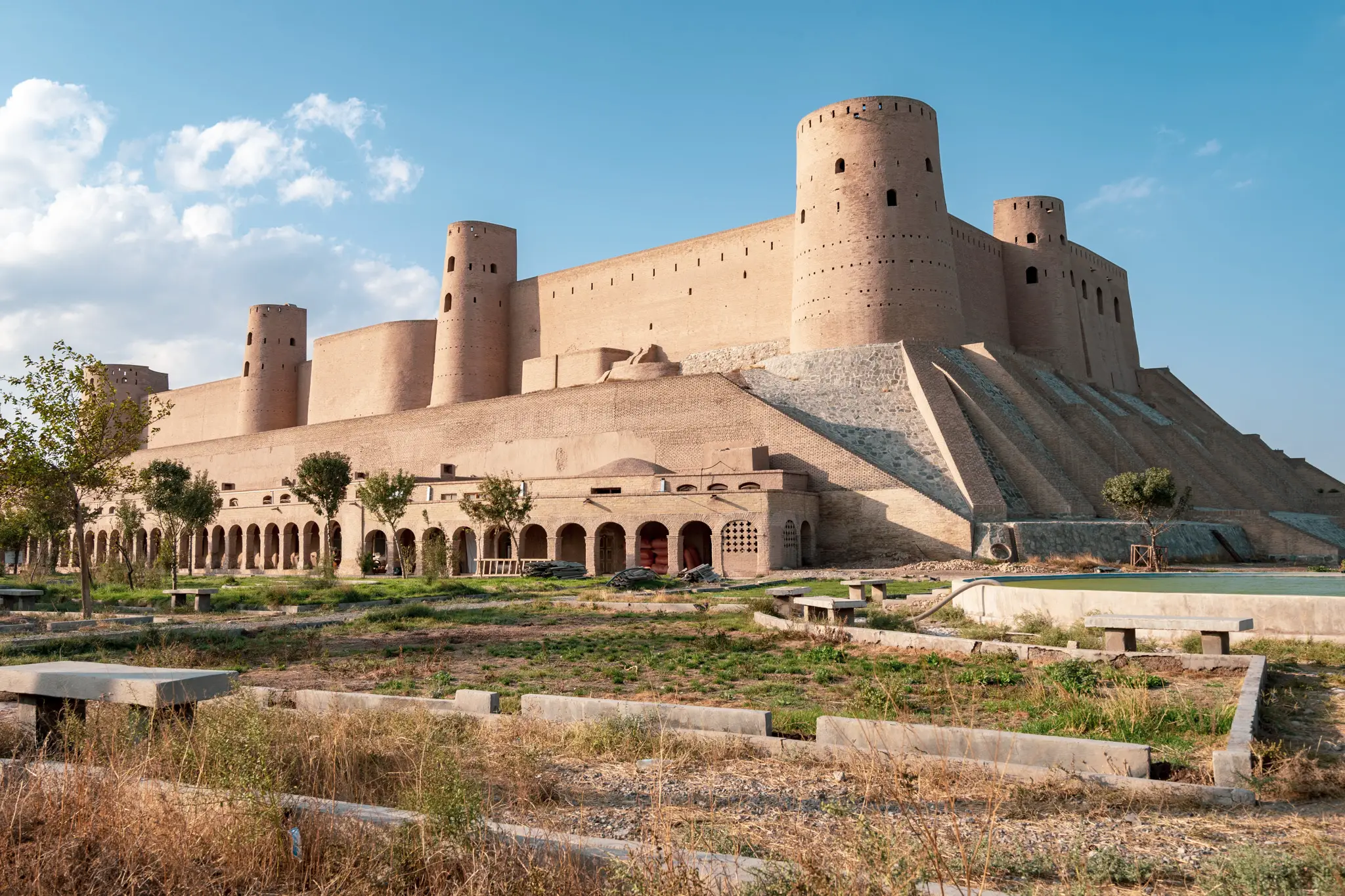
Bamiyan is one of my favourite places I’ve ever been – it’s a peaceful oasis located high in Afghanistan’s Hindu Kush mountains.
I could have spent weeks exploring this place, there’s just so many picturesque villages and valleys filled with warm, hospitable people. I hope to be back soon to see more.
When you are in Bamiyan, you’ll need to purchase a 300 Afghani entrance ticket which will allow you to enter most sights (other than Band-e-Amir which is a separate ticket). The main ticket can be purchased near the base of the largest Buddha.
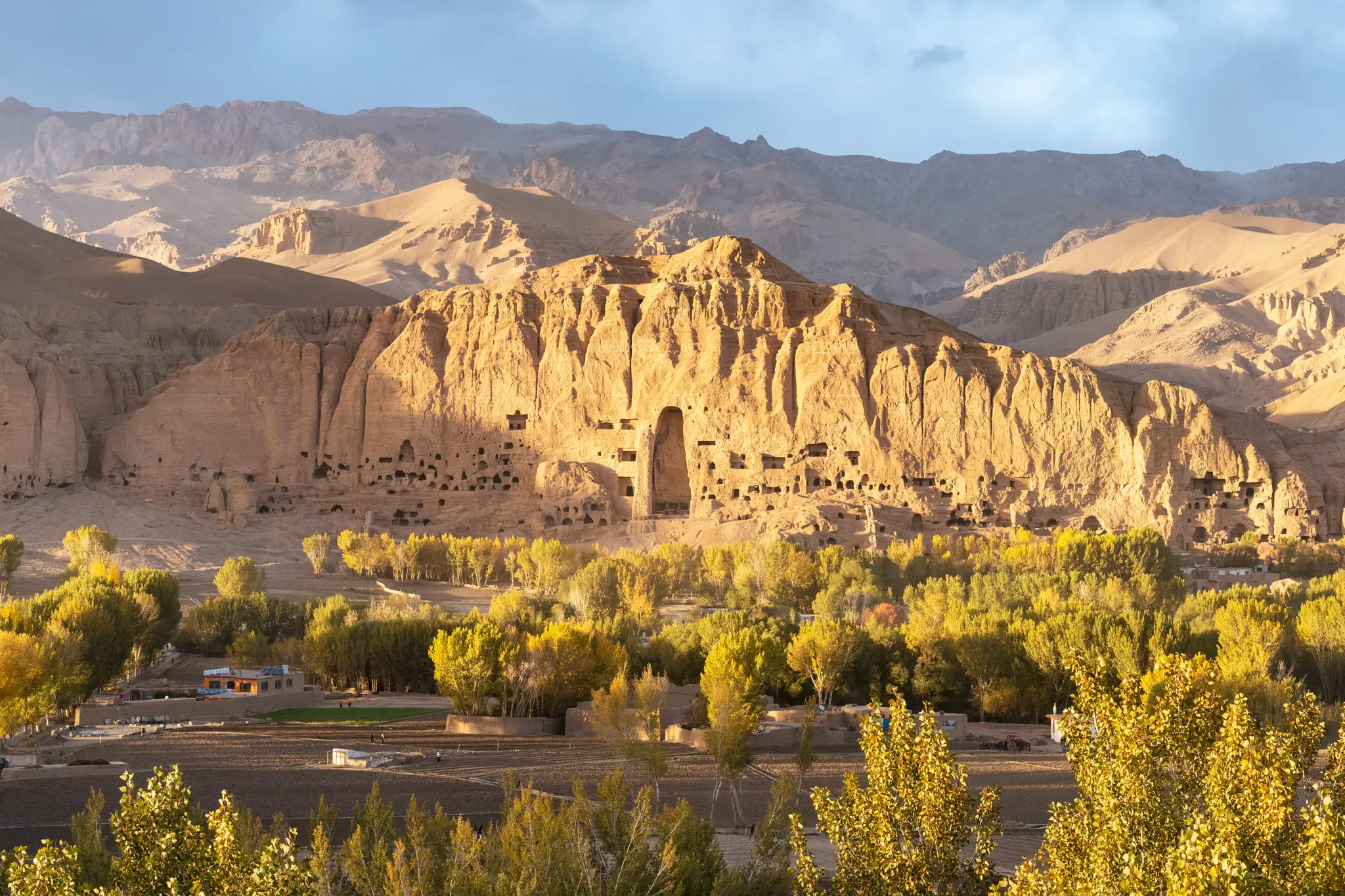
Things to do in Bamiyan
- Band-e-Amir National Park – Band-e-Amir is Afghanistan’s crown jewel. It’s located at 3,000 meters above sea level about 1.5 hours outside of Bamiyan Town. Band-e-Amir is home to six gorgeous blue lakes and is perfect for photography. The entrance fee is 250 Afghani.
- Buddhas of Bamiyan – Probably the most famous sight in all of Afghanistan. The Buddhas of Bamiyan were tragically destroyed by the Taliban in 2001, but the remains are still a stunning sight to see. It’s hard to miss these when you visit Bamiyan, they can be seen from all over town.
- Shahr-e Gholghola – An imposing fortress was the location of the Ghorid Bamiyan’s final battle against the Mongol hordes of Genghis Khan. Located in the center of Bamiyan town, you’ll be able to see it rising above as soon as you arrive.
- Shahr-e Zohak – This is another fortress, but it is located near the entrance to the Bamiyan Valley. It’s perched on cliffs high above the valley and is a great half-day trip from town.
- Dara-e Ajdahar – Also known as the Dragon Valley. Once upon a time, legend has it that Ali, the son of Prophet Mohammad, slew a dragon here. You can take a taxi here (or walk) from Bamiyan town and spend a couple of hours walking around taking in the views.
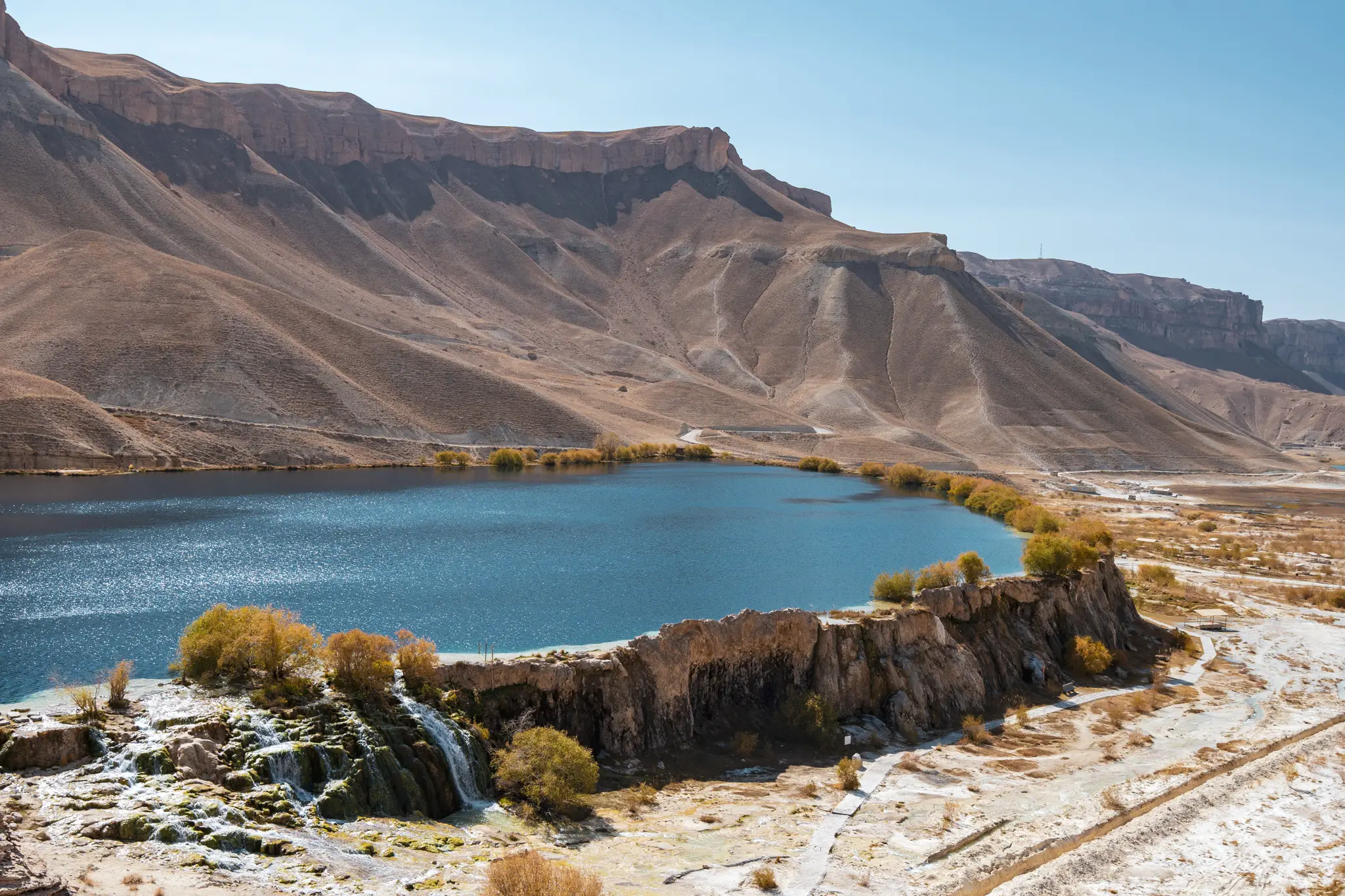
Where to stay in Bamiyan
Bamiyan has quite a few decent places to stay:
- Cheelhil Burg Hotel – This is where I stayed and I liked it! It’s located a bit far from the town center (closer to Ajdahar village), but is a nice place and is run by a friendly family. It costs 2000 Afghani per night for a double room ($26).
- Chaikhanas – These are your cheapest option. They’re scattered throughout the main bazaar and are basically just a room with cushions on the floor. They cost between 400 and 500 Afghani per night (~$6).
- Highland Hotel – A higher-end option, the Highland has a great view of the Bamiyan Valley and is run by a great guy. Prices are around $50 – 90 depending on the season and your negotiation skills.
Getting to Bamiyan
Getting to Bamiyan is a challenge because the road there passes through dangerous Taliban territory. Flying is a better option, although flights are sporadic.
To learn more about travelling in Bamiyan, check out my detailed Bamiyan Travel Guide .
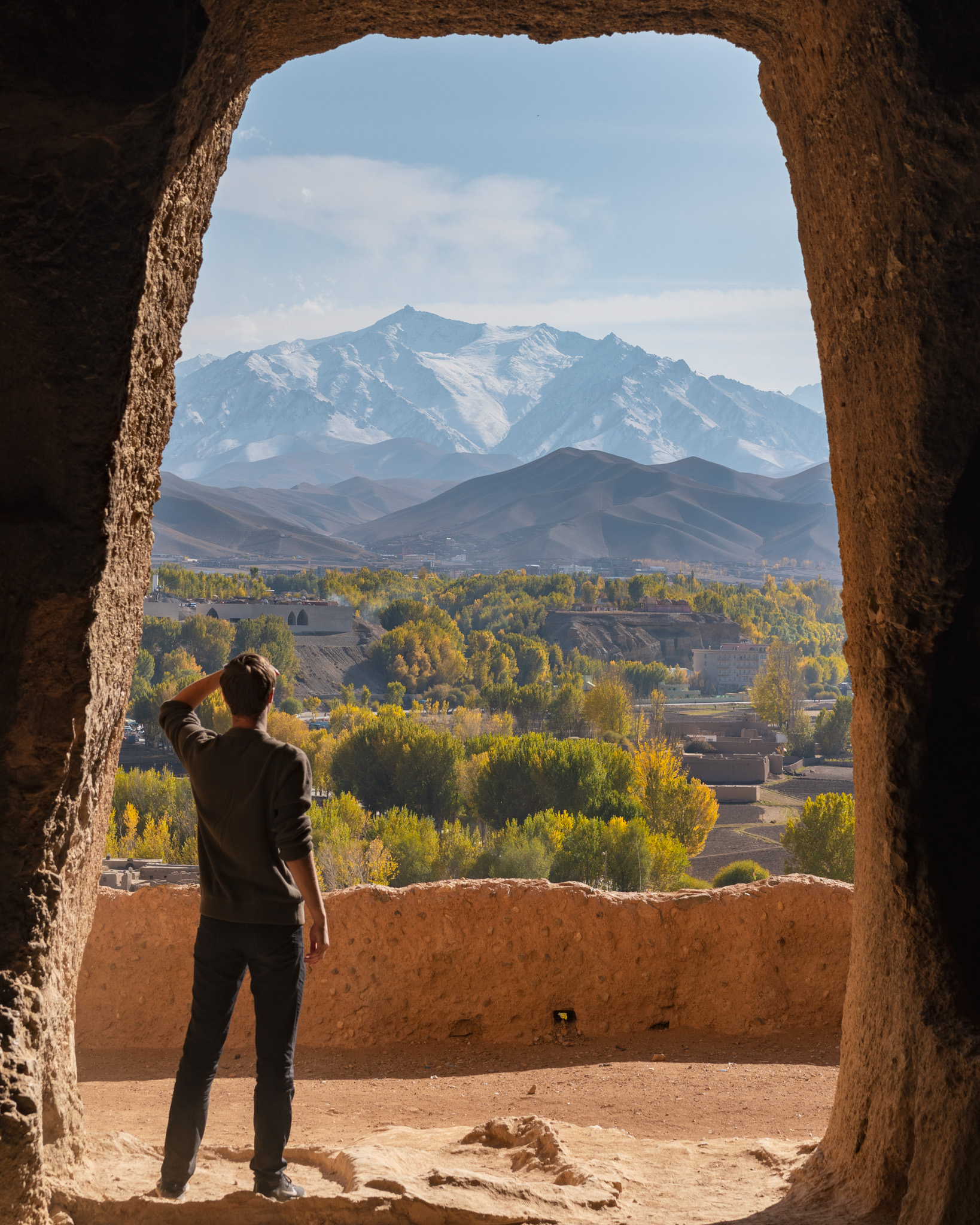
The Wakhan Corridor is far different from the Afghanistan that most people know. It is a remote and mountainous strip of land bordered by Tajikistan, Pakistan, and China. The Wakhan Corridor separates the Pamir and Karakorum mountains and is home to the source of the Amu Darya (Oxus).
It’s one of the safest parts of the country (only Bamiyan could be considered slightly safer) and is the perfect place for nature lovers who want to experience Afghanistan.
Things to do in the Wakhan Corridor
- Ishkashim Bazaar – If you’ve only got a bit of time then your best bet is to spend it in Ishkashim, checking out its bazaar and getting a feel for life in Afghanistan.
- Trekking – By far the most popular activity in the Wakhan Corridor is trekking, and if you’ve got a decent amount of time in the Wakhan then you definitely should go on a trek. Popular treks include the one to the Little Pamir or the one to Noshaq Base Camp.
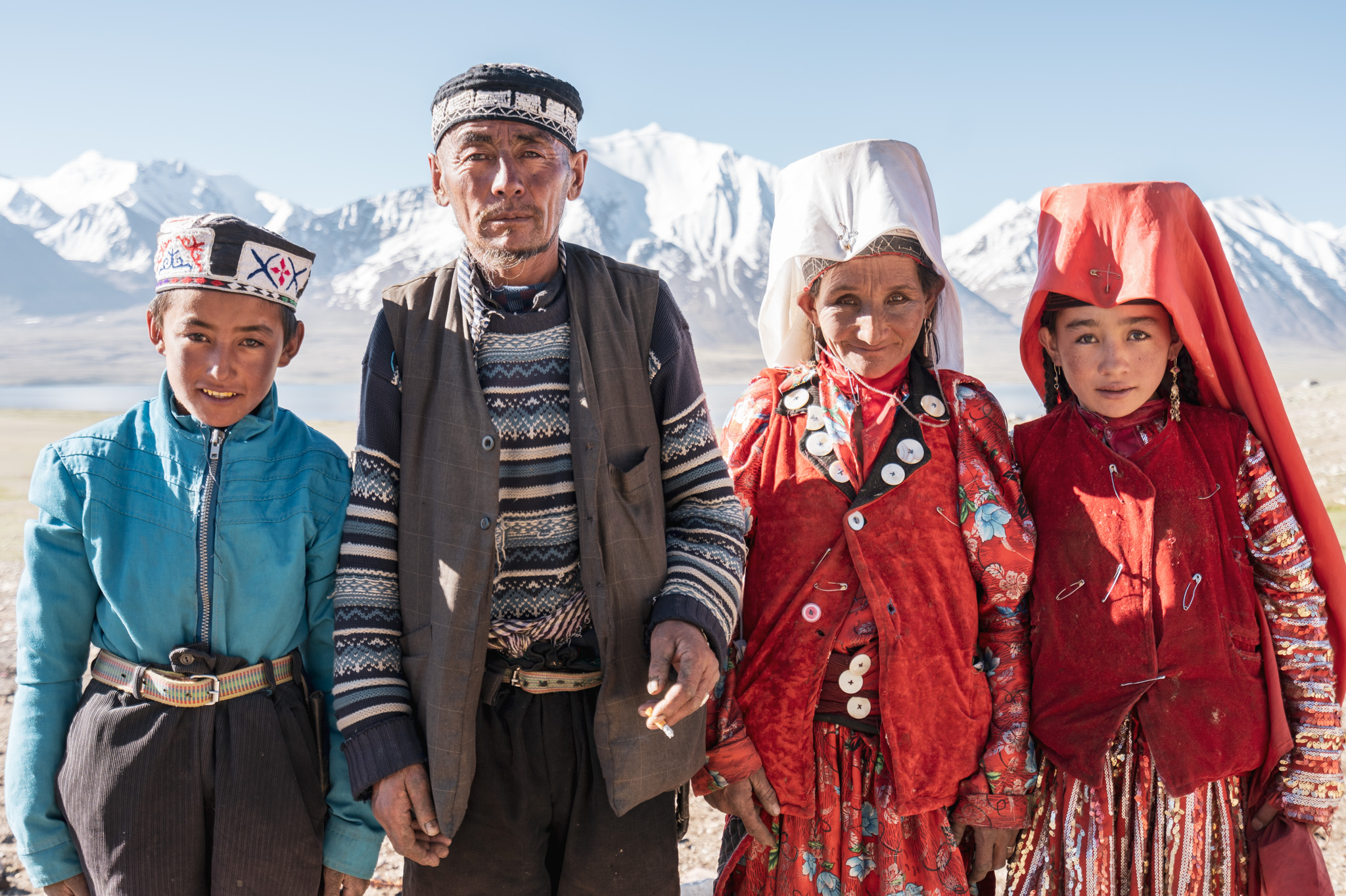
Where to stay in the Wakhan Corridor
Accommodation in Wakhi villages in the Wakhan Corridor comes in the form of basic guesthouses that are usually run by the only English speakers in town.
When trekking to the Little Pamir, you’ll be required to do a bit of camping until you reach the Kyrgyz nomads who you can stay with.
Getting to the Wakhan Corridor
Currently, the only safe way to get to the Wakhan is via Tajikistan. You’ll need to cross the border at Ishkashim, a town 3 hours south of Khorog. Be sure to have a second Tajik visa for your return trip, otherwise, you’ll be stuck.
The road connecting Ishkashim with the rest of Afghanistan goes through Taliban territory and is not safe for travel.
To learn more, check out my in-depth Wakhan Corridor travel and trekking guide .
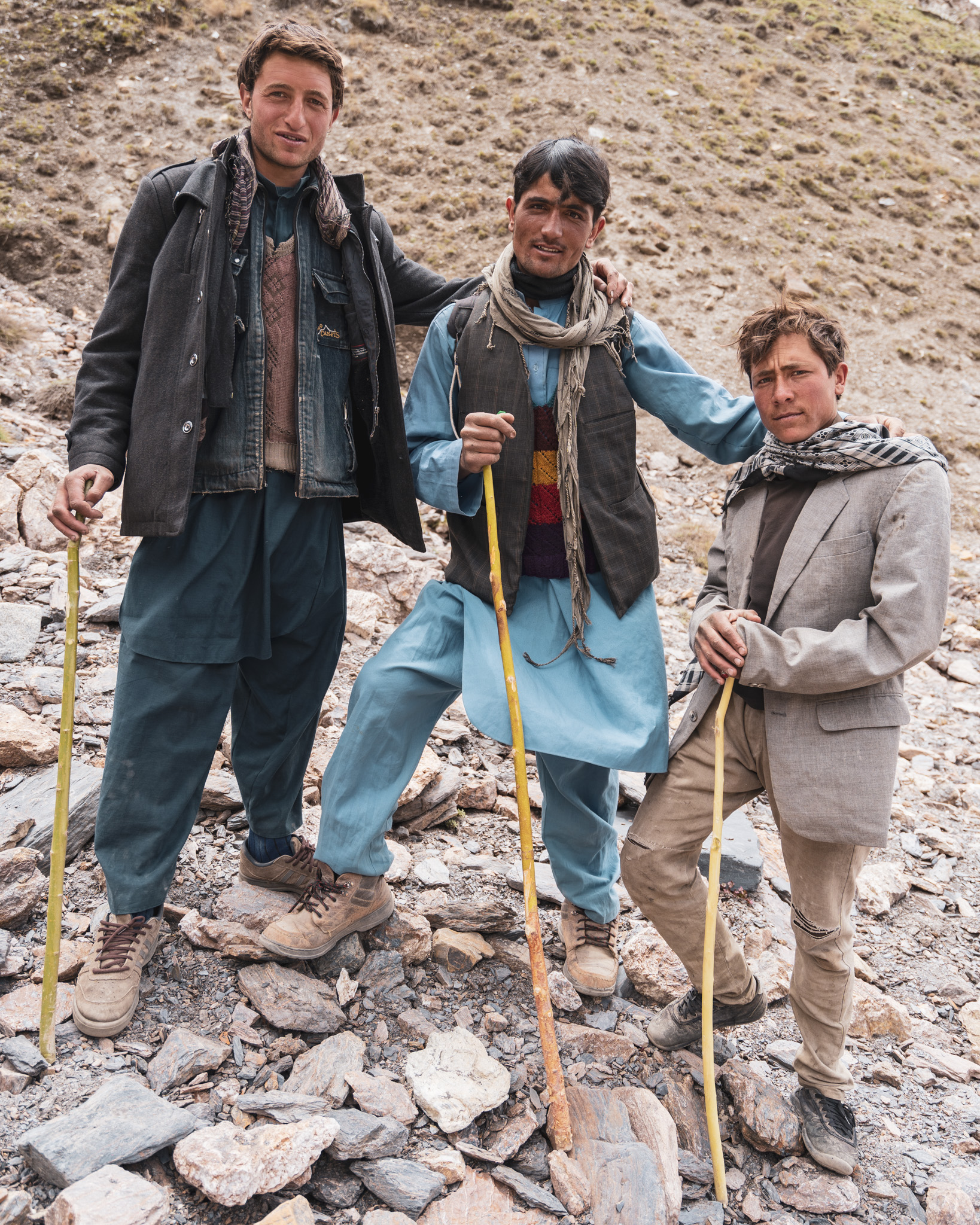
When to visit Afghanistan
The best time to visit Afghanistan depends on which part of the country you want to visit. In general, spring and autumn are the best times of the year to visit, as cooler (but not freezing) temperatures cover most of the country.
Autumn is extra beautiful, as the grasses and trees all over the country turn beautiful shades of orange and yellow.
Summertime in mainland Afghanistan is very hot – low elevation cities such as Mazar-e-Sharif and Herat can reach close to 50 degrees. I don’t advise visiting these places during the summer, as it will make your trip pretty uncomfortable. However, the Wakhan Corridor is a great summer destination due to its high altitude.
Winter covers Afghanistan in a blanket of snow, and temperatures will be very cold. I’ve seen photos from some of my Afghan friends, and the country does look beautiful at this time of year (although you better pack a decent jacket).
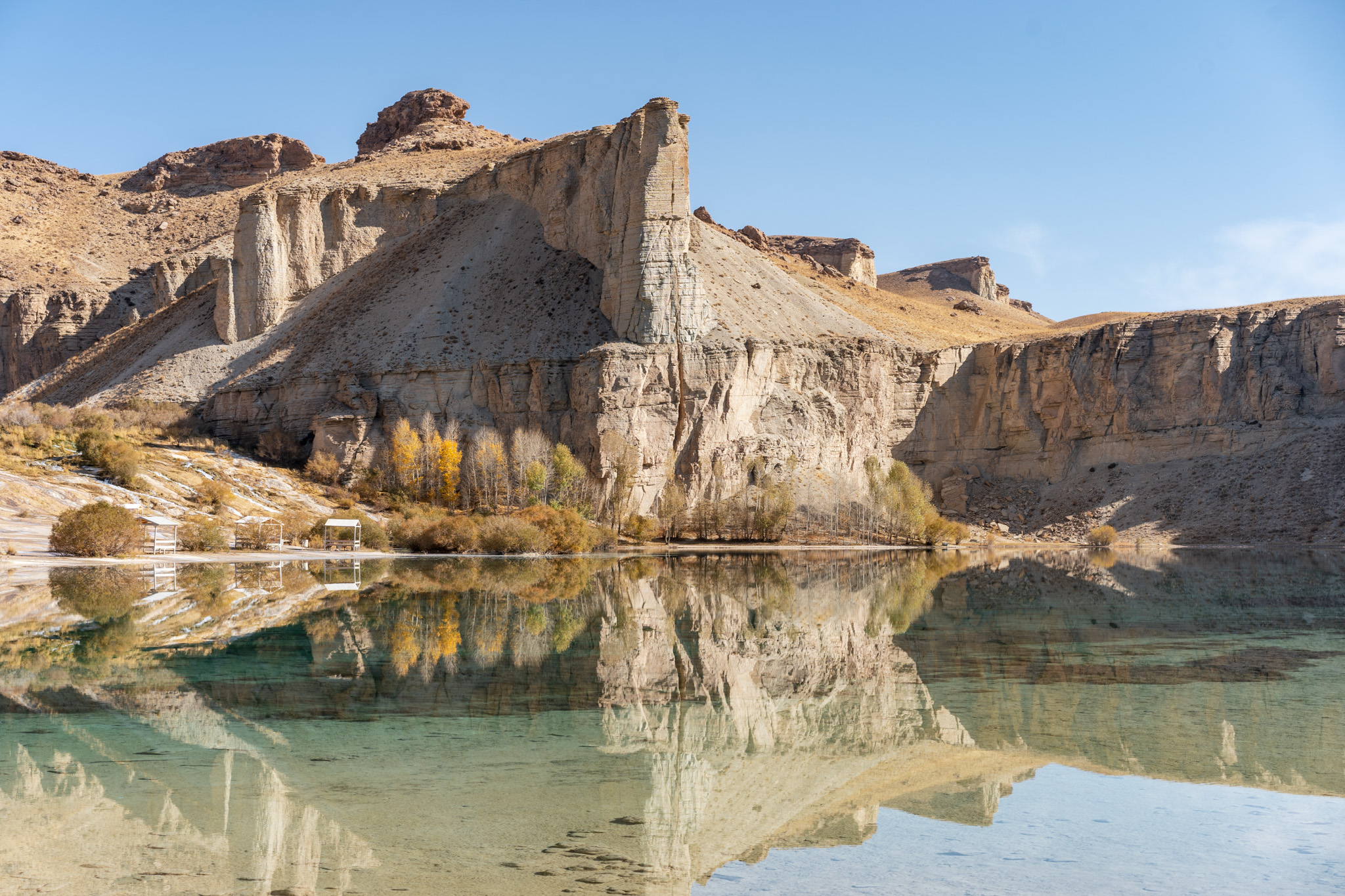
Internet in Afghanistan
Internet access in Afghanistan isn’t great.
In the mainland, you can pretty easily pick up a SIM card from one of the major telecoms with a few gigabytes of data for about 500 Afghani.
Unfortunately, I found that this internet rarely worked in Kabul due to huge amounts of people overloading the towers. Mobile data connection speeds tended to be higher in lesser-populated areas such as Bamiyan. Herat and Mazar-e-Sharif were somewhere in the middle.
There isn’t any way to buy an Afghan SIM card in the Wakhan Corridor, and there are no towers to provide you with a signal anyways. If you purchase a Tajik SIM before leaving Tajikistan, it’s possible to connect to the Tajik cell towers on the opposite side of the Wakhan Valley. See my Wakhan Corridor guide for more info on this.
WiFi is available in some cafes in Kabul, although it’s always extremely slow. In general, don’t count on doing much photo/video uploading while in Afghanistan – sending emails and browsing the web will work alright though.
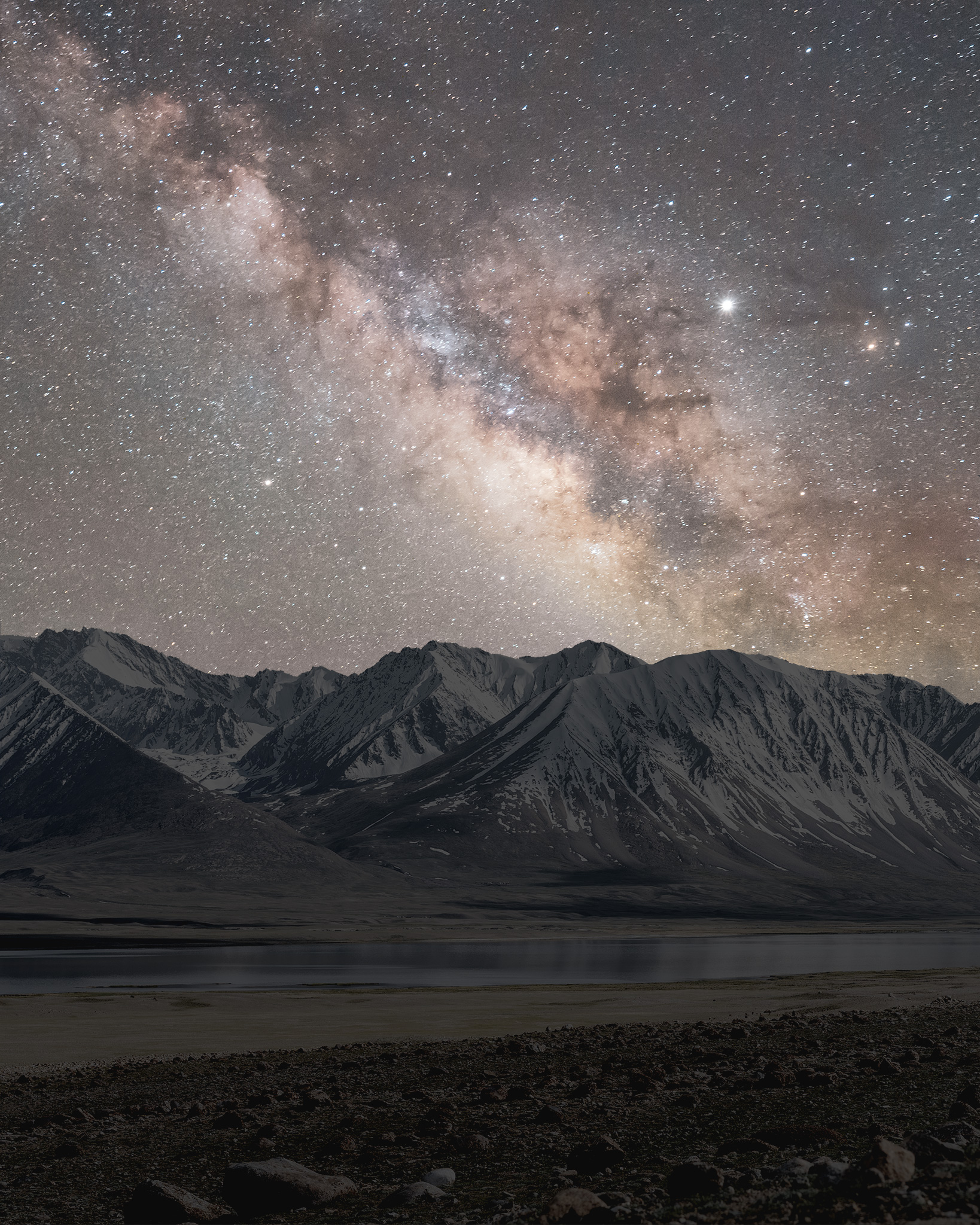
Female Travel in Afghanistan
Female travel in Afghanistan comes with its own unique set of challenges on top of the ones that men experience.
Afghanistan is still an extremely religious and conservative country (although not quite on the level of Saudi Arabia ). Here are a few things you need to know:
- You should always wear a hijab – Most local women wear a full burqa, so it’s at least expected that you wear the more “moderate” hijab.
- If you’re travelling with a guy, you will be ignored – While it may seem disrespectful, Afghan men are actually attempting to show you respect by not interacting with you. This isn’t an issue when the local men are liberal and educated.
- Restaurants are segregated – Every restaurant has a family and singles section, and the singles section is filled entirely with men. You can sit in either section, but be prepared for a lot of stares if you sit in the single section.
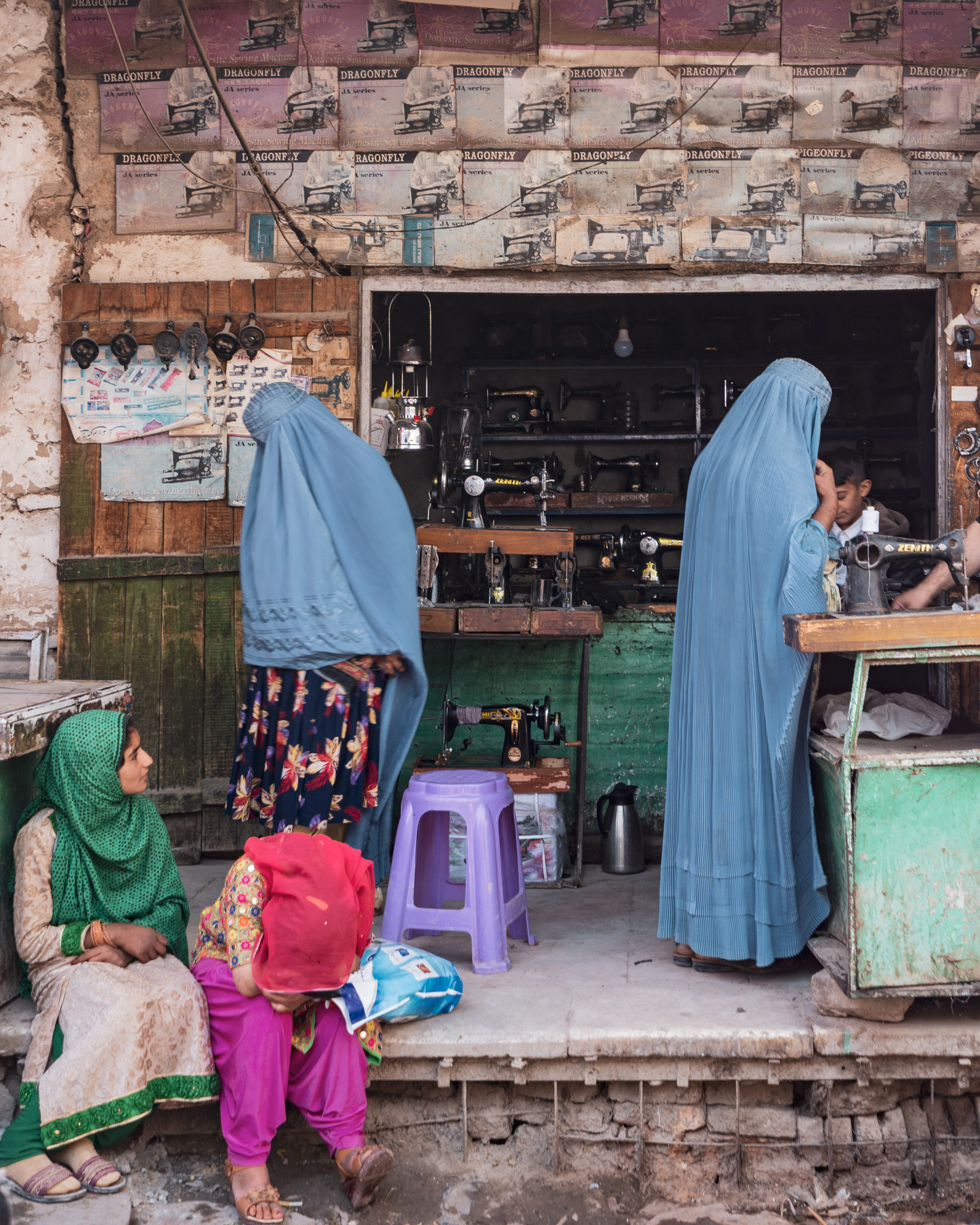
Solo Travel in Afghanistan
It’s totally possible to solo travel in Afghanistan. In fact, all five of my weeks in Afghanistan were solo (although I did go to Bamiyan with a friend from Kabul).
If you’re planning to travel solo, my best advice is to keep in touch with a family member or friend back home and always let them know what your plans for the day are (and check-in at the end of every day).
For certain things (overland travel, visiting Old Balkh), I recommend travelling with a local friend. Unless you speak Dari, it’s not a wise idea to be all alone in parts of rural Afghanistan where there is little government presence.
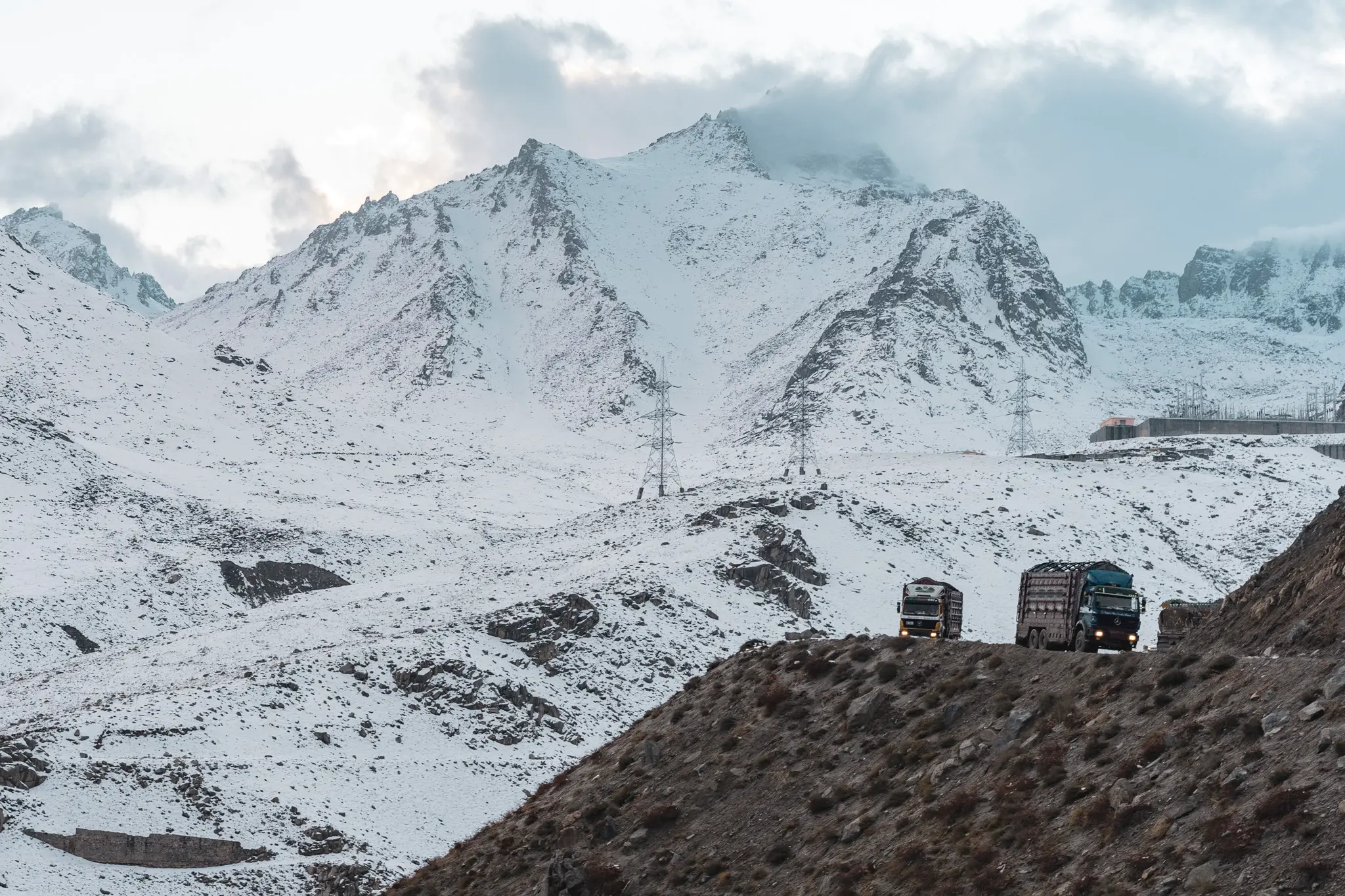
How much does travel in Afghanistan cost?
While Afghanistan is one of the poorest countries in the world , it certainly isn’t one of the cheapest to travel to.
There is very little travel infrastructure in Afghanistan, and almost all of it is geared towards employees of NGOs. Overland travel is unsafe, so expensive flights are often the only option to get around.
Because of this, travel in Afghanistan tends to cost anywhere from $40 to $70 per day .
Here are some sample costs:
- Accommodation – $15-25 per day for a single or double room is the standard rate throughout Afghanistan. If you’re looking for a place with a lot of security, costs can increase to a couple hundred a night.
- Food – $5 – $15 per day. Local street food is very cheap, although there are nicer international restaurants in Kabul where you can spend a bit more.
- Taxis – You’ll need to use taxis to get around Kabul, as well as to/from the airport in other cities. A 15-minute ride in Kabul will usually cost around $4-6. You’ll need to negotiate.
- Flights – If you want to visit more than one city, you will need to take a domestic flight at some point. On most main routes (Kabul -Herat or Kabul – Mazar-e-Sharif), tickets are about $100 each way. Flights are one of the biggest expenses when travelling in Afghanistan.
- Entrance tickets – Usually fairly cheap. The most expensive ones are in Kabul, and these are usually around $3-4 for foreigners.
- Visas – Afghan visas cost anywhere from $80 to $250 depending on your nationality and where you apply. If visiting the Wakhan Corridor, add another $140 for two Tajikistan e-visas.
Remember, these costs are for independent travel in Afghanistan. If you choose to travel with a tour operator, you’ll likely have all these things included and only need to worry about the up-front cost.
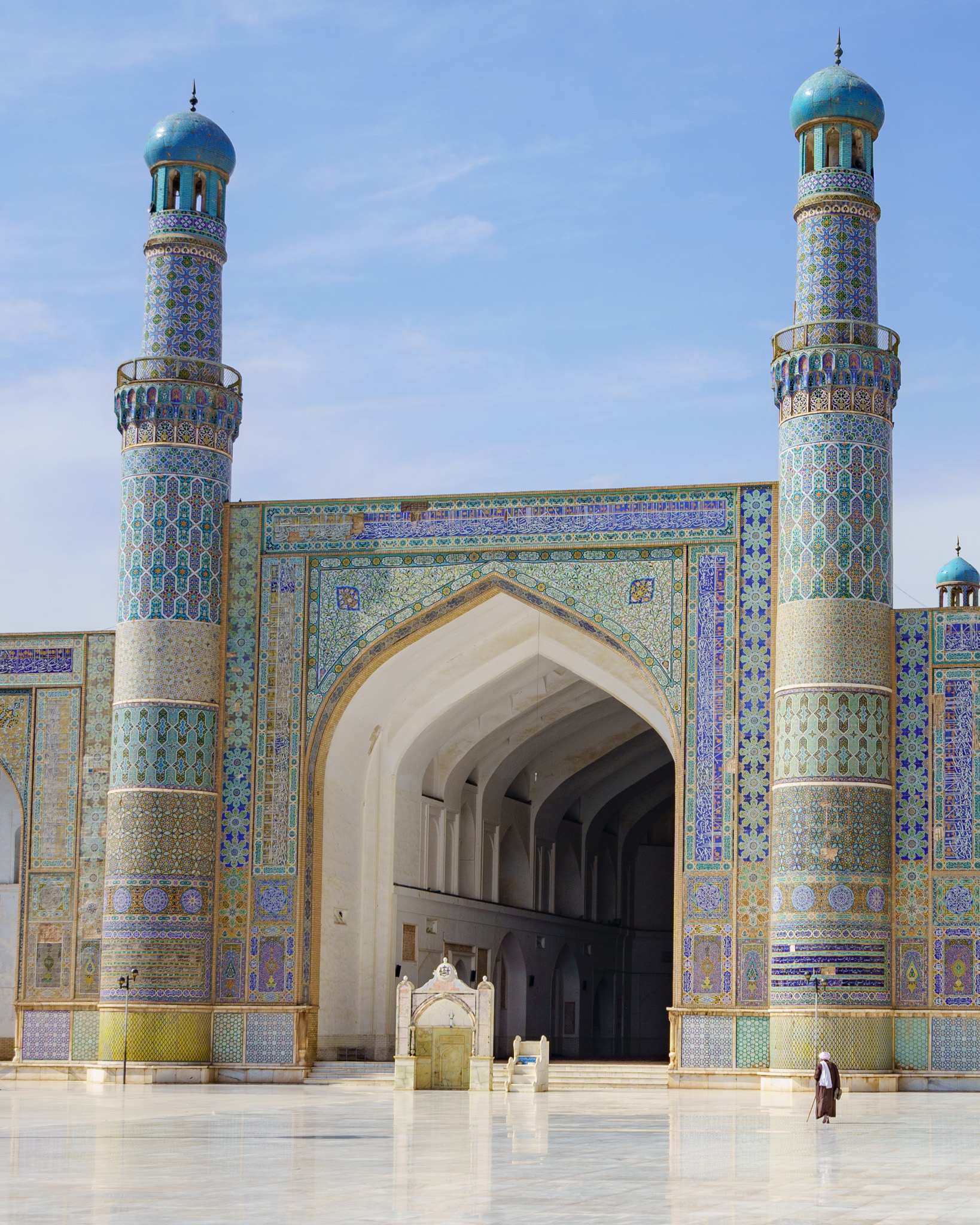
Couchsurfing in Afghanistan
Couchsurfing is a fantastic way to meet locals all over the world, and you should really try to use it when you’re in Afghanistan.
I met some amazing friends on it and they really helped answer any questions I had about their country. Afghanistan has an active Couchsurfing community and it’s one of the best places to find local insider knowledge about the latest situation in the country.
Resources for travel to Afghanistan
Before travelling to Afghanistan, I did a crap ton of research – and I highly suggest that you do too. You need to be prepared and understand what you’re getting yourself in to.
Here are some of my favourite resources for travel in Afghanistan (other than this guide, of course!):
- Lost With Purpose – My friend Alex has a wonderful guide on travel in Afghanistan and it helped me out a lot when I was planning my trip.
- UnchartedBackpacker – Steven has some great photos and info about Afghanistan.
- WikiVoyage – A ton of detailed info about visiting Afghanistan, although some is a bit out of date.
- Wakhan Corridor Guide – My travel guide to the Wakhan Corridor. Check it out for a bunch of information on travel & trekking in the Wakhan.
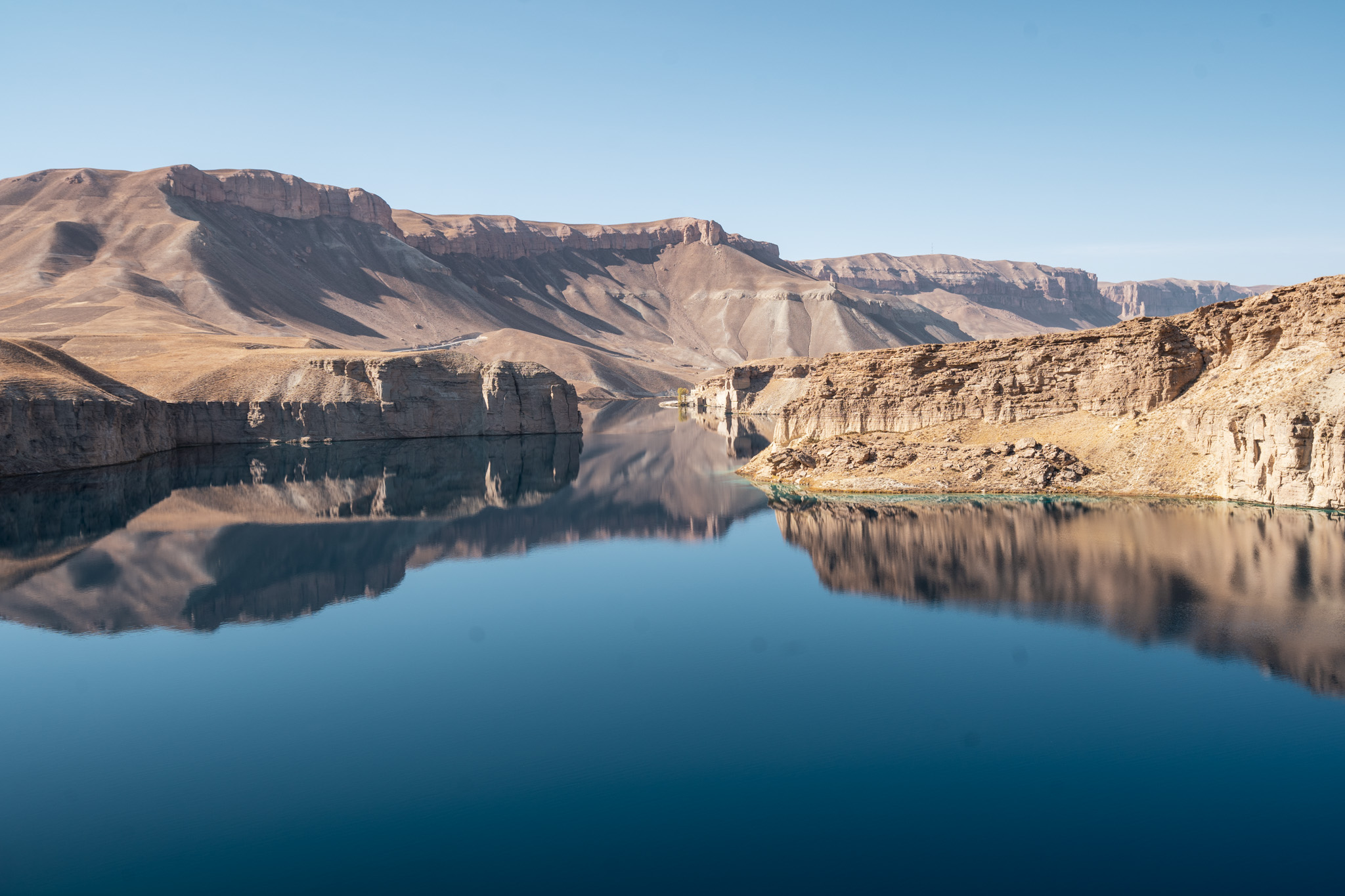
Afghanistan Travel Guide Wrap-up
I hope this post has helped you learn more about what it’s like to travel in Afghanistan! It’s an incredible country, and I only hope that one day the security situation improves enough so that more people get the chance to visit.
Feel free to ask me any questions about travelling in Afghanistan in the comments below.
Safe travels!
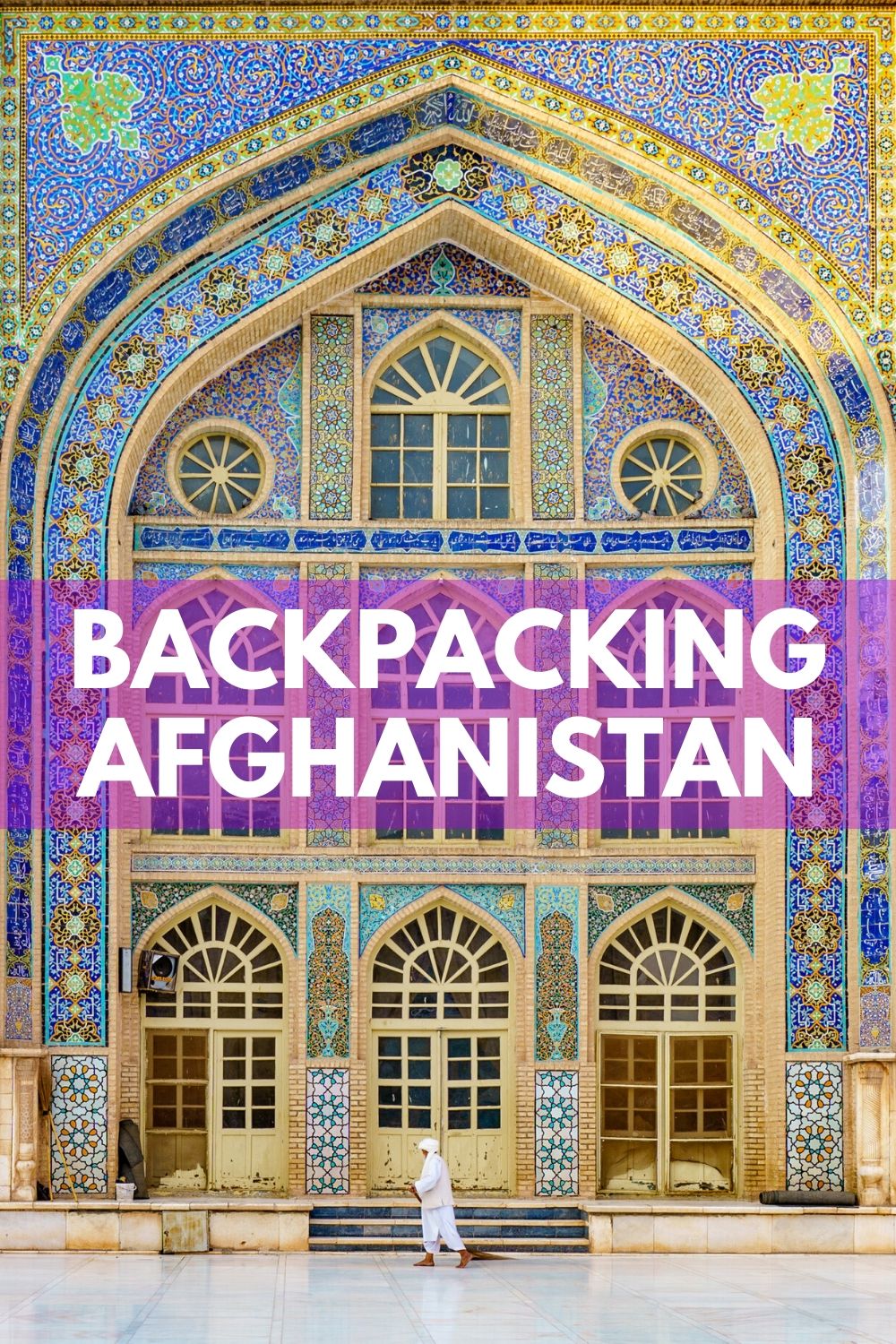
21-year old Canadian dude who loves to visit off-the-beaten-path places, climb tall mountains, and try delicious foods.
Read more about me
Want more like this?
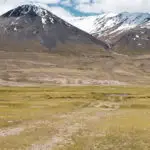
2 thoughts on “ Travel in Afghanistan: The Ultimate Backpacker’s Guide ”
amazing !!!! it’s one of my dreams to travel to Afghanistan (one day!!!!!!) your blog is really amazing and your pictures are gorgeous too, great article 🙂
Thank you! Glad you like the blog 🙂
Leave a Reply Cancel reply
Your email address will not be published. Required fields are marked *
Afghanistan

- 3 Other destinations
- 4.1 Climate
- 4.2 Terrain
- 4.4 History
- 4.5 Electricity
- 4.6 Culture
- 6.2 By plane
- 6.5 By train
- 7.1 By plane
- 8.2 Carpets
- 8.3 Sheepskin coats
- 8.5 Other goods
- 15 Stay safe
- 16 Stay healthy
- 17.1 Basic etiquette
- 17.2 Religious etiquette
- 17.3.1 Politics
- 17.3.2 Personal subjects
- 18.1 Mobile phones
- 18.2 Satellite phones
Afghanistan is a landlocked country at the crossroads of Central and South Asia. The country shares borders with Uzbekistan , Turkmenistan , Tajikistan , Iran , Pakistan , China , and the disputed Kashmir territory.
Once the centre of many powerful empires, the country has been in chaos and turmoil since the 1970s. Political unrest is rampant, and the country suffers from many social problems, such as war, drought, a public health crisis, terrorism, corruption, warlordism, poverty, and low literacy rates.
However, under less extreme circumstances, this vast, mountainous country offers a lot to the adventurous, thrill-seeking traveller. Its landscapes are simply majestic, the history lover can appreciate numerous historical sites from all eras, and the architecture lover can feast their eyes on such wonderful Islamic architecture. There's even a shrine that houses a cloak once worn by Prophet Muhammad, the founder of Islam.
Afghanistan is a melting pot of cultures, with Pashtuns, Tajiks, Hazaras, and Uzbeks constituting the largest ethnic groups. Islam is the state religion, hence the name "Islamic Emirate of Afghanistan". A majority of Afghans are Sunni Muslims, although about 20% of them are Shia Muslims.
Under less dire circumstances for the country, tourists might find themselves being treated as celebrities here; in fact, they might be showered with a lot of hospitality and care, even if they unintentionally make a few cultural blunders.
Regions [ edit ]

The south and east are predominantly Pushtun and the Hindu Kush mountain area has many Hazara, but all regions have considerable mixing of ethnic groups.
English spellings of Afghan place names vary as there is no regulation of names when written in the Latin script. For example, Q may replace K as in Qandahar or Qunduz. Kunduz will be seen spelled as Konduz, Qunduz, Qundoz, Qundoze and variations on these. Bamiyan is often spelled as Bamian or Bamyan. Khowst may be spelt as Khost.
Cities [ edit ]
- 34.532778 69.165833 1 Kabul - in the east, the capital city
- 36.758056 66.898889 2 Balkh – once one of the greatest cities in the region and capital of ancient Bactria . Although much of it lies in ruins, the remaining architectural and cultural elements are little changed since Alexander the Great set foot there.
- 34.816667 67.816667 3 Bamiyan - The remains of the Buddhas. Once considered one of the wonders of the world, these tall stone carvings were destroyed by the Taliban in a notorious act of cultural vandalism.
- 33.549167 68.423333 4 Ghazni - in the south-east, between Kabul and Kandahar
- 34.341944 62.203056 5 Herat - in the west, gateway to Iran, has a strong Persian influence and several interesting historical sites
- 34.430278 70.452778 6 Jalalabad - in the east, between Kabul and the Khyber Pass
- 31.62 65.715833 7 Kandahar - a very conservative city in the south. Known as the home of the Taliban.
- 36.728889 68.856944 8 Kunduz - a major city in the northeast, and crossing point to Tajikistan
- 36.7 67.116667 9 Mazar-e Sharif - home to the impressively tiled Blue Mosque, and the staging point for trips into Uzbekistan. Ethnically diverse, Mazar is considered the most liberal city in the country after Kabul.
Other destinations [ edit ]
- 34.839722 67.230833 1 Band-e Amir National Park – 5 stunningly turquoise lakes in a remote and beautiful setting not far from Bamiyan
- 34.11 71.111667 2 Khyber Pass – the gateway to India and historic route of invasion and trade
- 34.396386 64.515888 3 Minaret of Jam – well off the beaten path but some say worth the journey – possible as a roundtrip from Herat or when traversing the Central Route from Herat to Kabul
- 35.25 70.75 4 Nuristan - an isolated mountain area with its own culture
- 35.266667 69.466667 5 Panjshir Valley – a beautiful trekking area leading to the famous Anjuman Pass
- 35.313721 69.037259 6 Salang Pass – a high mountain pass and tunnel linking Kabul to the north
- 35.103 69.232 7 Shamali Plain – a green plain north of Kabul that produced a lot of the food for central Afghanistan. From Kabul it extends north through Charikar , Parwan province to Jabal os Saraj . The Taliban destroyed the irrigation systems and it is just beginning to recover.
Understand [ edit ]
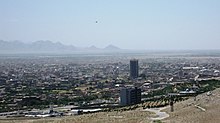
Afghanistan has been in the news since the late 1970s for all the wrong reasons. While visiting has not been advisable for many years, it has much to offer the intrepid traveller. However, even the more adventurous tourists should consider looking elsewhere for thrill-seeking.
Climate [ edit ]
Temperatures in the central highlands are below freezing for most of the winter, and snow is common at higher elevations. Summertime highs in lower elevations (such as Jalalabad or Mazar-e Sharif ) can exceed 50°C/120°F. In higher areas such as Kabul, summer temperatures can be 30°C/90°F and winter around 0°C/30°F. The most pleasant weather in Kabul is during April, May and September.
Terrain [ edit ]
Mostly rugged mountains; plains in north and southwest. The Hindu Kush mountains run northeast to southwest, dividing the northern provinces from the rest of the country, with the highest peaks found in the northern Wakhan Corridor . South of Kandahar is desert.
The lowest point is Amu Darya at 258 m, and the highest is Nowshak at 7,485 m.
Afghanistan is bordered by Pakistan to the south and east, Iran to the west, Turkmenistan , Uzbekistan and Tajikistan to the north. There is a short border with China to the far northeast, but in extremely inaccessible terrain.

People [ edit ]
Afghanistan is an ethnically diverse country. Tribal and local allegiances are strong, which complicates national politics immensely. The largest ethnic group is the Pashtuns, followed by Tajiks, Hazaras, Uzbeks and others.
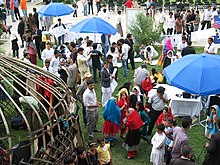
Baloch tribesmen, still largely nomadic, can be found anywhere between Quetta in Pakistan and Mashad in Iran, including much of western Afghanistan. They make marvellous rugs , if somewhat simple.
Hazaras in the central mountains look much more similar to East Asians than other Afghans do. According to some theories, they are descended from Genghis Khan's Mongol soldiers .
The two largest linguistic groups speak Pashto and Dari (Afghan Persian). Pashto speakers predominate in the south and east, Dari in the north, west and central Afghanistan. About 11% of the population have Turkic languages such as Uzbek or Turkmen as their first language. Many of them live in the north, near the borders with Uzbekistan and Turkmenistan . Minor native language groups include Nuristanis, Pashais and Pamiris, found in small pockets in the east and northeast.
There are also thousands of Hindus and Sikhs living in different cities, but mostly in Kabul , Jalalabad , and Kandahar .
History [ edit ]
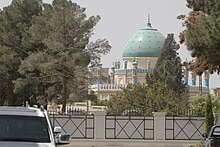
Afghanistan borders Persia , Central Asia and South Asia , and various Silk Road routes cross it to connect those regions. It has been described as "the crossroads of Asia" and has history of trade going back to before 2000 BCE.
The country has a long history of conflict – raiding and banditry, battles between tribes, and resistance against invaders including several Persian Empires , Alexander the Great , the Arabs during the great expansion of Islam (starting with their capture of Herat in 652 CE and spread over several centuries), the Mongol Empire in the 13th century, and the British Empire in the 19th. Its recent history is no exception: the Soviet Union invaded late in the 20th century and a U.S.-led coalition invaded early in the 21st.
The Afghans have given all invaders trouble; the country has been so difficult to conquer that it is known as the Graveyard of Empires .
The modern-day country was founded by secession from the Persian Empire in 1709. Since then, there have been several dynasties and at times the Afghans ruled what are now Iran, Iraq, most of Pakistan and parts of India. Mohammed Zahir Shah was the last king, ruling from 1933 until 1973, when the constitutional monarchy was overthrown in a coup and the country became a republic.
In the late 19th century, Afghanistan became a buffer state in the "Great Game" between the British Empire and the Russian Empire . After the Second Anglo-Afghan War Britain gained control of Afghanistan's foreign relations as part of the Treaty of Gandamak of 1879. In 1893, the ethnic Pashtun and Baloch territories were divided between Britain and Afghanistan by the Durand Line, which forms the modern-day border between Pakistan and Afghanistan. Afghanistan became fully independent from the British in 1919.
In the 1960s and early 70s, Afghanistan was a popular destination for adventurous travellers, part of the "Hippie Trail" Istanbul to New Delhi overland route. Dirt cheap, culturally fascinating and with plenty of excellent hashish; what more could a hippie want? However, it has not been anywhere close to safe since the Russian invasion of 1979.
A coup in 1978 brought a socialist regime to power, but they were by no means universally accepted; some of both their officials and their Soviet advisers were killed. The Soviet Union invaded in December 1979 to support the regime and a long messy war ensued, with the Soviet and their Afghan government allies on one side and several groups known as the Mujahedeen on the other. The Mujahedeen were armed and funded mainly by the United States, Saudi Arabia, other Gulf Arabs, Iran and China, and many were trained in Pakistan. By February 1989, all Soviet forces withdrew from the country, and the Soviet Union collapsed two years later in 1991.
After the Russians left, the country was somewhat chaotic, apparently reverting to its tribal past with no effective central government and various Mujahedeen leaders ruling separate fiefs and sometimes fighting each other. Taliban (lit. students ) — made up primarily of ethnic Pashtuns and inspired by the fundamentalist Deobandi interpretation of Sunni Islam — emerged as a political force in the early 90s, heavily backed by (some would say created by) Pakistani Intelligence and largely funded by the CIA, to end "warlordism" and bring security to the country. They seized Kabul in late 1996 and controlled most of the country by 2000, aside from some areas in the northeast.
Al-Qaeda (translated, the base ) began in 1988 as a group of mostly Arab volunteers aiding the Mujahedeen; like Taliban they were supported in the 90s by Pakistan and the US, but they also got considerable Arab support. By 2000 they were led by Saudi Arabian Osama bin Laden, and guided by the very strict Wahhabi interpretation of Sunni Islam.
Al-Qaeda would later orchestrate the September 11, 2001 terrorist attacks in the United States. The US government demanded that the Taliban hand over Osama bin Laden and other Al-Qaeda militants for trial in a US court. Taliban refused, though they did offer to try Osama in their own shariah court if the US government shared "solid evidence" of his alleged guilt with them, and also expressed willingness in principle to consider extraditing Osama to a third country for a trial before a shariah court there. The US refused to share whatever evidence they had with the Taliban and considered the Taliban's offers insufficient, so they and their allies chose to take military action with support from anti-Taliban Afghans — mainly Tajik, Uzbek and Turkmen warlords from the north of the country who fought in the Northern Alliance — causing the Taliban regime to fall in December 2001.
The same month, representatives from all ethnic groups of Afghanistan met in Germany and agreed to form a new government with Hamid Karzai as Chairman of the Afghan Interim Authority. Following a nationwide election in 2004, Hamid Karzai was elected as President of the Islamic Republic of Afghanistan. A year later, in 2005, legislative elections were held and the country's parliament began functioning again. In addition to occasionally violent political jockeying and ongoing military action to root out anti-government elements, the country sufferred from widespread election fraud, poverty, corruption, and opium cultivation.
In 2021, U.S.A. and other NATO countries withdrew their troops, and the Taliban seized control of most of the country. The U.S.-backed Afghan government swiftly collapsed, and the Taliban formed a new government. Though active fighting between different armed forces appears to have greatly decreased since then, terrorism, such as from the Islamic State organization, is still a problem. A more pressing issue is shortages of food and other goods due to drought and sanctions that were imposed due to the overall human rights situation and especially the draconian restrictions the Taliban imposed on women, who are now not permitted to go to university and allowed to hold jobs in very few professions.
Electricity [ edit ]
Officially 220 V 50 Hz. Electricity supplies are erratic, but slowly improving in major cities. Voltage can drop to below 150 V in some places. The Afghans' enthusiasm for homemade generators or modifying low quality ones means that the frequency and voltage can also vary wildly.
There are three types of electrical outlets likely to be found in Afghanistan. They are the old British standard BS-546 and the newer British standard BS 1363. But the European standard CEE-7/7 "Schukostecker" or "Schuko" is the standard and the most common. Generally speaking, Canadian and Americans should pack adapters for these outlets if they plan to use North American electrical equipment in Afghanistan. You may also find cheap universal adapters in the local markets, but make sure you have an understanding of electrical systems and the nature of adapters.
Culture [ edit ]
Afghanistan, for thousands of years, has been a crossroads of many civilisations, in experience of empires and influx of cultures, earning it its dubious distinction as the "roundabout of the ancient world". It maintains its Persian influence and preserves a heritage and traditions of the country's multiple tribal groups.
Read [ edit ]
- Afghan Scene Magazine [dead link]
- A Short Walk in the Hindu Kush by Eric Newby – a hilarious account of pioneer trekking in Nuristan in the 1950s
- The Places in Between by Rory Stewart – a fascinating post 9/11 travelogue of Stewart's walk from Herat to Kabul just after the fall of the Taliban.
- The Kite Runner by Khalid Hosseini – a beautiful and heartbreaking tale of childhood in Afghanistan
- Good Morning Afghanistan by Waseem Mahmood - a true account of the setting up of the first public radio station in Kabul after the Taliban fell.
- An Unexpected Light: Travels in Afghanistan by Jason Elliot—a travelogue from the period between the expulsion of the Soviets and the ascension of the Taliban. He went everywhere.
- For a Pagan Song by Jonny Bealby - a brilliant account of the author's journey to retrace the footsteps of Rudyard Kipling's heroes in The Man Who Would Be King to discover the land of Kafiristan (now Nuristan ) and the people who inhabit the region.
- Flashman - a hilarious historical novel recounting the disastrous 1842 retreat from Kabul during the First Anglo-Afghan War
Talk [ edit ]
The official languages of Afghanistan are Dari (an Afghan dialect of Persian ), which serves as the country's lingua franca, and Pashto , spoken by the largest and most influential ethnic group, the Pashtuns. According to the CIA World Factbook, 78% of Afghans speak Dari, and 50% speak Pashto. Many Afghans are bilingual in those two languages.
You're more likely to find a Pashto speaker in areas close to the border with Pakistan than anywhere else. There are also some speakers of Urdu along that border and of Persian along the border with Iran .
As Afghanistan is a diverse, multi-ethnic country, hundreds of languages are spoken throughout. Some of the most commonly spoken minority languages include Uzbek , Turkmen , Pashayi , Baloch , and Nuristani .
Although English is taught from the fourth grade, very few Afghans speak English. According to the CIA World Factbook, less than 5% of all Afghans speak English. You're likely to find an English speaker in the capital city, Kabul . A solid knowledge of Dari and Pashto is essential for the daring, independent traveller.
Thanks to the influence of Indian cinema and cordial relations between the central government and India , a sizeable number of people can speak and understand Hindi . Approximately 2% of all Afghans speak Urdu . You're likely to find speakers in Kabul.
The literacy rate in Afghanistan is low.
Get in [ edit ]
You probably need to get a visa in advance. You should also register your arrival and get a permit to visit the regions where your destinations lie. There may be severe confusion about how to get the permit.
Visas [ edit ]
Most visitors need to apply for a visa in advance. There does not seem to be any uniform visa policy since the Taliban takeover (the Afghanistan Foreign Ministry's website 's visa page link was dysfunctional as of August 2023), but visas are indeed issued at a few embassies. It may be possible to get exceptions to some of the requirements. Tourist visas are one-month single-entry for all countries. For most travels to Afghanistan you need to explain the nature of your tour and places you intend to visit.
By plane [ edit ]
Kabul International Airport ( KBL IATA ) in Kabul is the main entry point to the country. As of 2024, the airlines based in out of Kabul include flag carrier Ariana Afghan Airlines and the privately-run Kam Air . Neither the airlines nor the airport are up to international safety standards.
By car [ edit ]
There are a number of roads into Afghanistan:
- From Peshawar , Pakistan , via the Khyber Pass to Jalalabad , in the east. See above for details.
- From Quetta , Pakistan, to Kandahar , in the south. This crossing is closed to third-country nationals.
- From Mashad , Iran to Herat , in the west. This border is open to foreigners.
- From Termez , Uzbekistan to Mazar-e Sharif , in the north. This border is open to third-country nationals.
- From Tajikistan to Kunduz , in the northwest. The security situation at this border was not considered conducive to passage as of 2019.
As of mid-2023, none of these routes were considered safe.
By bus [ edit ]
Buses run regularly between Jalalabad and Peshawar , Pakistan . Also, between Herat and Mashad , Iran . Afghani buses are thoroughly checked by Iranian border police for possible drugs, so expect delays.
By train [ edit ]
Afghanistan has never had a national railway network and while there are a few spur lines from neighboring countries, most notably to Mazar-e Sharif , there were no passenger trains as of 2020. However there are several border towns with passenger trains, from where it's possible to continue into Afghanistan on foot or by taxi.
Across the border from Northwest Afghanistan , the city of Termez in Uzbekistan sees trains from both Moscow and Tashkent . From Pakistan , it's possible to take a train from Quetta to the border town of Chaman and continue into South Afghanistan .
Get around [ edit ]
Flag carrier Ariana Afghan Airlines and Kam Air both operate flights between Kabul and Kandahar .
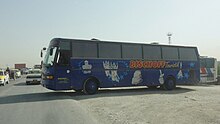
As of 2007, there was a network of public transportation between the country's cities. Buses plied some routes and Toyota vehicles had a near monopoly on minivan (HiAce) and taxi (Corolla) transportation.
A highway connects Kabul and Mazar-i-Sharif . The highway goes through the Salang Pass and across the Hindu Kush mountain range. Another highway links Kabul to Kandahar .
There were no metered taxis in large parts of Afghanistan. As of 2011, taxis were yellow and clearly identifiable. You were expected to strike a deal with the driver before entering the cab.
Jeeps and Land Cruisers were available for hire, as of 2011, along with drivers who spoke some English. There were tour operators in Kabul that could have provided a car and guide; these people were available for hire at Kabul International Airport. Petrol stations were scarce in the countryside, and fuel was expensive.
Paved roads are the exception, not the rule, and even those roads can be in poor repair. Once outside the major cities expect dirt roads (which turn to mud during rain or snow melt).
Buy [ edit ]
Money [ edit ].
The Afghani ( AFN ) is the currency of Afghanistan, denoted by the symbol " Afs " or " ؋ " (ISO code: AFN ). The current version of the afghani was introduced in 2002, with 1 afghani equal to 1,000 of the previous afghanis.
Banknotes of Afghanistan are issued in denominations of 1-, 2,-, 5-, 10-, 20-, 50-, 100-, 500 and 1,000 afghanis.
Carpets [ edit ]
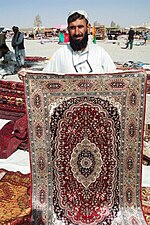
Afghanistan's most famous products are carpets and there are some fine deals to be had, though good haggling is absolutely required to get them.
There are carpets described as "Afghan", but also at least two other carpet-weaving traditions. The Baluchi tribes in the south and west weave fine rugs, and the Turkoman tribes in the north do as well; both groups are also found in neighbouring countries.
- Afghan rugs are generally made in city workshops, mainly for the export trade. They are often large; 3 x 4 metres (10 x 12 feet) is common. Most are quite coarsely woven to keep costs down, but others have a fairly fine weave. If you need a big rug for the living room at a moderate price, these are likely to be your best choice. Beware, however, that a large thick (because coarsely woven) carpet may be expensive to transport because it will be quite heavy.
- Baluchi rugs are usually small since nomadic people cannot use large looms; sizes up to 1.5 by 2 metres (4 x 7 feet) are common, but not many beyond that. They are popular with travellers, partly because they are fairly portable. One very common type is a prayer rug, just large enough for one person to kneel facing Mecca. Another is the "nomad's chest of drawers" — a bag, often beautifully decorated, that is a saddlebag when travelling and hangs on the wall of the tent when camped.
- Turkoman rugs , often labelled "Bokhara" in the Western rug trade, come in all sizes and a very broad range of quality. Some are woven by nomads, with the same range of sizes and types as Baluchi rugs. Others are made in city workshops; the best of these are almost as finely woven and almost as expensive as top-grade Persian carpets. One fairly common design is the Hatchli, a cross shape on a large rug.
All three types tend to use geometric patterns in the design, usually with red as the background colour and with repeated elements called "guls" to make the pattern. Generally, these are not as finely woven as carpets from the cities of neighbouring Iran. However, many of them are quite beautiful and their prices are (assuming good haggling ) well below those of the top Iranian carpets.
It is fairly common for rugs woven by nomads — such as many Baluchi rugs and some Turkoman — to show minor irregularities. The loom is dismantled for transport and re-assembled at the new camp, so the rug may not turn out perfectly rectangular. Vegetable dyes are often used, and these may vary from batch to batch, so some colour variation ( arbrash ) occurs and this may be accentuated as the rug fades. To collectors, most such irregularities fall into the "that's not a flaw; it's a feature" category; they are expected and accepted. In fact, a nice arbrash can considerably increase the value of a rug.
Turkoman designs are widely copied; it is common to see "Bokhara" carpets from India or Pakistan, China produces some, and the Afghan carpet designs show heavy Turkoman influence. To collectors, though, the original Turkoman rugs are worth a good deal more. Good Baluchi rugs are also quite valuable in Western countries. Afghan rugs, or lower grade Baluchi and Turkoman rugs, generally are not collectors' items; most foreigners will find the best buys among these. Experts might pay premium prices for the top-grade rugs, but amateurs trying that are very likely to get severely overcharged.
Kilims are flat-woven fabric with no pile. These are nowhere near as tough as carpets and will not survive decades on the floor as a good carpet will. However, some are lovely, and they are generally cheaper than carpets. Smaller items, such as purses, made or decorated with carpet and kilims are common.
Sheepskin coats [ edit ]
Another common product and popular souvenir is the Afghan sheepskin coat. These have the wool on the inside for warmth and the leather on the outside to block wind, rain and snow. They often have lovely embroidery. Two cautions, though.
- The makers use the embroidery to hide flaws in the leather; top-quality coats will have little or no embroidery.
- Australian customs have been known to incinerate these coats on arrival, to protect their large sheep population from diseases (notably anthrax) that poorly tanned Afghan products might carry. They might not be the only country that will do this.
Guns [ edit ]

Guns are very common in Afghanistan and some may be of considerable interest to historians and collectors.
Before the Russian invasion of 1979, most Afghan men carried rifles, but jezails were much the commonest type and pass rifles second; owning a repeating rifle was a major status symbol. Today most Afghans have automatic weapons — mainly Russian AK-47 or American M16 — so the older guns are readily available for any traveller who wants one.
Guns make rather problematic souvenirs. Importing a firearm anywhere can be difficult and it may be impossible in some places. If you are travelling overland and passing through several countries before you reach home, it is almost certainly not worth the trouble. Also, if you actually fire any Afghan gun, there is a risk that it will blow up in your face.
Other goods [ edit ]
There are also various bits of metalwork – heavily decorated pots, vases and platters, and some quite nice knives .
See [ edit ]
While ongoing violence has put an almost full stop to tourism in Afghanistan, the lack of visitors has nothing to do with the country's sights. This is a land full of mystical attractions, telling tales of ancient times and offering beautiful Islamic architecture, medieval city quarters and unexpectedly stunning nature.
Several sites are listed on UNESCO's World Heritage List . Most famous of course, were the ancient Buddhist sculptures of Bamiyan . The Taliban destroyed most of the 6th century statues in a cultural crime that outraged the world. Today, what remains in the Bamiyan valley is the silencing and still worthwhile sight of the empty niches. The salvaged pieces of what were once the largest statues of their kind in the world continue to provide a fascinating insight in the history of this place. Band-e Amir National Park , with its six interlinked lakes, is perhaps the finest natural attraction. At an altitude of 2900 meters, the blue waters in this protected natural area almost seem unreal against the sandy mountain sides that surround them.
Excellent mosques are to be found all around, with particularly grand examples in Mazar-i-Sharif and in the rapidly developing Herat . The Minaret of Jam , just north of Herat , is UNESCO listed.
Do [ edit ]
Eat [ edit ].

There are three main types of Afghan bread:
- Naan - Literally "bread". Thin, long and oval shaped, its mainly a white/whole wheat blend. Topped with poppy seeds, sesame seeds, nigella seeds, or some combination of these. Upon request, customers may be able to get all white flour and a helping of oil, which makes it rich and delicious.
- Obi Non - Uzbek-style bread. Shaped like a disc and thicker than naan. Usually made with white flour.
- Lavash - Very thin bread. Similar to the lavash elsewhere. Usually used as plating for meats and stews.
Rice dishes are the "king" of all foods in Afghanistan. The Afghans have certainly taken much time and effort in creating their rice dishes, as they are considered the best part of any meal. Wealthier families will eat one rice dish per day. The Afghan royalty spent much time on rice preparation and invention as evidenced in the sheer number of rice dishes in their cookbooks. Weddings and family gatherings must feature several rice dishes and certainly reputations can be made in the realm of rice preparation.
- Kabuli Pulao (or Kabuli Palaw, Qabili Palaw, Qabili Palau or simply Palau) - An Afghan rice dish consisting of steamed rice mixed with lentils, raisins, carrots, and lamb. It is baked in the oven and topped with fried sliced carrots and raisins. Chopped nuts like pistachios or almonds may be added as well. The meat is covered by the rice or buried in the middle of the dish. It is the most popular dish in Afghanistan, and is considered the national dish.
- Chalao -White rice. Extra long grains such as Basmati is required. First parboiled, then drained, and finally baked in an oven with some oil, butter, and salt. This method creates a fluffy rice with each grain separated, unlike Chinese or Japanese rice. Chalao is served mainly with qormas (korma; stews or casseroles)
- Palao - Cooked the same as chalao, but either meat & stock, qorma, herbs, or a combination are blended in before the baking process. This creates elaborate colors, flavors, and aromas for which some rices are named after. Caramelized sugar is also sometimes used to give the rice a rich brown color.
- Yakhni Palao - Meat & stock added. Creates a brown rice.
- Zamarod Palao - Spinach qorma mixed in before the baking process, hence 'zamarod' or emerald.
- Qorma Palao - Qorm'eh Albokhara wa Dalnakhod mixed in before the baking process
- Bore Palao - Qorm'eh Lawand added. Creates a yellow rice.
- Bonjan-e-Roomi Palao - Qorm'eh Bonjan-e-Roomi (tomato qorma) added at baking process. Creates a red rice.
- Serkah Palao - Similar to yakhni palao, but with vinegar and other spices.
- Shebet Palao - Fresh dill, raisins added at baking process.
- Narenj Palao - A sweet and elaborate rice dish made with saffron, orange peel, pistachios, almonds and chicken.
- Maash Palao - A sweet and sour palao baked with mung beans, apricots, and bulgur (a kind of wheat). Exclusively vegetarian.
- Alou Balou Palao - Sweet rice dish with cherries and chicken.
- Sticky Rices -Boiled medium grain rice cooked with its meat, herbs, and grains. Because the water is not drained, it forms a sticky rice texture. Notable dishes include Mastawa, Kecheri Qoroot, and Shola. When white rice is cooked to a sticky consistency it is called bata, and is usually eaten with a qorma, such as Sabzi (spinach) or Shalgham (turnips). A sweet rice dish called Shir Birenj (literally milk rice) is often served as dessert.
Qorma is a stew or casserole, usually served with chawol. Most qormas are onion-based. Onions are fried, then meat is added, as are a variety of fruits, spices, and vegetables depending on the recipe. Finally water is added and left to simmer. The onion caramelizes and creates a richly colored stew. There are over 100 qormas.
- Qorma Alou-Bokhara wa Dalnakhod - onion based, with sour plums, lentils, and cardamom. Veal or chicken.
- Qorma Nadroo - onion based, with yogurt, lotus roots, cilantro, and coriander. Lamb or veal.
- Qorma Lawand - onion based, with yogurt, turmeric, and cilantro. Chicken, lamb, or beef.
- Qorma Sabzi - sauteed spinach and other greens. Lamb
- Qorma Shalgham - onion based, with turnips, sugar; sweet and sour taste. Lamb.

Pasta is called "khameerbob" in Afghanistan and is often in the shape of dumplings. These native dishes are wildly popular. Due to the time-consuming process of creating the dough for the dumplings, it is rarely served at large gatherings such as weddings, but for more special occasions at home:
- Mantu - A dish of Uzbek origin. Dumplings filled with onion & ground beef. Mantu is steamed and usually topped with a tomato-based sauce and a yogurt or qoroot-based sauce. The yogurt-based topping is usually a mixture of yogurt, sour cream, and garlic. The qoroot based sauce is made of goat cheese and is also mixed with garlic. Sometimes a qoroot and yogurt mixture will be used. The dish is then topped with dried mint.
- Ashak - Kabul dish. Dumplings filled with leeks. Boiled and then drained. Ashak is topped with garlic-mint qoroot or a garlic yogurt sauce and a well seasoned ground meat mixture.
- Afghan kebab is most often found in restaurants and outdoor vendor stalls. Sometimes they are put into shishas. Families rarely serve homemade kebab in their home due to the need of inaccessible equipment. The most widely used meat is lamb. Recipes differ with every restaurant, but Afghan kebab is usually marinated with a blend of spices, and served with naan, rarely rice. Customers have the option to sprinkle sumac, locally known as ghora, on their kebab. The quality of kebab is solely dependent on the quality of the meat. Pieces of fat from the sheep's tail (jijeq) are usually added with the lamb skewers to add extra flavor.Other popular kebabs include lamb chops, ribs, kofta (ground beef) and chicken; all of which are found in better restaurants.
- Chapli kebab , a specialty of eastern Afghanistan, is a fried hamburger. The original recipe of chapli kebab dictates a half meat (or less), half flour mixture, which renders it lighter in taste, and less expensive.
- Bolani , made in a very similar way as Mexican Quesadilla.
- Lahndi, also known as dried meat, is a famous winter dish of Pashtun cuisine popular in amonɡst Pashtuns in Afghanistan , mostly reɡions with dry and cold weather. Consumption of lahndi is common during the winter months.
Desserts and snacks
- Afghan Cake (similar to pound cake sometimes with real fruit or jelly inside)
- Gosh Feel (thin, fried pastry covered in powdered sugar and ground pistachios)
- Fernea (milk and cornstarch very sweet, similar to rice pudding without the rice)
- Mou-rubba (fruit sauce, sugar syrup and fruits, apple, sour cherry, various berries or made with dried fruits "Afghan favorite is the Alu-Bakhara")
- Kulcha (variety of cookies, baked in clay ovens with char-wood)
- Narenge Palau (dried sweet orange peel and green raisins with a variety of nuts mixed with yellow rice glazed with light sugar syrup)
Drink [ edit ]
Since Afghanistan is an Islamic country, alcohol consumption is illegal.
Sleep [ edit ]
Hotels and guesthouses are available in all major cities, and while some may not meet international standards they are usually friendly and reliable.
Work [ edit ]
Everyone contemplating work in Afghanistan should read and understand the travel advice published by their respective governments and in the Stay safe section below.
Prior to the recapture of Afghanistan by the Taliban, many foreigners found well-paid work in Afghanistan as part of the reconstruction efforts, often with the UN or other non-governmental organisations. Most of these jobs were within Kabul . Local wages were very low, especially outside of Kabul.
Stay safe [ edit ]
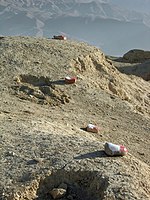
Afghanistan is a volatile and dangerous country. Non-essential travel is strongly discouraged . Banditry is somewhat of an ancient tradition in many parts of the country, including in the northern areas.
Landmines and other UXO (Unexploded Ordnance) remain a problem across the country, so plan to stick to well-worn paths, avoid red and white painted rocks, and do not touch or move any suspicious-looking item. Hundreds of people are injured or killed every year in accidents due to landmines and UXO.
Insects and snakes are also something to be careful of, and the mountainous country has many vicious tiny creatures such as scorpions, spiders, centipedes, and bees.
In some areas, altitude sickness is a significant risk.
Any homosexual activity is punishable by an assortment of harsh punishments, including death, under Afghan law. LGBT travelers should exercise tremendous discretion.
Since the Taliban takeover, it is illegal for women to show their faces in public; all women are required to wear the niqab or burqa when in public places. Traveling without a mahram is risky and possibly illegal.
Stay healthy [ edit ]
Afghanistan has more than its share of health issues, and it is pretty much essential to consult a travel doctor ahead of your trip about vaccinations and health risks. Travellers' diarrhea will afflict most visitors at least occasionally, and other food-related illnesses are moderately common. Respiratory diseases such as tuberculosis are common, and malaria is a risk in many parts of the country. Meningitis, hepatitis, cholera and rabies are major health issues, especially in the countryside with lacking health infrastructure.
Afghanistan is one of the dustiest countries in the world, and you should be prepared to be covered in it and breathing it for most of your stay, even in the major cities. Consider bringing facemasks. Pollution from diesel engines can also make life unpleasant.
Flies are notoriously heinous here, likely due to poor sanitation. Winter brings some relief, but they come back full-strength when spring arrives.
Food should be approached with a discerning eye, as hygiene standards can often be lacking. Hot, freshly cooked food is generally safer. Bottled water is also advised, unless you have your own purification system.
Do not approach any animals, especially dogs and cats and preferably take a rabies shot before going to the country, it's one of the most rabies-affected countries in the world and finding medical attention and medications will be hard – even with the shot you need to get urgent medical treatment if you get a scratch from an infected animal.
Bring any prescription medicine you may need from your home country, and don't count on being able to find it locally. You may also consider carrying pain relievers and anti-diarrheals , as they'll be hard to find outside of major cities.
Squat toilets are the norm, with toilet paper optional and sometimes scarce. Western-style toilets are seen occasionally in newer buildings and some private homes.
Respect [ edit ]
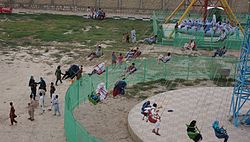
Afghans in general are welcoming and hospitable to foreign visitors. Hospitality is a cornerstone of Afghan culture, and it is very likely that you'll be treated as a celebrity by the locals.
With the regime change in 2021, a large proportion of the population, especially women, are very afraid of what will be in the future. Those who worked for the government, for foreign organisations, for human rights or for the media, or held any high profile positions may be afraid for their lives. Tread extremely lightly.
Basic etiquette [ edit ]
If invited to an Afghan home, expect to be offered the best of everything there is. You will often be showered with tea, sweets, snacks, and gifts when entering someone's home. Don't refuse any of these as it can leave a bad impression on your hosts. You'll often be encouraged by your hosts to take second helpings ad infinitum. If so, take it as a form of respect as it may leave a good impression on your hosts. Cleaning your plate will invite more to be served, while leaving too much may be a sign you didn't care for it. Aim for leaving just a little, announcing you're full, and heavily praising the food.
Honor and shame , otherwise known as "saving face" in other countries, are very important in Afghan culture. No matter how genuine your intentions may be, avoid criticising people in the open and do not make someone feel uncomfortable with your questioning. Be mindful that your actions will be reflected on your counterparts (e.g. Business partners, family members); doing anything perceived as "shameful" by Afghans will cause others to view them in a negative way. Be mindful of this and behave accordingly.
While the majority of women across Afghanistan still wear the burqa or chadori , in cities like Kabul and Herat many opt for the Middle Eastern-style hijab. Western women are highly encouraged to wear any type of head scarf (especially outside Kabul). As a general rule, the people get more conservative as you move further south.
The pace of life in Afghanistan is quite slow. Building relationships and getting things done require you to demonstrate sincere interest as Afghans try to do things in a measured, careful manner. Losing your temper is seen as disrespectful, and it can quickly make people feel uncomfortable.
As in any other Islamic country, people place a high value on personal privacy. Although Afghanistan may have wonderful photo opportunities, do not photograph or record people without their permission , especially women. Also, taking photographs of anything of strategic importance may be met with suspicion.
Be sensitive to the country's current situation . Many Afghans have endured a lot due to years of conflict and warfare. Offer sympathy and respect when the opportunity arises.
Religious etiquette [ edit ]
- Remember to remove your shoes when entering a religious building.
- Dress modestly and appropriately; not doing so is considered disrespectful.
- If at all possible, try not to schedule meetings during Ramadan. The workday is shortened, and since Muslims fast, they will not be able to offer you tea, which is a sign of hospitality. Meetings are also not scheduled during prayers. Also refer to travelling during Ramadan .
- Mosques are sometimes off-limits to non-Muslims so it is always better to inquire with someone before entering.
Things to avoid [ edit ]
Politics [ edit ].
- Do not discuss the Taliban — Some support them and others may not dare to criticize them. Any such discussion will put the local in a very awkward situation.
- Be careful when discussing Pakistan — The two countries have had a very hostile relationship, while people from the neighboring regions may have strong ties across the border.
- Be careful when discussing the foreign efforts during the former regime — Many Afghans feel that the US military did more harm than good, or betrayed Afghanistan by withdrawing. Any such discussions may also risk being interpreted as criticizing the Taliban regime, see above.
Personal subjects [ edit ]
- Family — Many Afghan people have either been separated from their families, have lost family members to conflict, or fear that they might be put into danger if they're spoken about. As a general rule, don't discuss someone's family unless you know the person well.
- Religion — Afghanistan has some very harsh blasphemy laws. You can very easily elicit strong responses by speaking negatively about religion, especially from an agnostic point of view. Also, don't assume that every Afghan is a hard-line Muslim; secular viewpoints are common. On the other hand, hijabs or burqas are traditional clothing in some regions. Someone's preferred style of dress might not reflect their private views.
Connect [ edit ]
Fixed line service is available in major cities (digital in Kabul ) and mobile phones in most cities. SIM cards are available and international calls to Europe/US typically cost less than USD0.5/minute. Outside of major cities your options are limited to a satellite phone.
An Afghanistan number should is of the form +93 30 539-0605 where "93" is the country code for Afghanistan, the next two digits are the area code and the remaining 7 digits are the "local" part of the subscriber number that can be called from within that particular area code using abbreviated dialing. You need to dial "0" in front of the geographic area code (of 20, 30, 40, 50 or 60 for fixed lines) from outside that particular area code (but when still within Afghanistan).
Mobile phones [ edit ]
Mobile numbers in Afghanistan must always be dialled with all digits (10 digits, including a "0" prefixing the "70n" within Afghanistan), no matter where they are being called from. The 70n is a mobile prefix, not an "area code", as such and the third digit (the n part) denotes the original mobile network assigned. An example mobile number looks like +93 700-202-496 .
- Roshan +93 79 997 1333 . The most reliable service with the widest coverage. SMS is possible to most countries. SIM cards cost USD5, local calls are Af 5/minute.
- Afghan Wireless Privately owned with 20% ownership by the government. AWCC has the only communications ring around the country offering high speed mobile and data services throughout all provinces. AWCC also offers the highest speed fibre-based connections to the outside world, with roaming to over 300 other operators in 120 countries. Services include Voice, FAX, GPRS and EDGE data services along with WiMAX and dedicated high speed internet service with 45MB links to NYC and 45MB links to Paris. SIM cards cost USD1, local calls are Af 4.99/minute billing in seconds.
- Areeba/MTN +93 77 222 2777 . The cheapest cell service, offers the least coverage. SIM cards cost USD3, local calls are Af 5.5/minute.
- Etisalat +93 78 688 8888 . A large network provider from the UAE, is the latest GSM network in Afghanistan. It became the first company to begin 3G services in early 2012.
Satellite phones [ edit ]
- Thuraya is the most reliable satellite phone system.
- Has custom banner
- Has warning box
- Has map markers
- Articles with dead external links
- Listing with Wikipedia link but not Wikidata link
- Has caution box
- Has caution box with out of date warning
- Has Geo parameter
- Central Asia
- All destination articles
- Outline countries
- Outline articles
- Country articles
- Pages with maps
Navigation menu
- Israel-Hamas War
- Science & Tech
- Ents & Arts
- Data & Forensics
'A remarkable development': How Western tourism is on the rise in this controversial nation
While travel companies paused their tours of the country as the taliban seized power in 2021, many of these are back up and running - and attracting western visitors despite government warnings..
By Rachel McGrath, news reporter
Wednesday 13 March 2024 15:58, UK
With centuries of history, ancient archaeological sites, Islamic art and untouched landscapes, Afghanistan is attracting tourists - despite the Taliban regime and the UK government's "do not travel" warnings.
In the 1960s and 1970s, the country formed part of the overland "hippy trail" route across Asia and welcomed hundreds of thousands of Western tourists. But as its complicated modern history unfolded, the steady stream of travellers stopped.
The UK Foreign Office currently advises against all travel to Afghanistan , highlighting its "volatile" security situation and an "ongoing and high threat of terrorist attacks". But some adventurous tourists aren't letting this stop them.
Joan Torres, founder of blog and adventure travel company Against The Compass, told Sky News that he has seen a "big increase in demand" for tours of Afghanistan. In 2023, he ran three trips to the country and for 2024, this number has doubled.
"Syria and Iraq used to be our big sellers but given the situation in the Middle East, Afghanistan might become our most sold-out destination soon," he said.
Untamed Borders, which specialises in trips to "some of the world's most interesting and inaccessible places", has also seen a rise in interest. It has been helping travellers visit Afghanistan since 2008.
The company's tours paused in August 2021 as the Taliban seized power and since resuming in September 2022, founder James Willcox told Sky News "quite a number of tourists" have made bookings.
More on Afghanistan
Johnny Mercer's deadline forcing him to name Afghanistan whistleblowing soldiers extended
St Athan: 'Brave' Afghans who helped UK are to be housed on Welsh military camp
Minister warned he faces prison if he does not reveal to Afghan inquiry names of officers who told him of murder allegations
Related Topics:
- Afghanistan
While Afghanistan's recent history is one of war and turmoil, Mr Willcox said people who book with his company aren't visiting because it's a "dangerous and edgy" destination.
"They want to experience somewhere that's culturally different, with different food and architecture," he said. "One of the things that appeals when you to go to Afghanistan, is you don't see life through the prism of tourism. There's something much more authentic about it."
Click to subscribe to the Sky News Daily wherever you get your podcasts
Read more: Eyewitness account - the Afghanistan earthquake last October Life as a woman under Taliban rule
Since the Taliban has been in control, the situation for Western tourists is that "generally we can visit places we couldn't visit before and the overall security situation has generally improved", Mr Willcox added.
His comment comes after a local official in Ghazni province - around 148km south of the capital Kabul - claimed "in a remarkable development" the region has "become a favoured destination for international tourists".
Since the beginning of the year, 293 visitors from various countries have explored the province's "natural attractions and ancient sites", added Mullah Hamidullah Nisar, the head of information and culture in Ghazni.
Attractions in the province include a fort complete with 1,000-year-old towers.
This is a limited version of the story so unfortunately this content is not available. Open the full version
While the Taliban regime has a well-documented history of oppressing women - and previously banned them from a national park saying "sightseeing is not a must for women" - Western female tourists are allowed to visit, and Untamed Borders runs mixed-gender tours.
"One thing that women [travellers] can often do is spend time with women in homes," Mr Willcox said. "But there are other things that women are not allowed to do and certain places they're not allowed to visit.
"On a good day as a female traveller, you get to see all the things the guys can see and on a bad day, you get ignored by everyone."
Getting into Afghanistan, and obtaining permission to do so, has never been straightforward. Under Taliban rule, just a handful of embassies around the world have been able to issue visas and at all but one, you can only apply in person.
Tourists also need specialist insurance as regular providers do not cover travel to countries on the Foreign Office's red list. They can then fly to Kabul via another hub in Asia, such as Dubai, or cross a border on foot.
For those who do jump through the necessary hoops and are willing to take the risk, unique sights, history and cultural experiences await.
"We take people to Bamiyan, which 1,500 years ago was the route between India and China," Mr Willcox said. "It was very cosmopolitan with very different ideas and religions. It was at the heart of Asian trade."
Tourists can also visit the famous minaret of Jam, the cities of Herat, Kabul and Mazar-e-Sharif, and the site where two gigantic sixth-century Buddhas stood until the Taliban destroyed them in 2001.
Top Things to Do in Afghanistan
Places to visit in afghanistan.
- 5.0 of 5 bubbles
- 4.0 of 5 bubbles & up
- 3.0 of 5 bubbles & up
- Budget-friendly
- Good for Big Groups
- Good for a Rainy Day
- Good for Adrenaline Seekers
- Good for Kids
- Hidden Gems
- Adventurous
- Good for Couples
- Honeymoon spot
- Things to do ranked using Tripadvisor data including reviews, ratings, photos, and popularity.
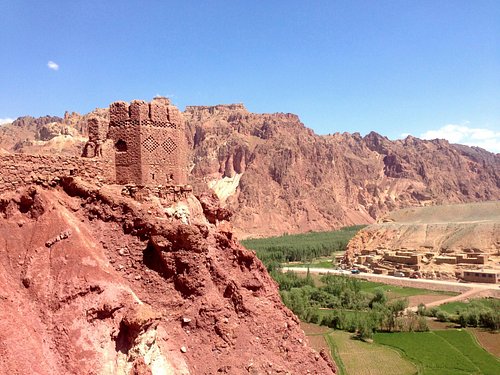
1. Cultural Landscape and Archaeological Remains of the Bamiyan Valley

2. Babur Tomb
3. Band-e-Amir National Park
4. Qargha Lake
5. Blue Mosque
6. Panjshir Mountains
7. Friday Mosque

8. Kabul Museum
9. Khwaja Abd Allah Ansari Shrine
10. Christian Cemetery
11. Darul Aman Palace
12. Herat Citadel

13. Bagh-e Babur

14. National Museum of Afghanistan
15. Gawhar Shad Madrasa and Mausoleum
16. Green Mosque
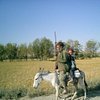
17. Shahr-e-Zahak (Red City)

18. Khawaja Ghaltan Shrine

19. Shah-e Doh Shamshira Mosque
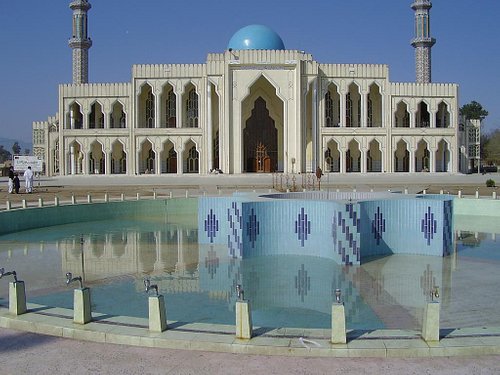
20. Khost Mosque
21. Jami's Tomb

22. Buddhas Of Bamiyan

23. Babur Gardens Mosque

24. Minaret and Archaeological Remains of Jam

25. Faizabad Chowk
26. Musalla Minarets of Herat

27. Red Mosque
28. Ziarat-e Sakhi

29. Pul-e Kheshti Mosque

30. Malan Bridge
What travellers are saying.

Afghanistan is open for tourism. What is it like to vacation under the Taliban?
The Taliban have opened the country to foreign travelers. Safety has improved and infrastructure is also being expanded. The question remains though whether one should actually go.
Emma Witters is walking along a street in Kabul, between kebab vendors and a sewer, when suddenly a pickup truck pulls up in front of her. The car waits until Witters has unlocked it. It's not actually a good sign when a pickup truck suddenly stops in Afghanistan's capital, because a Taliban fighter is usually behind the wheel. However, in this pickup truck there are young women waving excitedly from behind the car windows – they know Witters from YouTube.
Witters, 55, her long blond hair hidden under a headscarf, is probably the most famous tourist in Afghanistan at the moment. The Scottish national, who has already traveled to Afghanistan several times since the Taliban took power in the summer of 2021, makes videos of the country and posts them on YouTube.
Afghanistan was at war for more than 40 years. Since 2001, the Taliban had been fighting a battle against NATO troops in the country. On Aug. 15, 2021, the capital Kabul fell to Islamist rebels who now dominate the entire country. Poverty is omnipresent. Kalashnikovs and Taliban fighters as well. Why would anyone choose to vacation there?
Taliban fighters patrol the streets of Kabul. Since they came to power, security has improved, but not the human rights situation.
«I'm curious,» Witters says. «In countries that have been devastated by war, people are often very happy when tourists come.» Witters has already traveled to Iraq and Ukraine, and her videos provide mostly harmless glimpses of everyday life. In them, you can watch Witters walk through foreign countries with her camera, a bit awkward, but quite likable.
Tourist groups suddenly in Kabul
It would be an exaggeration to say that tourism in Afghanistan is booming. According to the Ministry of Tourism, there were 2,700 foreign tourists in the country last year. By August of this year, there had been 1,480. And yet, in Kabul, you can suddenly see tour groups in the streets. «I wouldn't advise every tourist to come here. You must be very experienced. I don't think everyone knows what they're in for,» Witters says.
There is a WhatsApp group for backpackers in Afghanistan. The conversation there sounds like chatting between any other group of backpackers: Where is the cheapest hotel in Kandahar? Is anyone also in Herat right now? Not everyone seems to realize what kind of country they are in.
Western countries still warn against traveling to Afghanistan. The Taliban issue a new rule almost every week. A few days ago they declared that women would no longer be allowed to visit the famous Band-e-Amir National Park. The sky-blue lakes in Bamian province are one of Afghanistan's tourist attractions.
Witters says she wants to do everything correctly, and not upset the Taliban. She has a tourist visa and a stamped travel permit for each province she visits. She even has an official sticker for her camera that identifies her as a YouTuber. Bureaucracy is rampant under the Taliban – the former fighters have to be kept busy somehow, and new ministries, agencies and rules are constantly being created. Navigating through them as a tourist isn’t easy, and anyone who breaks the rules must expect consequences.
In recent months, tourists have been repeatedly arrested in Afghanistan. Some were released after a few hours or days. Others have been held by the Taliban in secret locations for months, with no official charges and no contact with the outside world. The most prominent case is British YouTuber Miles Routledge, a 20-something who has made adventure videos in Afghanistan.
He's done target practice with Taliban, staged himself as a fearless adventurer and paid homage to misogynist Andrew Tate. In April, it was revealed that Routledge was in Taliban custody. Also missing since June is an Austrian, a known right-wing extremist over 80 years old. Both are believed to be in the custody of the GDI secret police, and both England and Austria are seeking their release.
A little normality, a little tourism
Why is Witters taking this risk? She thinks a bit before answering: «It's hard to explain. I just get this feeling when I look at the faces of the people here. People deserve a little normalcy, even if it's just tourism.»
Afghan teachers take photos on the shore of a lake in Band-e-Amir National Park. Women have recently been banned from visiting the lakes in Bamian province.
British national Joe Sheffer, who worked in the country for years as a cameraman, is planning to travel there with a tour group in October. He runs the Safarat travel agency, and has been bringing tourist groups to Afghanistan for a year. He is one of the few tour operators that brings group and private tours to Afghanistan.
Of course, he worries about the risk. «A worrying number of foreigners are currently detained in Kabul. If the government wants to promote tourism, it must explain why it detains people for months,» Sheffer says. The biggest danger in Afghanistan right now, though, is his guests having an accident or getting sick because medical care is difficult, he adds. «Afghanistan is not a country where you can just roam freely as a foreigner. It's still a risk. But we can handle the risk.»
His tours are booked by people who have always wanted to visit Afghanistan. The country has an almost mythical reputation – it was once part of the Silk Road, and later part of the hippie trail to India. Then war came to Afghanistan with the Soviet invasion in 1979. Some of Sheffer's guests are drawn to this mythical reputation. Others have followed the years of war on the news and now want to see the country for themselves.
A group that shouldn't be underestimated are those travelers who simply want to have visited every country in the world once, and now sense their chance. Mostly they don’t know much about Afghanistan. «We have preliminary discussions with our guests and explain to them what to expect. For example, that there can be problems if they photograph women,» Sheffer says.
Afghan women wait for bread outside a bakery in Kabul. Today, the majority of the population lives in poverty, and women in particular suffer hardship.
Like Sheffer, Polish journalist Jagoda Grondecka reported from Afghanistan until a few months ago. Now a Polish adventure travel agency has hired her as a guide. Last year, Grondecka led a group through the country twice – going to Kabul, Kandahar in the south, Balkh in the north and Bamian in the west.
«It's surprisingly easy to travel. The security situation in the country has improved,» says Grondecka. The war is over. The Taliban have won, and they no longer lay ambushes on country roads. Their improvised bombs have disappeared. «The infrastructure in the country is also improving,» she says, «For example, the government has repaired the highway from Kabul to Kandahar.»
In Kabul, too, roads have been partially resurfaced. Traffic circles are now decorated with fountains and abstract sculptures made of marble. Kabul is sprucing itself up – though not necessarily for the tourists. The concept of tourism is still foreign to most Taliban. «It's difficult to make Taliban foot soldiers understand what tourism is. There has been some miscommunication,» Grondecka says.
Small misunderstandings can quickly turn into big ones in Afghanistan – for example when a soldier can't read an authorization, or when a commander is having a bad day. When this happens, a tourist can quickly be mistaken for a spy.
The tourism official in Kabul is Hayatullah Muhajir Farahi, who is a deputy minister. «Tourism is important for Afghanistan, because the world has a bad image of Afghanistan, from the war or from the propaganda of the Americans,» he says. Farahi believes tourists will carry a positive image of Afghanistan to the world. They will tell people back home how friendly the Taliban fighters on the streets were, and how good the security was, he says.
Perhaps this might also attract foreign investors. Afghanistan's government is still not recognized by any country. Apart from a few Chinese fortune hunters, there are hardly any foreign companies in the country. Farahi says the government will soon build more hotels, and better hotels, to offer tourists something as well.
Should one go to Afghanistan?
However, the question that most tourists and tour operators in Afghanistan are asking themselves still remains. While it is possible to vacation to Afghanistan today – should you?
Traders sell fish on the side of the road from Jalalabad to Kabul. The roads are safer today than in the past, but tourists should still not travel alone.
Witters repeatedly receives indignant comments on YouTube because her videos portray an Afghan normality and largely leave out the Taliban's repressive regime. Witters says, «I don't talk about political stuff, ever. I am completely neutral and focus on the people here and their country. But I'm not praising the Taliban either.» She knows about the situation for women, and says it breaks her heart. What should she do though, she asks. «I'm not a journalist, I'm a tourist.»
«I think it depends on how consciously you travel to Afghanistan,» Grondecka says. By «conscious,» she means knowing what the realities are in the country.
It is easy to paint a superficially positive picture of Afghanistan at the moment. The infrastructure is improving and the country is relatively safe. But the reality in the private sphere, in families, often looks bleak, especially for women.
«I always ask myself, are we making things better or worse by coming here? We don't advertise for the regime. But we give Afghans the opportunity to make an income through our tours,» Sheffer says. Furthermore, many young Taliban have hardly ever seen foreigners who weren't soldiers, he says. When they come into contact with tourists, they suddenly open up, he adds. One goal of Sheffer's travels, he says: «I want Afghans and foreigners to talk to each other.»
Latest articles
Republic of crazy: lies and conspiracy theories have always been a part of us politics, opinion • western whining about china's «overcapacity» is hypocritical and short-sighted, the eu’s deal to stop migration through niger failed. a people smuggler explains why, american companies are paying millions for experienced ai experts.
NZZ International Edition – Switzerland's most trusted news brand The Neue Zürcher Zeitung (or NZZ for short) is one of the preeminent news sources in the German-speaking world, with a tradition of independent, high-quality journalism reaching back over 240 years. With its curated selection of English-language articles on Swiss and international news, politics, business, technology and society, the NZZ International Edition provides readers with a fresh and independent perspective. Learn more about the project here . To stay up to date with our award-winning reporting, sign up for our free newsletter or follow us on Twitter or Facebook .
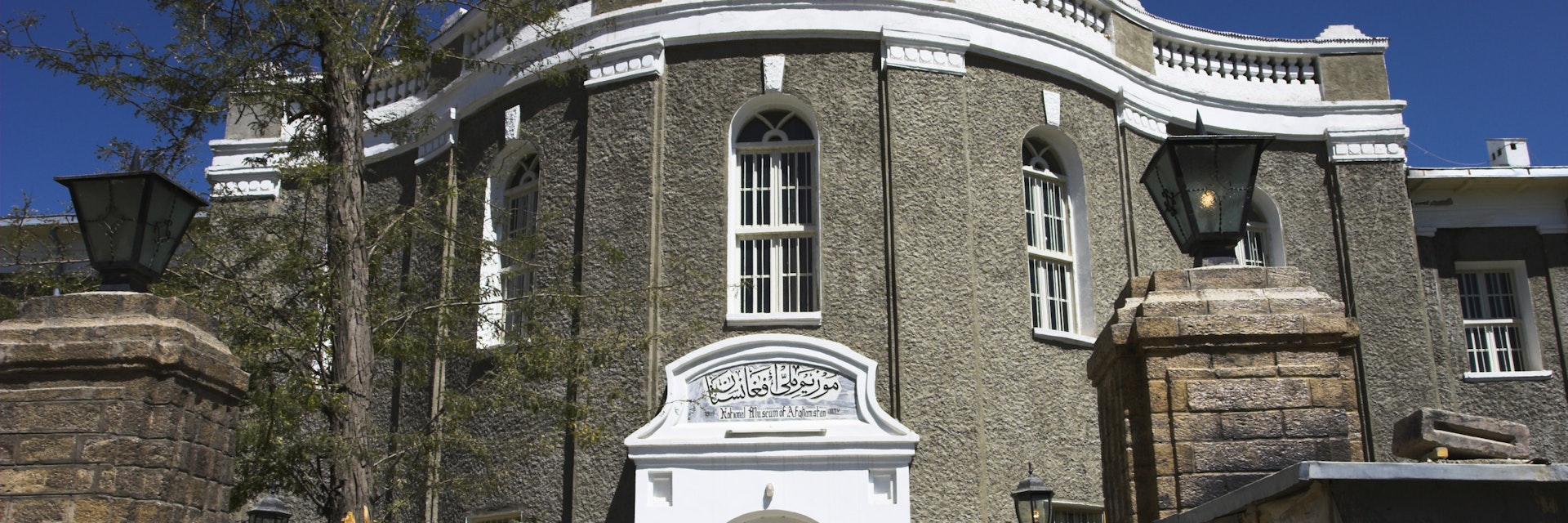
Getty Images/AWL Images RM
Kabul has come a long way since the Taliban's 2001 ouster. Once a stop on the old hippy trail to India, then ruined by the civil war, the city has boomed in recent years, with endless new buildings being thrown up, fancy restaurants, busy bazaars and an air thick with the sound of mobile phones. But scratch the surface and things aren't always so rosy – the infrastructure creaks, electricity and clean water remain an aspiration for too many, and the background thrum of security alerts and road barriers remind you that Kabul's path to reconstruction continues to be rocky. As an introduction to Afghanistan it's exciting, frustrating, inspiring and shocking in equal measure.
Your next trip starts here
Go from dreaming to planning with trip planning options made to help you craft your ideal itinerary.
Attractions
Must-see attractions.
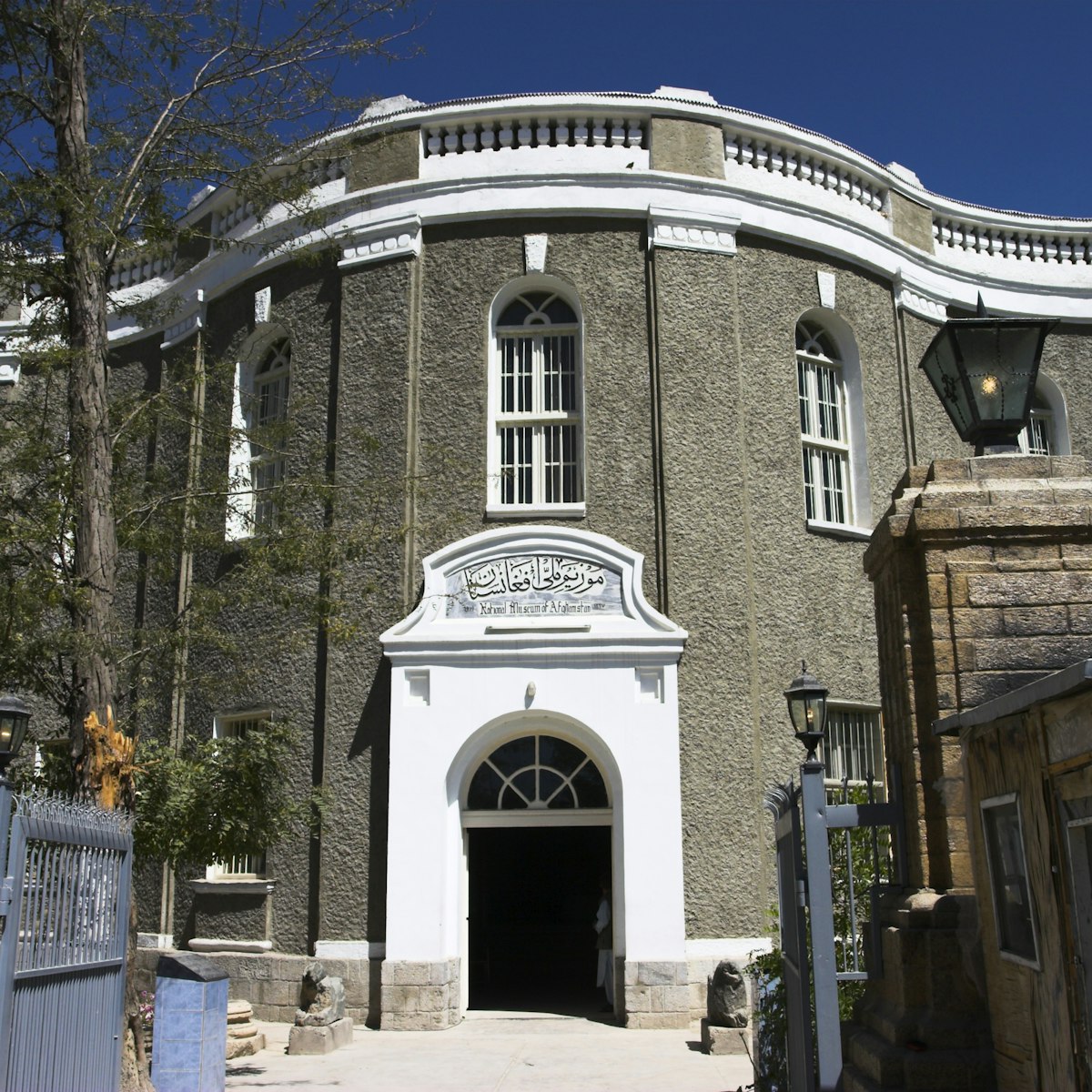
Kabul Museum
The Kabul Museum was once one of the greatest museums in the world. Its exhibits, ranging from Hellenistic gold coins to Buddhist statuary and Islamic…
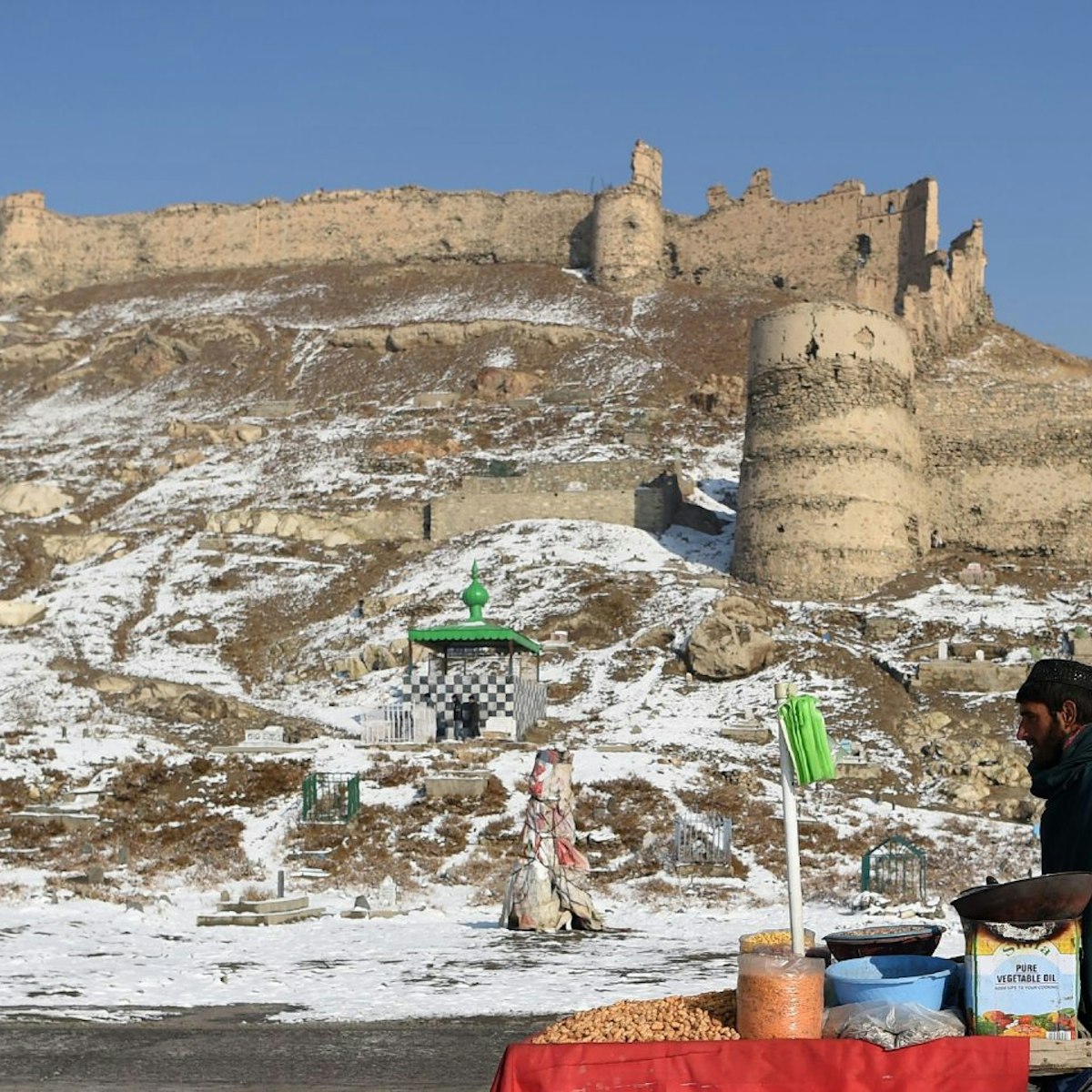
Bala Hissar & City Walls
The old seat of royal power, a fortress has stood on the site of the Bala Hissar since the 5th century AD, and quite possibly before. It sits at the foot…

Babur's Gardens
Laid out by the Mughal ruler Babur in the early 16th century, and the site of his tomb, these gardens are the loveliest spot in Kabul. At 11 hectares,…
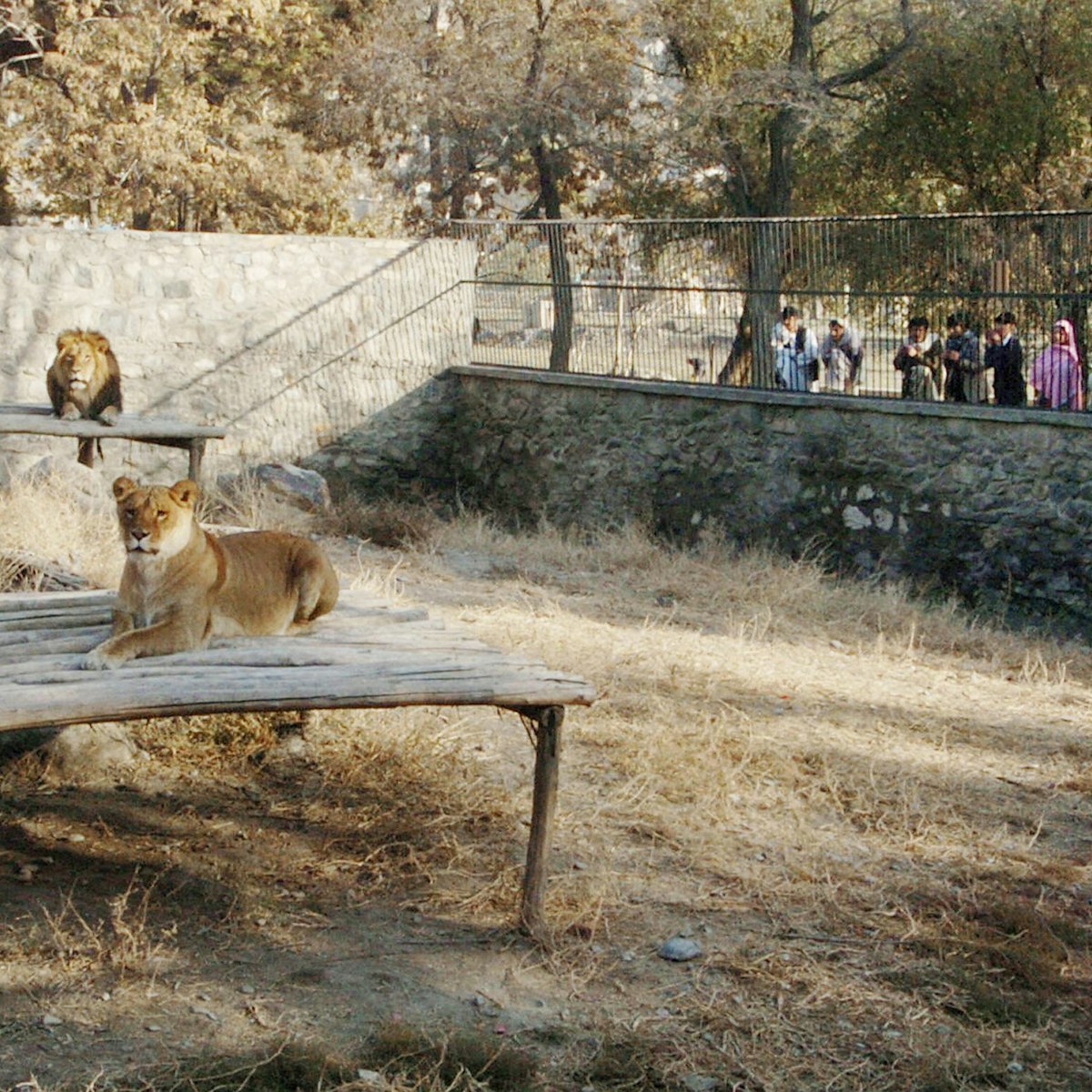
The zoo is a popular place for Kabulis in need of recreation. Western animal lovers might find it more than a little depressing. Visitors are greeted…

Sultani Museum
This private museum in the same grounds as the National Gallery is something of a curiosity. It was set up in 2004 by Ahmad Shah Sultani, a gold trader…

Omar Land Mine Museum
This is a museum that only a country like Afghanistan could host. Run by the Organisation for Mine clearance and Afghan Rehabilitation (OMAR), it acts as…

Mausoleum of Nadir Shah
King Nadir Shah was assassinated in 1933, the time-honoured way that most Afghan leaders meet their fate. His monumental tomb sits overlooking east Kabul…

European Cemetery
This cemetery was built in 1879 by the British army for the dead of the Second Anglo-Afghan War. The cemetery contains around 150 graves. Most are from…
in partnership with getyourguide
Book popular activities in Kabul
Purchase our award-winning guidebooks.
Get to the heart of Kabul with one of our in-depth, award-winning guidebooks, covering maps, itineraries, and expert guidance.
Plan Your Trip to Afghanistan: Best of Afghanistan Tourism

Essential Afghanistan

Trending in the forums

New Security Beat
- Environment
- Development
- China Environment Forum
- Choke Point
- Navigating the Poles
- New Security Broadcast
- Reading Radar
- Water Stories (Podcast Series)
- Backdraft (Podcast Series)
- Tracking the Energy Titans (Interactive)
- Water, Conflict, and Peacebuilding (Animated Short)
- Paving the Way (Ethiopia)
- Broken Landscape (India)
- Scaling the Mountain (Nepal)
- Healthy People, Healthy Environment (Tanzania)
- Publications
NewSecurityBeat
Guest contributor, a land like no other: afghanistan’s post-conflict ecotourism potential.

Stunning cobalt-blue lakes with natural travertine dams in Band-e-Amir, the pristine, soaring Pamir Mountains, through which some of the world’s last snow leopards prowl—far from the simplistic, violent, and drab images preferred by the media, Afghanistan is a beautiful and multifaceted nation. Lonely Planet once described Afghanistan as a “ vastly appealing country .” Having married into an Afghan family many years ago, I can attest that the culture is also extremely hospitable. Welcoming tourists to visit their beautiful nation is a logical extension of the Afghan culture.
With such a rich and hospitable culture and unparalleled natural beauty, the post-conflict development of a responsible and sustainable tourism sector could benefit Afghanistan—especially in more remote areas. Before the wars and COVID-19, in the 1970’s, over 100,000 tourists per year visited Afghanistan . But there is hope for an end to the pandemic, and as of March, COVAX vaccines began to be administered. There is also some hope for a successful peace process.
Afghanistan, Tourism, and Armed Conflict
I must highlight at the outset of this article that the situation in Afghanistan remains extremely dangerous and in-flux, with the security outlook for the future unclear. The United States and multiple other governments warn against present travel there due to widespread violence, kidnappings, and suicide bombings. As of this writing, the peace process is floundering, and most of Afghanistan remains an extremely dangerous place to venture to.
However, while a nation-wide, durable peace is hoped for in the future, there are more stable areas of Afghanistan. Bamiyan Province and the Wakhan Corridor were seeing tourists return, before the COVID-19 pandemic hit. Curiosity about this nation, with its extraordinary natural beauty and rare wildlife, is prompting eco- and adventure-tourists and those interested in the history and culture of Afghanistan to travel there, despite the dangers and warnings against going.
One might balk at the notion of a non-essential visit to Afghanistan since violence and bombings are a daily occurrence in the capital of Kabul. Yet, Bamiyan Province, in the Central Highlands, or the extremely remote Wakhan Corridor, which reaches out to touch the Chinese border—both unique in terms of their nature—are more peaceful areas of Afghanistan. Tourism programs must be developed with careful planning to benefit the people of Afghanistan who have suffered greatly over the past four decades of near-continuous armed conflict.
Sustaining Local People’s Well-being
The United Nations designated 2017 as the International Year of Sustainable Tourism for Development, in part to educate people on how tourism can play a positive role in development . Sustainable Tourism is defined by the UN as “tourism to support economies without disrupting local cultures and the ecological foundation that the industry and/or activities are founded on.” “Adventure travelers” seek to combine travel with sport or rigorous physical activity, such as mountain climbing or unique experiences in nature. Ecotourism is “responsible travel to natural areas that conserves the environment, sustains the well-being of the local people , and involves interpretation and education.” Sustaining local people’s well-being is critically important, but has not always happened. Tourists can and should help Afghanistan’s economy grow—not cause more problems for the nation.
There is no doubt that tourism can bring in hard currency and livelihoods to regions that have few other options. According to the World Trade Organization, 10 percent of world’s GDP is from travel and tourism. If not implemented with care, however, tourism can exploit local communities, trample natural areas, and have unintended negative consequences such as making wildlife more dependent on humans. If done responsibly, tourism can play a vital role for the local community. It can provide desperately needed jobs in remote areas, preserve cultural heritage, create cultural exchange, and help raise funds for conservation efforts .
Beautiful Bamiyan
While researching this article, I was surprised to learn that Bamiyan, Afghanistan is currently welcoming visitors from nations without COVID-19 travel restrictions. The city’s giant Buddhas, destroyed by the Taliban in 2001, have come back to life as 3-D holographic light projections . Bamiyan also has important archaeological sites , such as caves holding some of the world’s first oil paintings dating back 14 centuries, and a fledgling ski industry.
Bamiyan has a unique and progressive history including Afghanistan’s first female provincial governor , Dr. Habiba Sarabi. A friend of mine who is from Bamiyan, named Sattar, asked me to stress how “open-minded, hospitable, and friendly the people of Bamiyan are towards national/international tourists and visitors.” The people of Bamiyan are also a different tribe from the Taliban who are not welcome in the Province.
This stability made Bamiyan attractive to potential tourists before the pandemic. Gul Hussain Baizada, a Tourism Consultant & Tour-Guide for Silk Road Afghanistan Travel in Bamiyan, told me that he is optimistic that Bamiyan can restart its tourism sector fully once the tourists are able to safely return. “We hope one day Bamiyan will become a main tourism destination,” Gul told me in an email, noting the potential for the region. He also wrote that the tourism sector needs government support, tourism infrastructure, and more investment from the private sector to ensure the industry is sustainable. Better access to Bamiyan by air is also critical, as accessing the city by road from Kabul is extremely dangerous.
The Wild Wakhan Corridor
One of the last truly remote and pristine locations on earth, the Wakhan Corridor is home to the 4,200 square miles of Wakhan National Park. The park has rare and varied wildlife . Ecotourism would support the local communities, who are closely involved in the park’s management.
The Wakhan is so remote that it has remained relatively insulated from the conflict. The remoteness also makes it a stunningly beautiful region, attractive for any hearty adventure traveler or wildlife enthusiast.
Adventure traveler Matthew Karsten told me about his journey to the Wakhan Corridor, saying “I believe there is great potential for future ecotourism in Afghanistan . It’s a beautiful country and could certainly benefit from sustainable tourism business models while providing a very memorable experience for visitors. After traveling to many different countries over the years, it has remained one of my favorites!”
Post-Conflict Tourism, Peacebuilding, and Afghanistan
The development of tourism sectors following armed conflicts can support peacebuilding and environmental conservation by providing livelihoods, if carefully planned with the well-being of the community and environment in mind. For example, birdwatching tours have provided much needed livelihoods in post-conflict Colombia following the 2016 peace agreements—this example could provide lessons learned for Afghan tourism companies as they grow. I hope to be amongst the first tourists to visit Bamiyan once Afghanistan is post-COVID-19 and post-conflict!
Elizabeth B. Hessami , J.D., LL.M., is a Faculty Lecturer of International Environmental Policy for the Johns Hopkins University. She is also a Visiting Attorney for the Environmental Law Institute researching post-conflict natural resources management with a focus on Afghanistan.
Sources: ABC News, City News 1130, Daily Mail, Defense Visual Information Distribution Service, Expert Vagabond, International Ecotourism Society, Let’s Be Friends Afghanistan, Michigan State University, One Green Planet, Pamir Times, Relief Web, Sula Travel Agency, Travel Agent Central, U.S. Department of State, Washington Post, and the World Tourism Organization.
Photo Credit: The Hindu Kush Mountains, used with permission courtesy of Matthew Karsten , Adventure Travel Blogger & Photographer.
Join the Conversation
Trending stories, featured media, related stories.

- Wilson Center
- Print Friendly Page
© Copyright 2007-2024. Environmental Change and Security Program.
Woodrow Wilson International Center for Scholars. All rights reserved.
Developed by Vico Rock Media
Environmental Change and Security Program
Woodrow Wilson International Center for Scholars
Ronald Reagan Building and International Trade Center
- One Woodrow Wilson Plaza
- 1300 Pennsylvania Ave., NW
- Washington, DC 20004-3027
T 202-691-4000
Afghanistan and Tourism
- Living reference work entry
- Later version available View entry history
- First Online: 03 March 2022
- Cite this living reference work entry

- Amir H. Moghaddam 3
16 Accesses
This is a preview of subscription content, log in via an institution to check access.
Access this chapter
Institutional subscriptions
Ashley, L., and C. Dear. 2011. Ski Afghanistan: A backcountry guide to Bamyan and band-e-Amir . Afghanistan: Aga Khan Foundation.
Google Scholar
Azimi, M. 2012. Ecotourism in Afghanistan (in Farsi) . Kabul: Seraj and Sobhe Omid.
Euromonitor. 2012. Travel and tourism in Afghanistan . www.euromonitor.com/travel-and-tourism-in-afghanistan/report . 28 Nov 2014.
The World Bank. 2021. GDP Afghanistan, accessed at December 31 2021. https://data.worldbank.org/indicator/NY.GDP.MKTP.CD?locations=AF
UN. 2013. World economic situation and prospects . New York: United Nations.
Download references
Author information
Authors and affiliations.
Freelance Researcher, Isfahan, Iran
Amir H. Moghaddam
You can also search for this author in PubMed Google Scholar
Editor information
Editors and affiliations.
School of Hospitality Leadership, University of Wisconsin-Stout, Menomonie, WI, USA
Jafar Jafari
School of Hotel and Tourism Management, The Hong Kong Polytechnic University, Hong Kong, Hong Kong
Honggen Xiao
Section Editor information
University of the Sunshine Coast, Queensland, Australia
Rights and permissions
Reprints and permissions
Copyright information
© 2022 Springer Nature Switzerland AG
About this entry
Cite this entry.
Moghaddam, A.H. (2022). Afghanistan and Tourism. In: Jafari, J., Xiao, H. (eds) Encyclopedia of Tourism. Springer, Cham. https://doi.org/10.1007/978-3-319-01669-6_542-3
Download citation
DOI : https://doi.org/10.1007/978-3-319-01669-6_542-3
Received : 02 March 2021
Accepted : 08 July 2021
Published : 03 March 2022
Publisher Name : Springer, Cham
Print ISBN : 978-3-319-01669-6
Online ISBN : 978-3-319-01669-6
eBook Packages : Springer Reference Business and Management Reference Module Humanities and Social Sciences Reference Module Business, Economics and Social Sciences
- Publish with us
Policies and ethics
Chapter history
DOI: https://doi.org/10.1007/978-3-319-01669-6_542-4
DOI: https://doi.org/10.1007/978-3-319-01669-6_542-3
DOI: https://doi.org/10.1007/978-3-319-01669-6_542-2
DOI: https://doi.org/10.1007/978-3-319-01669-6_542-1
- Find a journal
- Track your research
Afghanistan Tours
Join one of our tours in afghanistan.
Afghanistan has been going non-stop through different historical episodes and moments since 1979, when tribal people rebelled against the Communist party, originating into a war between the Soviet Union and the Mujahideen, which lasted until 1989.
The Soviets were defeated but then, Mujahideen war lords began to fight each other over power, impoverishing the country even more.
Fed up with all that warlordism and disappointed that Islamic law had not been installed after the communists were kicked out, a former Mujahideen founded a movement named Taliban in the city of Kandahar. That man was Mullah Omar, the historical leader of the Taliban.
The Taliban quickly took over the whole Kandahar province and, by 1996, they controlled 90% of Afghanistan’s territory, including Kabul, ruling until 2001.
Then, the American Invasion came, beginning a useless war that took the life of thousands of people.
In 2021, the Americans withdrew and the Taliban took over again, and that’s the episode you’ll be witnessing in this expedition.
Afghanistan, however, is more than Taliban and war, but this Central Asian and former Silk Road country is a melting point of cultures and civilisations, visible in the extreme ethnic diversity, but also a jaw-dropping destination filled with mind-blowing shrines, historical bazaars, kind-hearted people and some of the most incredibly mesmerising landscapes ever, once traveled by Alexander the Great.
This is one of the most incredible countries in the world, and this is your chance to explore it.
what travelers say about us

need to know for your Afghanistan travel tour
How to get a visa.
The easiest place where to get an Afghan visa is at either the Embassy of Dubai, Islamabad and Doha.
Is it safe?
Before the Taliban took over the country in the summer of 2021, the country was going through a civil war. Now that the Americans left and the Afghan Army isn’t fighting the Taliban anymore, the country is finally safe, from a tourist perspective.
Which nationalities can join our Afghanistan tours?
All nationalities are welcome, including Americans.
Our scheduled group tours for Afghanistan
From Kabul to Bamyan, Minaret of Jam, Mazar, Kandahar, and the Wakhan Corridor, our Afghanistan tours cover pretty much the entire country.
Typically, we have 10-day tours to Afghanistan composed of 11 people, always led by a tour leader, either myself (Joan Torres) or someone from my team, besides an Afghan tour guide.
Upcoming Afghanistan Tours
These are all our upcoming tours in Afghanistan

Afghanistan with Herat & Kandahar
Join us in Afghanistan this spring to discover the lush green areas of Bamyan, Kabul, Herat and orthodox area of Kandahar
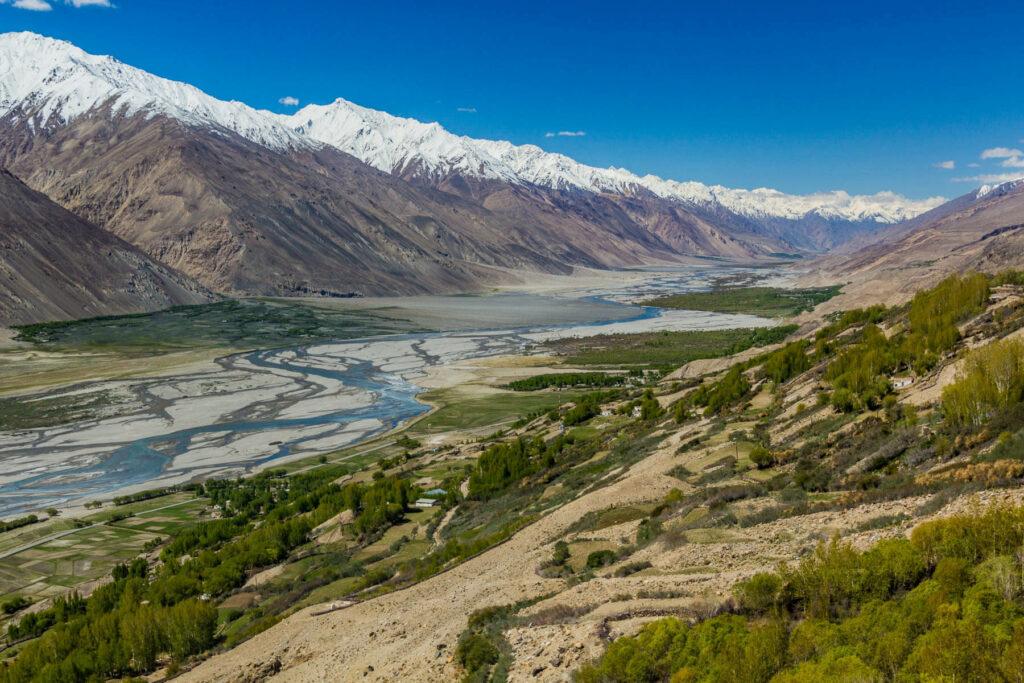
Wakhan Corridor in Afghanistan
The ultimate summer adventure into one of the most isolated and fascinating regions in Central Asia
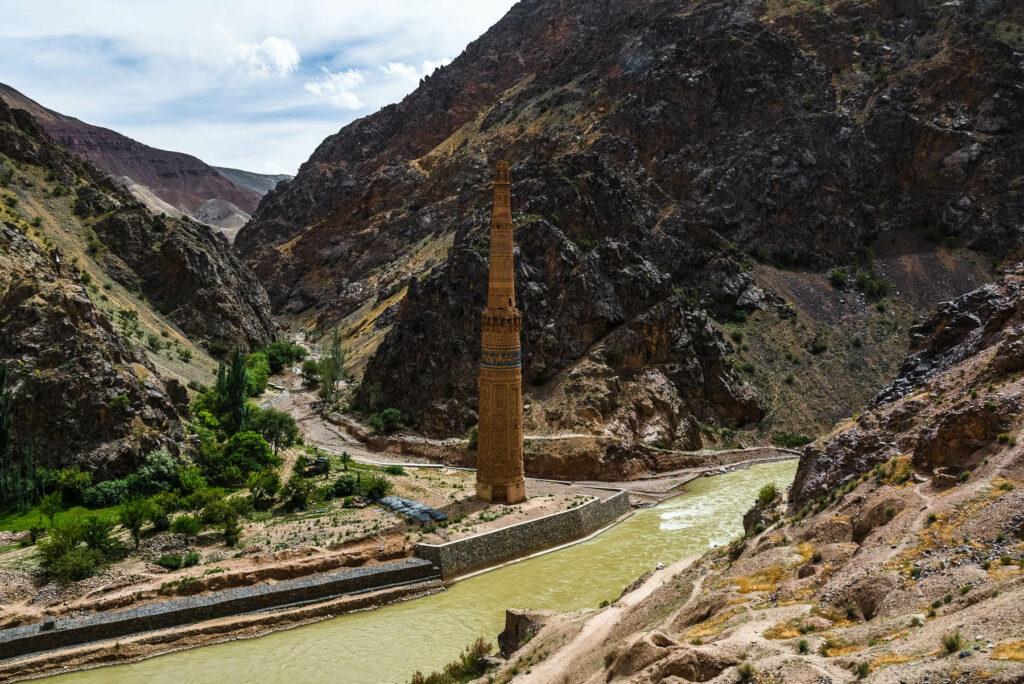
Afghanistan with Minaret of Jam
Join us in Afghanistan on an epic overlanding adventure to the Minaret of Jam!
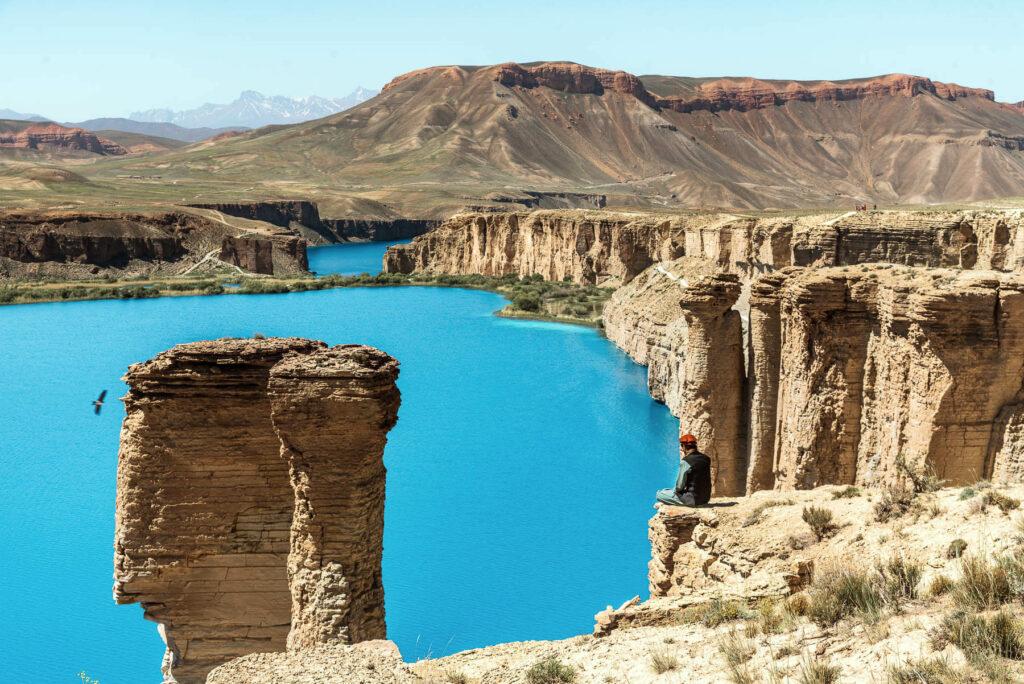
Afghanistan Expedition (in Spanish)
Our classic Afghanistan Expedition but for Spanish-speaking travelers!
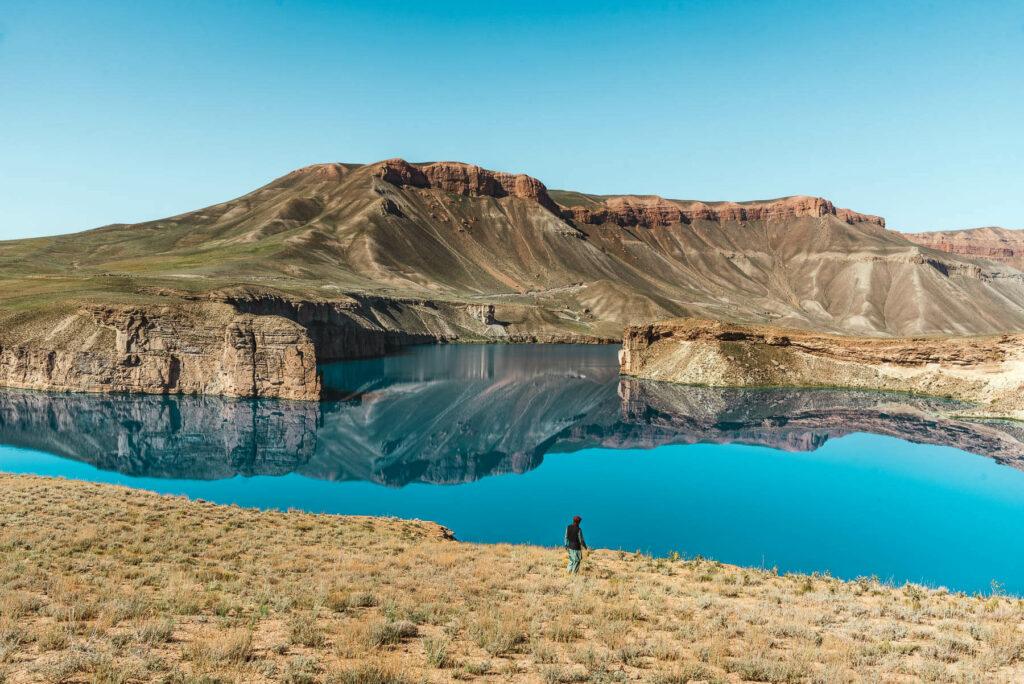
Afghanistan in October
Join us in Afghanistan during one of the best months of the year to travel there
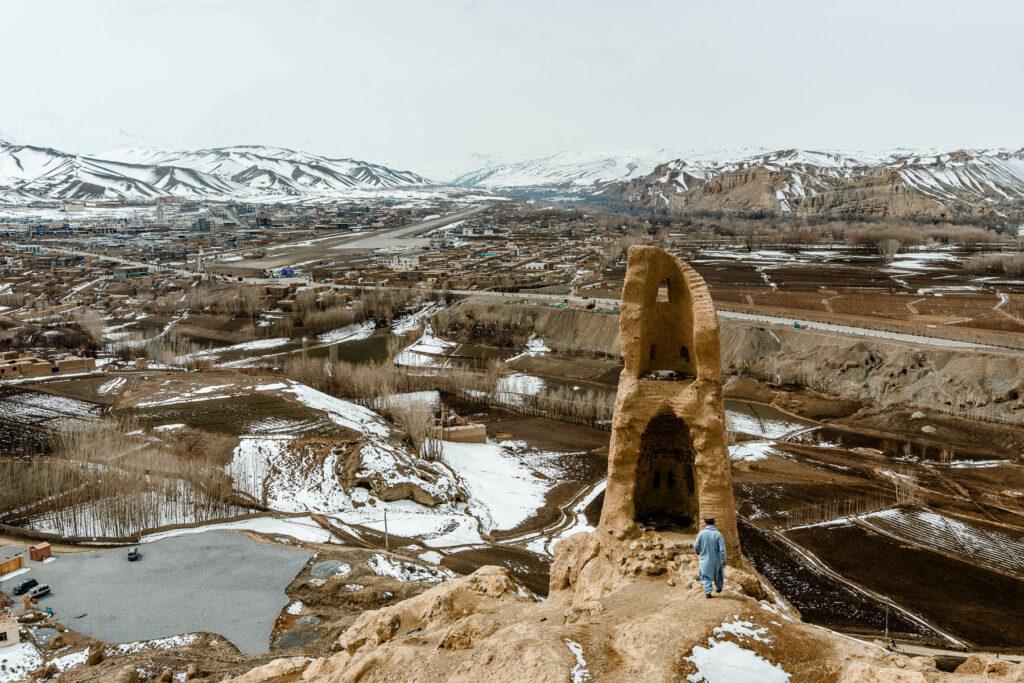
Afghanistan in winter
All our afghanistan group tours include.
Domestic flights
Accommodation
Permits and security clearance for driving around Taliban-Afghanistan
Private transportation around Afghanistan
Letter of Invitation needed for the visa
English-speaking Afghan guide
European tour leader
Entrance fees to all places listed in the itinerary
Visa advice and support
Private, tailored trips for Afghanistan
Do you want to travel solo, or with a group of friends?
From short trips in Kabul to compelling multi-day itineraries, we are able to design any sort of adventure based on your needs, 365 days a year.
If you can’t afford a private, solo trip, we can also help you find other partners to travel with.
Tell us your dates
When do you want to travel to Afghanistan
Which places do you want to visit
We will design the perfect itinerary based on your needs
Where do you want to start from
Kabul International Airport or overlanding from Pakistan?
Sample itinerary for our Afghanistan vacations tours
Here’s our standard 10-day tour we offer on most of our expeditions.
Day 1 – Arrival in Kabul
- Day 1 is the arrival day, a day which we will spend picking you up from airport and checking in the hotel, as well as giving you a warm welcome through an introductory briefing on Afghanistan.
- In the evening, we will go all together for a traditional Afghan meal.
- Overnight in Kabul.
Day 2 – Full day in Kabul
- Early morning and before our visit, we should go to the market to buy some local clothes, something which is strictly necessary to blend in (to a certain extent) with the local population.
- Then, we will head to Old Kabul, walking slowly through all the different bazaars, including the worldwide famous bird market , a photogenic bazaar where they sell different types of birds as pets, one of the top tourist attractions in Kabul.
- After a hearty meal, we will travel west of Kabul to spend the afternoon and evening in Sakhi Shrine, a mini version of the Blue Mosque in Mazar and also one of the most stunning mosques in all Afghanistan.
Day 3 – Mazar-e-Shariff
- At 11:30am, we will catch a flight to Mazar e-Sheriff, a northern city close to the Uzbekistan border, the reason why here you find a large population of Uzbeks.
- From the airport, we will drive straight to Balkh, an ancient city once the centre of Buddhism, Sufism and Zoroastrianism. Among other landmarks, we will visit Bala Hisar – the ancient citadel built by Alexander the Great when he destroyed the Kurush (Persian empire) – and Parsa Mosque.
- Then, we will head back to Mazar to spend the entire afternoon in the Blue Mosque, one of the highlights in all Afghanistan, a huge shrine composed of mind-blowing turquoise patterns that comes to life with the thousands of worshippers that visit it every single day. It’s a place not to rush, so we will take our time there.
- Overnight in Mazar-e-Shariff
Day 4 – Bamyan
- This is an exciting day, for two different reasons.
- On the one hand, few are the travelers who have done this journey by road, since the area between both destinations used to be extremely dangerous before the Taliban took over, but not anymore.
- On the other hand, we will drive through the Hindu Kush range, witnessing amazing landscapes and passing through 5 different provinces: Bamyan, Parwan, Bghlan, Samangan and Balkh.
- We will arrive in Bamyan in the evening. Overnight in Bamyan.
Day 5 – Exploring the city of Bamyan
- Bamyan is a Hazara town and the only sort of tourist-friendly place in all Afghanistan. It’s located at the heart of the Hindu Kush, in a stunningly beautiful area surrounded by mountains and lush, green fields, but also a region with rich in ancient history.
- Early morning, we will pay a visit to the giant Buddhas that were carved from the rocks back in the 6th century, but unfortunately destroyed by the Taliban in 2001. The big Buddha-shaped holes they left behind are impressive though, and the views from the top even more.
- Right after eating a traditional regional meal, we will head to historical Shahr-e Gholghola also (City of Screams), a 13th century city in Bamyan, that was conquered by Gengis Khan after months of surrounding.
- The evening will be spent on top of a mountain with awesome views of the mountains. Overnight in Bamyan.
Day 6 – Band-e-Ameer National Park
- Band-e-Ameer is a UNESCO World Heritage and also the only National Park in all Afghanistan, a set of deep-blue lakes absolutely jaw-dropping.
- The best way to get an impression of its size is by circling the lakes on foot, so we will do a small trek, while choosing the best spot for a picnic lunch.
- After enjoying the lakes, we will drive back to Bamyan, not without enjoying the landscapes this region can bless us with on the way. Overnight in Bamyan.
Day 7 – Bamyan to Ghazni
- The drive to Ghazni from Bamyan will go through an actual off the beaten path region in Afghanistan, passing by isolated villages in the middle of the desert.
- The drive will take 4 hours.
- Upon arrival in Ghazni, we will have lunch, and then we will visit the Ghaznavid minarets, two masterpieces of Islamic engineering from the 12th century.
- Overnight in Ghazni.
Day 8 – Drive to Kandahar
- The driver to Kandahar is pretty long – around 6 hours – but it goes through the former battle zone of the USA against the Taliban, so expect to see a lot of abandoned American tanks and military trucks.
- We expect to arrive in Kandahar around lunch time and visiting some of its highlights will follow after that.
Day 9 – Kandahar
- Kandahar is the cultural center for the Pashtun people.
- Long-bearded-men and women in burqa , but also dust, utterly hot summers, and an insane level of military security.
- Kandahar is like the Afghanistan we have been watching on TV, but it’s also rich in history, since it was actually founded by Alexander the Great himself in the 4th century BC.
- The city, however, is also infamous for being the place where the Taliban movement was founded, and the actual Taliban capital when they ruled the country from 1996 to 2001.
- We will visit the remains from the city founded by Alexander the Great but our visit will also have a big focus on the Taliban history, and that will include the mosque where Mullah Omar and Osama Bin Laden used to pray, as well as a Taliban school.
- In the evening, we will catch a flight back to Kabul.
Day 10 – Kabul and departure
- Your flight will likely be in the afternoon so early in the morning, we will go to the Bibi Mahro Hills to enjoy the best views in the city.
- After that, we will take you the airport to catch your international flight.
Join a tour in Afghanistan: FAQ
How to fly to kabul.
There are daily flights from Dubai and Islamabad with Fly Dubai and Kam Air.
Is Afghanistan safe nowadays?
Before the Taliban took over the country in the summer of 2021, the country was going through a civil war. Now that the American left and the Afghan Army isn’t fighting the Taliban anymore, the country is finally safe, from a tourist perspective.
What about Americans?
Yes, despite the American intervention, the country is as safe for Americans as it is for other nationalities.
Can women join an Afghanistan expedition?
Yes, women can join this expedition, no problem.
While the local Afghan women do suffer from a huge repression and lack rights, foreign women will always be safe, especially if you go accompanied by our team.
Regarding clothing, you don’t need to wear a burqa but just a regular hijab and an abaya, like you’d do in Iran.
Your message
Get In Touch
Request more info or book a tour.
Fill in the form and we'll get back to you in no time!
The Media Line Stands Out
Fighting The War of Words
As a teaching news agency , it's about facts first, stories with context, always sourced, fair, inclusive of all narratives.
We don't advocate!
Our stories don’t opinionate.
Just journalism done right. Wishing those celebrating a Happy Passover.

- Personalize
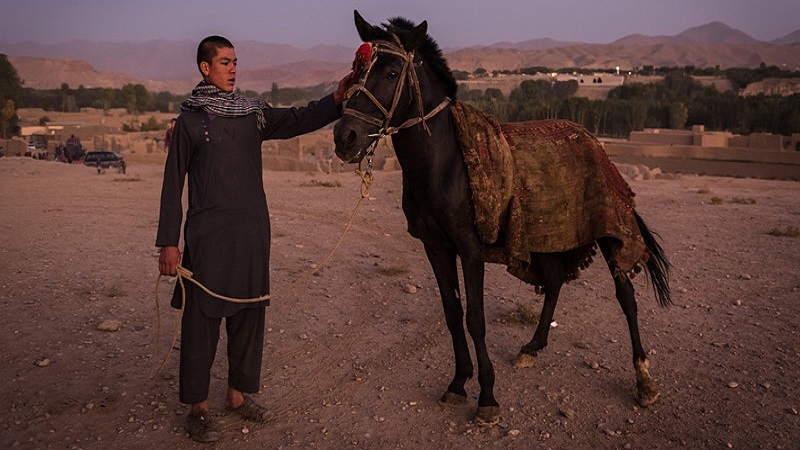
Tourism in Afghanistan? Challenges and Opportunities
Date and time: Thursday, October 15, 2020, 6 to 7 pm British Summer Time (UTC+1)
Register here .
Can tourism and war coexist? Is it crazy to think of Afghanistan as the world’s next hottest tourist destination?
ISHKAR and Avyanna propose a discussion on what tourism in Afghanistan by foreign visitors might look like in the near future.
We will explore what that might look like from a tourist’s perspective and what they might view as reasons to explore the country…or not. Their potential expectations, misgivings, and needs are all relevant issues to brainstorm as well as what Afghanistan itself can expect from a budding tourist sector.
A rich panel of experts, both Afghan and international, will give their contributions to this discussion.
- Ramin Atiqzada – Director of Tourism for the GOIRA Ministry of Information and Culture. Ramin has previously served as Head of the Special Training Department of the Civil Service Institute. He most recently served as Head of Tourism Research, Development, and Marketing for the Institute of Tourism and Hotel Management at the Ministry of Information and Culture. He still works there as a lecturer on Tourism Marketing.
- Sultan Faizy – Los Angeles Times Special Correspondent. Sultan has spent more than a decade as producer and journalist for some of the US’ most respected media outlets including the Associated Press, National Public Radio, and currently the Los Angeles Times where he is a Special Correspondent for Afghanistan-related news.
- Flore de Taisne – ISHKAR Co-Founder. Flore has worked for Samuel Hall in Afghanistan, consulted for organizations like the UN and the World Bank, and worked for the French Embassy in Damascus. Flore has traveled widely across the Middle East and Central Asia and traveled across Kyrgyzstan and Tajikistan by foot and by horse in 2012. She is listed on Forbes’ “30 under 30” list for Social Entrepreneurship.
- Samina Ansari – Avyanna Diplomacy Founder and CEO. Samina has worked on Afghanistan’s transition since 2014 through the UN Foundation, NATO, Aga Khan Trust for Culture, and a number of academic, research and rule of law organizations. She launched Avyanna Diplomacy as a way to change the conversation around Afghanistan towards one that explores its potential and provides opportunities for Afghans to connect with the global market. Samina is especially interested in promoting Afghanistan’s natural and cultural splendor to the world.
- Elliott Memmi – Avyanna Diplomacy Consultant. Elliott is a freelancer and currently editor for DROPS’ 2020 Women and Public Policy Journal (a UN Women-funded publication showcasing research by Afghan women). He is also producing research and analysis on EU smart city models and EU international development. He has worked previously with Samina on Afghanistan-related research and op-eds and continues this partnership as her consultant for her latest undertaking: Avyanna Diplomacy.
About the Hosts:
- Avyanna Diplomacy is a new business dedicated to promoting Afghanistan’s socio-economic potential and connecting the country to foreign markets and institutions. It currently seeks to promote the work of Afghan businesses dedicated to Afghan artisanal crafts and cultural products that can raise international awareness of Afghanistan’s unique value.
- ISHKAR – From Afghanistan to Mali, conflict and insecurity has left countries isolated from international trade and tourism. ISHKAR Explore is a social enterprise founded in 2019 to restore pathways to these countries by offering group tours to regions impacted by war. In doing so we aim to change one-sided narratives, creating economic opportunities where desperately needed.
Security forces kill 11 militants in northwest region bordering Afghanistan, Pakistani military says
Pakistan's military says security forces killed eleven militants in two raids targeting their hideouts in the volatile northwest region bordering Afghanistan
PESHAWAR, Pakistan -- Pakistani security forces killed eleven militants in two raids Monday targeting their hideouts in the volatile northwest region bordering Afghanistan, the military aid in a statement.
Ten militants were killed in the first raid in Dera Ismail Khan district in Khyber Pakhtunkhwa province. This came a day after gunmen shot and killed two Pakistani customs officials there.
Another militant was killed in the second raid in a former stronghold of the Pakistani Taliban in the North Waziristan district in the northwest.
Such operations often target the Pakistani Taliban, known as the Tehrik-e-Taliban Pakistan or TTP.
The TTP are a separate group but a close ally of the Afghan Taliban, which seized power in Afghanistan in 2021 and the Taliban takeover in neighboring Afghanistan has emboldened the Pakistani Taliban.
Top Stories

What witnesses said about Trump's handling of classified info while president
- Apr 24, 4:58 PM

Secret Service prepares for if Trump is jailed for contempt in hush money case
- Apr 23, 4:16 PM

Airlines required to refund passengers for canceled, delayed flights
- Apr 24, 11:06 AM

Plastic bags from Walmart US recycling tracked to facilities in Southeast Asia
- Apr 23, 9:48 PM

As Trump battles for immunity, question resurfaces about assassinating rivals
- Apr 24, 4:04 PM
ABC News Live
24/7 coverage of breaking news and live events
We’re sorry, this site is currently experiencing technical difficulties. Please try again in a few moments. Exception: request blocked
- Middle East
- Eastern Europe
- Southeast Asia
- Central Asia
- International Law
- New Social Compact
- Green Planet
- Urban Development
- African Renaissance
- Video & Podcasts
- Science & Technology
- Intelligence
- Energy News
- Environment
- Health & Wellness
- Arts & Culture
- Travel & Leisure
- Hotels & Resorts
- Publications
- Advisory Board
- Write for Us

Afghanistan’s role in global terrorism is a complex and multifaceted issue that spans several decades. This analysis explores into the historical context, the evolution of terrorist groups within the country, the impact of foreign intervention, and the implications for global security. By understanding these elements, one can gain insights into the challenges and potential strategies for mitigating Afghanistan’s involvement in global terrorism.
Afghanistan’s strategic geopolitical location and its tumultuous history have made it a focal point for various conflicts. Since the late 20th century, Afghanistan has been embroiled in wars and insurgencies that have devastated the country and left it vulnerable to the rise of terrorist organizations. The Soviet invasion in 1979 marked the beginning of a prolonged conflict, leading to the emergence of mujahideen fighters. These groups, initially supported by the United States and Pakistan to counter Soviet influence, laid the groundwork for the rise of more radical elements, including Al-Qaeda in the late 1980s .
The Taliban, emerging in the mid-1990s , capitalized on the chaos and power vacuum in Afghanistan to seize control of most of the country by 1996. Under their regime, Afghanistan became a sanctuary for Al-Qaeda, led by Osama bin Laden . The alliance between the Taliban and Al-Qaeda facilitated a conducive environment for planning and executing terrorist operations, most notably the September 11 attacks in 2001 . These events precipitated the US-led invasion of Afghanistan, aiming to dismantle Al-Qaeda and remove the Taliban from power.
The invasion of Afghanistan in 2001 marked a significant shift in the country’s role in global terrorism. The initial military campaign successfully ousted the Taliban from major cities and degraded Al-Qaeda’s capabilities. However, the ensuing years saw a resilient insurgency led by the Taliban, exploiting the rugged terrain and the porous border with Pakistan. Despite significant efforts and resources by international forces to stabilize the country and combat terrorism, the security situation remained precarious, with the Taliban and other terrorist groups, such as the Islamic State Khorasan Province (ISKP) , continuing to launch attacks.
The withdrawal of US and NATO forces in 2021 marked a turning point, culminating in the Taliban’s swift return to power. This resurgence raises profound concerns about Afghanistan’s role in global terrorism. There are fears that Afghanistan could once again become a haven for terrorist organizations, although the Taliban have sought to project a more moderate image and have made commitments against allowing their territory to be used for terrorist activities. The reality, however, remains uncertain, with reports of continued terrorist activities and affiliations within the country.
Afghanistan’s situation has significant implications for global security. The potential for the country to serve as a breeding ground for terrorism poses a threat not only to the region but also to the wider world. The international community faces the challenge of engaging with the Taliban to ensure that Afghanistan does not revert to being a terrorist safe haven while addressing humanitarian crises and governance issues. Furthermore, the rise of the ISKP presents a new threat dimension, potentially exacerbating the terrorism landscape in Afghanistan and beyond. The rivalry between the Taliban and ISKP could lead to further instability and violence, complicating efforts to combat terrorism.
Mitigating Afghanistan’s role in global terrorism requires a multifaceted approach. International engagement with the Taliban, conditional on their cooperation in combating terrorism and upholding human rights, is crucial. Regional cooperation, particularly with Pakistan, Iran, and Central Asian countries, is essential for border security and counterterrorism efforts. Moreover, addressing the underlying issues of poverty, political instability, and governance failures is vital for long-term stability and reducing the appeal of terrorist groups.
Afghanistan’s role in global terrorism is shaped by its history, geopolitical significance, and the interplay of domestic and international factors. The country’s future as a source of global terrorism is not predetermined but will depend on the actions of the Taliban, the international community, and regional actors. Efforts to mitigate the threat of terrorism must be comprehensive, addressing not only security concerns but also the political, economic, and social factors that fuel radicalization. Only through sustained, cooperative, and strategic approaches can the international community hope to prevent Afghanistan from remaining a central player in global terrorism.
- Afghanistan

Finding Christ In Poetry
Facing the election campaigns in south africa, incredible moment for africa to prioritize its fractured healthcare system, analyzing cannabis legalization effects: u.s. & indonesia, navigating national interest: unpacking the funan techo canal project in cambodia.
- Cookie Policy (EU)
MD does not stand behind any specific agenda, narrative, or school of thought. We aim to expose all ideas, thinkers, and arguments to the light and see what remains valid and sound.
- Fine Living
© 2023 moderndiplomacy.eu. All Rights Reserved.

IMAGES
VIDEO
COMMENTS
Afghanistan is an Islamic country where alcohol and drugs are prohibited. In Islam, a tourist or a traveler is called a musafir. Such person is generally treated as a diplomat and well protected under Afghan culture. Every mosque is a place of ultimate protection against those wanting to cause harm.
James Willcox, co-founder of tourism company Untamed Borders, has been leading groups to Afghanistan since 2008. He made his first trip under the Taliban's new rule in fall 2022.
Lets explore the best places to visit in Afghanistan: 1. Kandahar. Source: beautifulmosque. Mosque of the Sacred Cloak. The revered home of the Mosque of the Sacred Cloak and a city steeped in history, Kandahar sits at the crossroads where southern Afghanistan meets the mountains of the country's heartland.
Afghanistan. Asia. Throughout its history, Afghanistan has been a country united against invaders but divided against itself. Its allure, spread by Great Game romantics and travel literature alike, has only been heightened by its inaccessibility over the last 30 years. 01 / Attractions.
Ticket to Mazar-i-Sharif: 8,000 Afs/person ($120), Mondays and Thursdays. Ticket to Kabul: 7,000 Afs/person with Kam Air ($91), 6,000 Afs/person with Ariana Afghan Airlines ($80), daily. Prices may vary depending on the oil price and the safety situation in Afghanistan. The caves around the Buddhas of Bamiyan.
3. Band-e Amir National Park. Amidst the rugged terrains of Afghanistan lies a gem that sparkles with nature's splendor: Band-e Amir National Park. This natural wonder, with its series of six deep blue lakes, is a sight to behold and easily ranks among the prettiest places in Afghanistan.
Minaret of Jam. Afghanistan. Reaching a dizzying height of 65m, the Minaret of Jam stands as a lonely sentinel at the confluence of the Hari Rud and Jam Rud rivers, the greatest….
All nationalities need a visa to visit Afghanistan, and getting a tourist visa is a challenge. Most Afghan embassies don't want to issue tourist visas due to the security risks for travellers in Afghanistan. If you are planning on visiting Afghanistan with a licensed tour operator, they'll be able to provide you with an invitation letter. ...
Afghanistan is a landlocked country at the crossroads of Central and South Asia. The country shares borders with Uzbekistan, Turkmenistan, Tajikistan, Iran, Pakistan, China, and the disputed Kashmir territory. Once the centre of many powerful empires, the country has been in chaos and turmoil since the 1970s.
With centuries of history, ancient archaeological sites, Islamic art and untouched landscapes, Afghanistan is attracting tourists - despite the Taliban regime and the UK government's "do not ...
The shrine of Prophet Ali is located in Balkh province, and people have particular beliefs in the shrine.... 6. Panjshir Mountains. 13. Mountains. By omidarsh. The most beautiful and safest place in Afghanistan is Panjshir, where there's beauty of nature, hospitality and... 7. Friday Mosque.
It would be an exaggeration to say that tourism in Afghanistan is booming. According to the Ministry of Tourism, there were 2,700 foreign tourists in the country last year. By August of this year ...
Asia. Kabul has come a long way since the Taliban's 2001 ouster. Once a stop on the old hippy trail to India, then ruined by the civil war, the city has boomed in recent years, with endless new buildings being thrown up, fancy restaurants, busy bazaars and an air thick with the sound of mobile phones. But scratch the surface and things aren't ...
Discover 17 hidden attractions, cool sights, and unusual things to do in Afghanistan from Afghanistan's Blue Mosque to Tajbeg Palace.
Tourism in Afghanistan is regulated by the Ministry of Information and Culture. There are at least 350 tourism companies operating in Afghanistan. Tourism was at its peak before the 1978 Saur Revolution, which was followed by the decades of war. Between 2013 and 2016, Afghan embassies issued between 15,000 and 20,000 tourist visas annually.
9. Parks. By benmignardi. Especially given the hustle and bustle in the rest of Kabul. It's simply a wonderful destination to find tranquility... 14. National Museum of Afghanistan. 19. Art Museums • History Museums.
Afghanistan Tourism: Tripadvisor has 1,387 reviews of Afghanistan Hotels, Attractions, and Restaurants making it your best Afghanistan resource.
With such a rich and hospitable culture and unparalleled natural beauty, the post-conflict development of a responsible and sustainable tourism sector could benefit Afghanistan—especially in more remote areas. Before the wars and COVID-19, in the 1970's, over 100,000 tourists per year visited Afghanistan. But there is hope for an end to the ...
Afghanistan and Tourism. The Islamic Republic of Afghanistan is located in central Asia and borders Turkmenistan, Uzbekistan, Tajikistan, China, Pakistan, and Iran (Fig. 1 ). It is the 41st largest country in the world (647,500 km 2, 251,825 mi 2 ). The formal languages of its 32.9 million people are Persian (Dari) and Pashtu, and the country ...
Overnight in Bamyan. Day 5 - Exploring the city of Bamyan. Bamyan is a Hazara town and the only sort of tourist-friendly place in all Afghanistan. It's located at the heart of the Hindu Kush, in a stunningly beautiful area surrounded by mountains and lush, green fields, but also a region with rich in ancient history.
ISHKAR - From Afghanistan to Mali, conflict and insecurity has left countries isolated from international trade and tourism. ISHKAR Explore is a social enterprise founded in 2019 to restore pathways to these countries by offering group tours to regions impacted by war.
Yes, today, anyone can go to Afghanistan. In fact, Afghanistan has always been open for tourism, and visas have always been issued at the respective embassies. When the Taliban came into power, only 2 or 3 embassies could issue you a tourist visa but today, the number of embassies increased significantly - more on that on the visa section.. Moreover, either because they want to whitewash ...
a. Arbitrary Deprivation of Life and Other Unlawful or Politically Motivated Killings. There were numerous reports that Taliban and ISIS-K members committed arbitrary and unlawful killings, many as retaliation against officials associated with the pre-August 2021 government, according to reports published by the United Nations Assistance Mission in Afghanistan (UNAMA), the UN Special ...
Pakistan's military says security forces killed eleven militants in two raids targeting their hideouts in the volatile northwest region bordering Afghanistan By The Associated Press April 22, 2024 ...
Turkmenistan's relations with Afghanistan are driven by pragmatic goals - maximize the benefits of cooperation with the Taliban government and minimize the risks. Turkmenistan's top leader ...
APRIL 22, 2024. The annual Country Reports on Human Rights Practices - the Human Rights Report - cover internationally recognized individual, civil, political, and worker rights, as set forth in the Universal Declaration of Human Rights and other international agreements. The U.S. Department of State submits reports on all countries ...
April 23, 2024. Afghanistan's role in global terrorism is a complex and multifaceted issue that spans several decades. This analysis explores into the historical context, the evolution of terrorist groups within the country, the impact of foreign intervention, and the implications for global security. By understanding these elements, one can ...